The

Fergus Garrett’s


Fergus Garrett’s
The plant resurrected from extinction
From scratch
Sow your own seeded perennial meadow
Dynamic designs
The maverick plantsman who’s mixing things up
Jo Thompson’s fresh container displays
FEBRUARY FLOWERS
Winter aconites and snowdrops
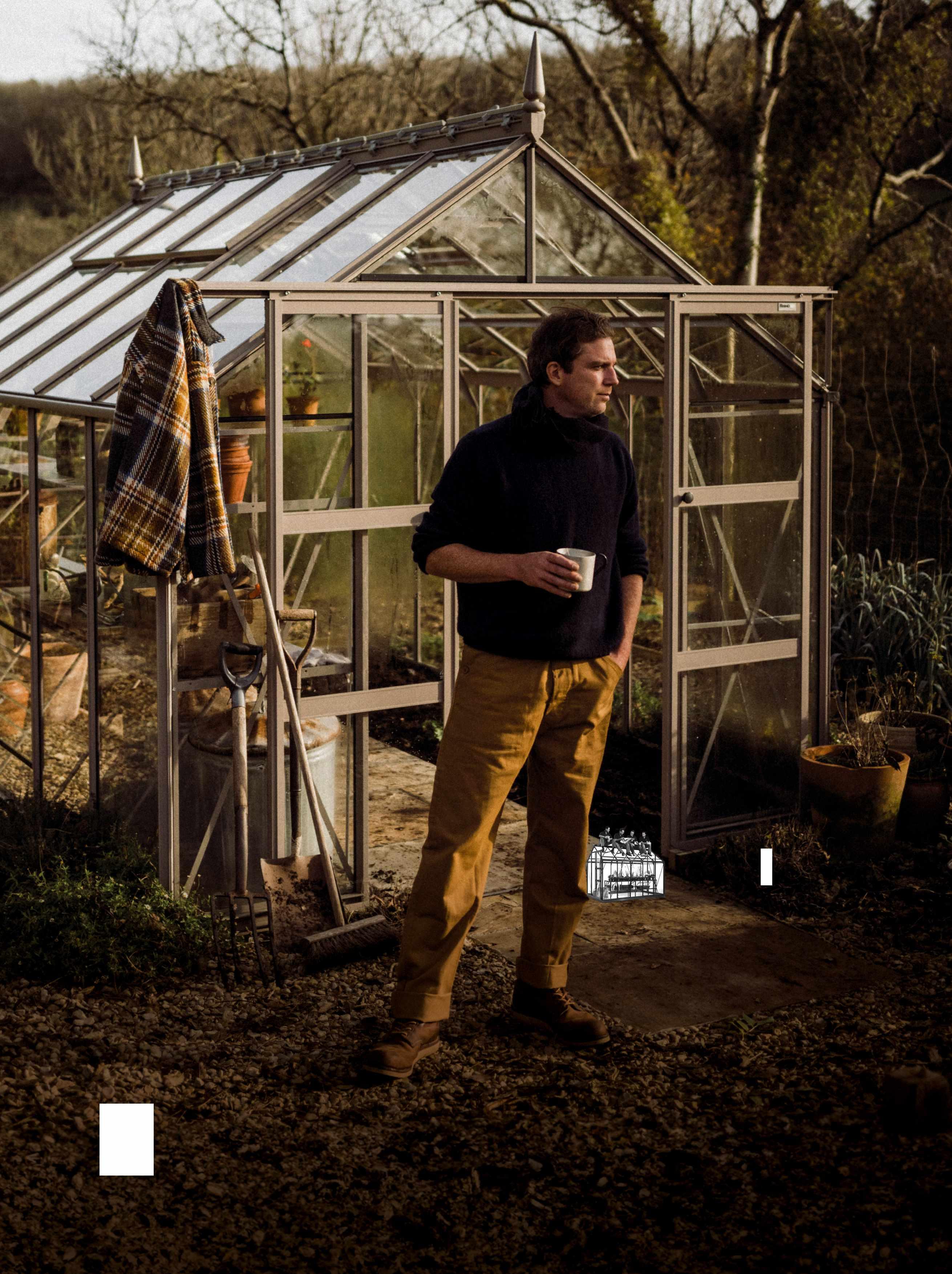

As early spring approaches, gardeners get busy planning all the things they would like to grow this year, so we thought this was the perfect time to create an exciting issue focused on plants and planting. For starters, Fergus Garrett has chosen the ultimate list of his 50 favourite plants (page 20), with the esteemed head gardener of Great Dixter choosing treasures he grows, would love to grow or couldn’t live without.
Award-winning designer Jo Thompson starts her new series on container planting with three simple but beautiful ideas for early spring pots (page 60). We journey to Sparoza in Greece, where a series of remarkable women have carved an experimental dry garden out of a hostile, scrubby hillside, using Mediterranean plants from all over the world (page 42); and to Luisenpark in Germany, to see the work of a maverick of planting design, Harald Sauer (page 66).
This issue we also discover how to create a seeded perennial meadow scheme – a concept developed by proponents like James Hitchmough – with expert advice and the plant list for a late-summer scheme developed exclusively for Gardens Illustrated (page 76).
Plus we find out how one man brought a rare British native plant back from extinction (page 88), and take in a profile of winter aconites (page 52) and a visit to the Shepton Mallet Snowdrop Festival (page 82). Cultural gardener Katy Merrington picks the plant books you need to read (page 101), and to top it all off, we meet Mark Spencer, a botanist with a sideline in solving murders (page 74). It’s a packed special edition all about plants that we really hope you enjoy.


ONLINE THIS MONTH
Find lots more plant inspiration, including snowdrop advice and gardens to visit, on our website: gardensillustrated.com


Instagram @gardens_illustrated Twitter @GdnsIllustrated
@gardensillustrated

42 Tough stuff Home to the Mediterranean Garden Society, Sparoza near Athens mixes drought-tolerant Greek natives with plants from other Mediterranean climate zones
66 Shockofthenew Plantsman Harald Sauer dares to be different with an unconventional, perennial planting scheme for a public park in Germany
82 Snowdrop central For many galanthophiles, there is only one place to head to in early February: the Somerset town of Shepton Mallet
20 Fergus Garrett’s 50 favourite plants Great Dixter’s head gardener selects his most loved 50 plants – from the plants he can’t do without to those he can only dream of growing
52 Plant profile: Eranthis Forget snowdrops; the bright-yellow early flowerers known as winter aconites are the real harbingers of spring. Gardener-botanist John Grimshaw shines a horticultural light on the genus
60 Small pleasures Designer Jo Thompson kicks off a new container-planting series with three spring designs to brighten the dullest of days
76 Aborder from seed Sam Taylor-Hunt guides us through the process of creating a seeded perennial scheme from scratch
88 Back to life At his specialist nursery in Wales, Andrew Shaw rescues rare plants on the verge of extinction
51 Gardening talent Meet Suzi Turner and Moy Fierheller, who job share as deputy head gardeners at Knepp Walled Garden
74 Who’s who The forensic botanist Mark Spencer on using plants to solve crime and tackle declining biodiversity
122 Fond of the frond Alice Vincent on her fascination with ferns
3 Welcome 6 Contributors
9 Dig in The return of Kew’s orchid festival and why we need to fall out of love with Valentine’s Day roses
15 Kittedout With a curated selection of investment buys for the garden that are worth the money
18 Subscription offer Save when you subscribe to the digital edition of Gardens Illustrated
39 Hidden talents Columnist Ken Thompson looks at some of the ways in which plants have adapted to survive and thrive
99 Sourcebook Nine of the best garden seats for two
101 Toptenplantbooks Katy Merrington, cultural gardener at The Hepworth Wakefield, chooses her ultimate library for planting inspiration and plant identification
109 Competition Win a luxury garden break in Cornwall†
119 Crossword and back issues
121 Next issue What’s coming up in our March issue
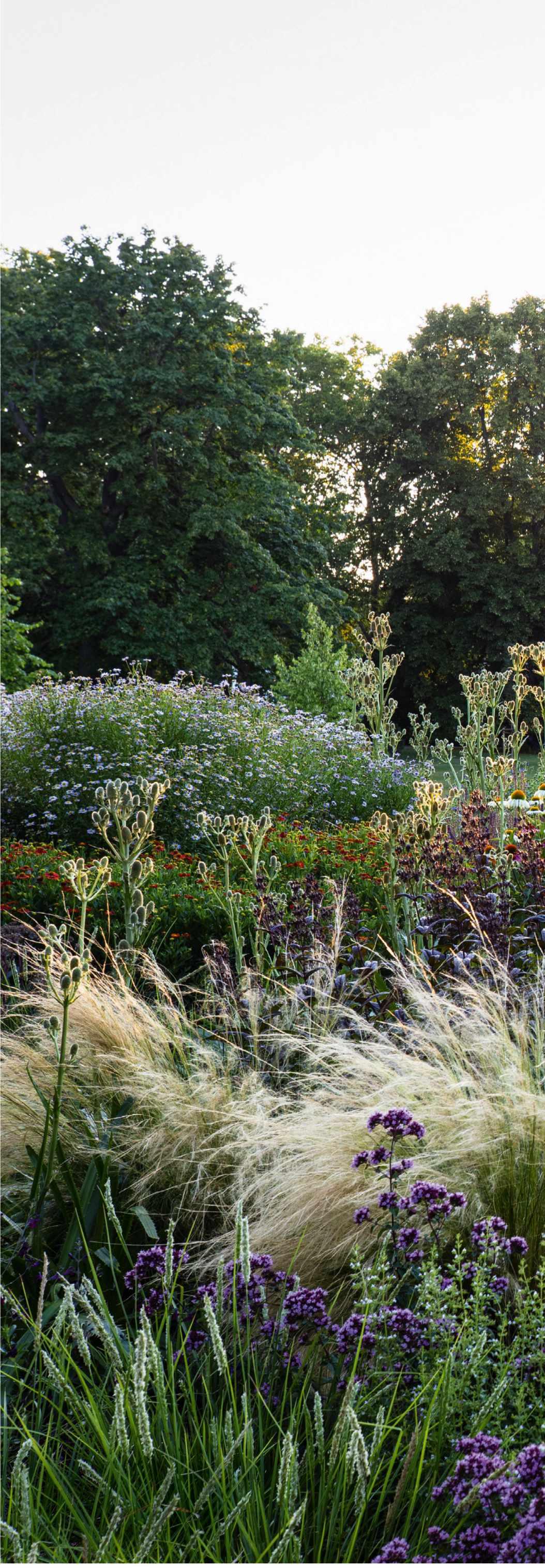
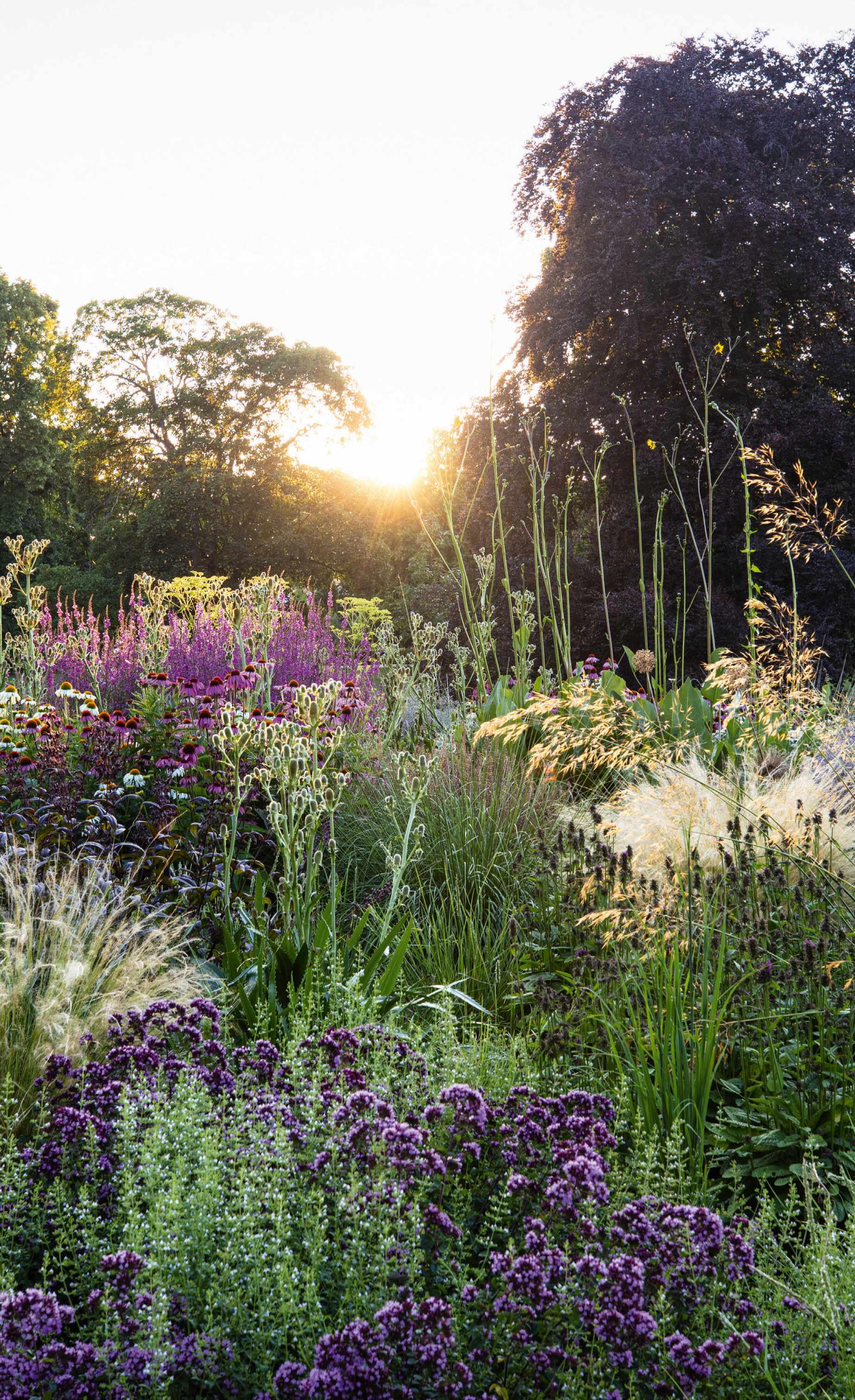
Subscribe & save
take out a digital subscription to Gardens Illustrated SEE PAGE 18
Fritillaria persica, photograph by Richard Bloom (page 20)
Fergus Garrett’s ultimate 50 plants, page 20
February flowers, pages 52 and 82
Designer spring pots, page 60
Dynamic designs, page 66
From scratch, page 76 Back to life, page 88
• Save money when you subscribe to the digital edition of Gardens Illustrated – page 18
• Win a luxury garden break at the Alverton Hotel in Cornwall, worth over £1,000† – page 109
† Competition open to UK readers only
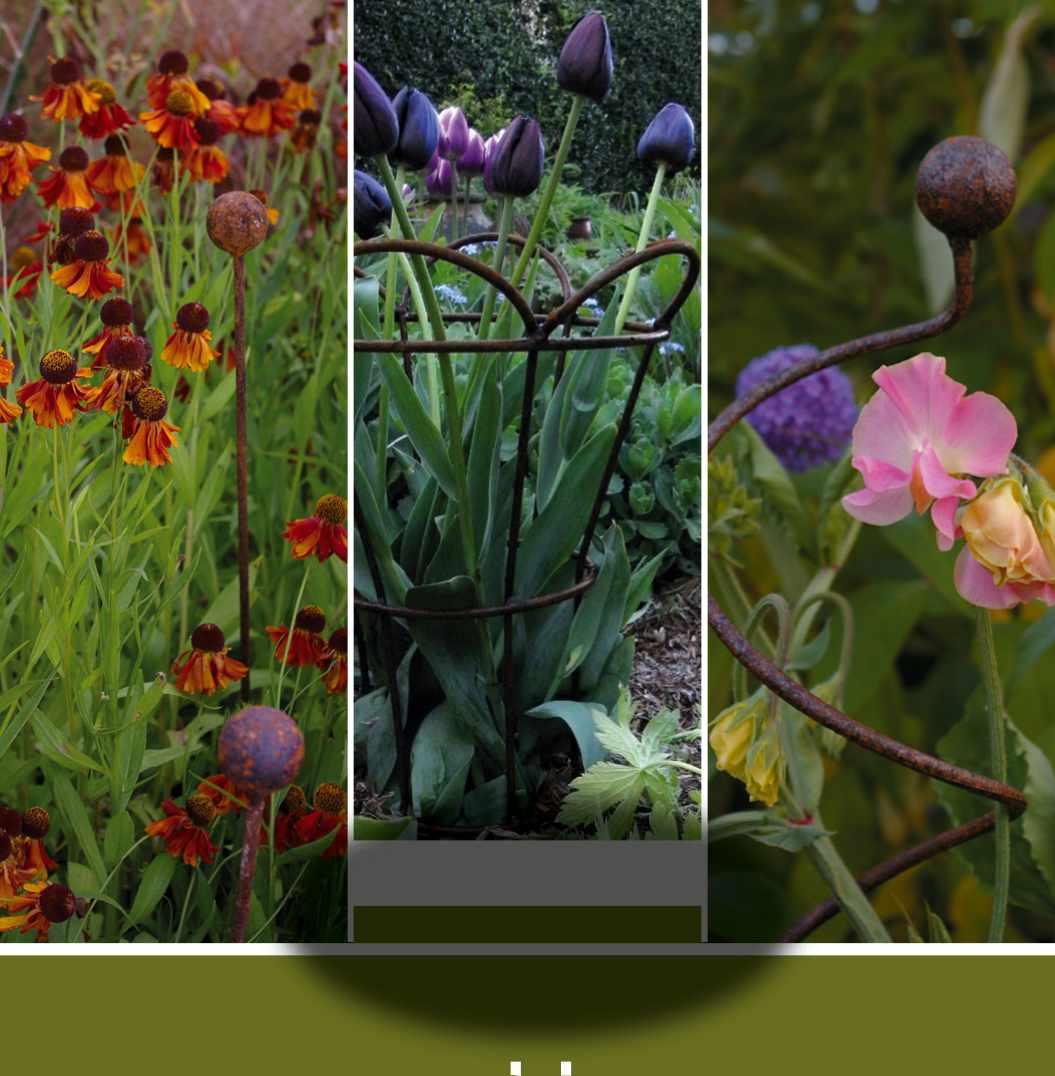



Jo Thompson
Designer Jo starts a new container series, page 60. “Taking a new look at pots and colour through the year, with something for everyone and every budget, has been the dream challenge.”

Hannah McVicar
Hannah illustrates our guide to creating a seeded perennial meadow, page 76. “It was such a delight to bring Sam Taylor-Hunt’s seeded perennial meadow to life with my drawings.”

John Campbell
John photographs an unusual nursery for rare British native plants, page 88.
“Andrew’s passion for these lesser-known wild plants opened my eyes to the need to conserve them.”






Charlotte Harris
Charlotte co-founded the values-driven landscape design practice Harris Bugg Studio with Hugo Bugg in 2017. She has won three Gold medals at the RHS Chelsea Flower Show, as well as Best Show Garden in 2023.
Fergus Garrett
Fergus was appointed head gardener at Great Dixter by Christopher Lloyd in 1993 and is now CEO of the garden’s Charitable Trust. He was awarded an RHS Associate of Honour in 2008 and an RHS Victoria Medal of Honour in 2019.
James Basson
James lives in the South of France where he runs Scape Design, a practice for creating sustainable landscapes. The winner of four Chelsea Gold medals, he was awarded Best Show Garden in 2017.
Anna Pavord
Anna was The Independent’s gardening correspondent for 30 years and is the author of the bestselling book The Tulip. In 2000 the RHS awarded her the Veitch Memorial Medal. She lives and gardens in Dorset.
Dan Pearson
Dan is one of the UK’s best-known garden designers. Among his many award-winning gardens is the Tokachi Millennium Forest in Japan. He was awarded an OBE in the 2022 New Year Honours for services to horticulture.
Sarah Price
Sarah is one of the UK’s most sought-after garden designers. She won Gold at Chelsea in 2012, 2018 and 2023, and was GMG Garden Columnist of the Year in 2016 for her design series in Gardens Illustrated
Membership and subscription enquiries and back issues
UK 03330 162114
USA/CANADA +1 888-941-5623 (TOLL-FREE)
REST OF THE WORLD +44 1604 973722
EMAIL gardensillustrated@ourmediashop.com
UK/REST OF THE WORLD Gardens Illustrated, PO Box 3320, 3 Queensbridge, Northampton NN4 7BF. USA/CANADA Gardens Illustrated, PO Box 40, Williamsport, PA 17703 USA.
Advertising enquiries
+44 (0)117 300 8547 rebecca.janyshiwksyj@ourmedia.co.uk
Editorial enquiries
+44 (0)117 300 8622 gardens@gardensillustrated.com
Gardens Illustrated, Our Media Ltd, Eagle House, Bristol BS1 4ST.
Syndication & Licensing
Gardens Illustrated is available for licensing and syndication. +44 (0)117 300 8787, emma.brunt@ourmedia.co.uk
App support
For App support please visit ourmediaapps.co.uk/digital-contact-form/
We abide by IPSO’s rules and regulations. To give feedback about our magazines, please visit ourmedia.co.uk, email editorial.complaints@ourmedia.co.uk, or write to: Legal, Our Media Ltd, Eagle House, Bristol BS1 4ST.
EDITORIAL
Editor Stephanie Mahon
Art director David Grenham
Deputy art editor Niki Goss
Production editor Juliet Giles
Digital editor Daisy Bowie-Sell
Commissioning content editor Veronica Peerless
Content producer Molly Blair
Botanical adviser Dr James Compton
Thanks this issue Hilary Brown
ADVERTISING
Sales director Laura Jones 0117 300 8509 laura.jones@ourmedia.co.uk
Advertising manager Rebecca Janyshiwskyj 0117 300 8547 rebecca.janyshiwksyj@ourmedia.co.uk
Commercial brand lead Kelly Warden 0117 300 8538 kelly.warden@ourmedia.co.uk
Advertising designer Camilla Owen
INSERTS
Laurence Robertson +353 (0)876 902208
CIRCULATION, MARKETING, PROMOTIONS, PRESS & PR
Newstrade manager John Lawton
Subscriptions director Jacky Perales-Morris
Direct marketing manager Aimee Rhymer
Buyer Karen Flannigan
MANAGEMENT
Chief executive officer Andy Marshall
Managing director Andrew Davies
Head of brand marketing and brand lead Rosa Sherwood
SYNDICATION & LICENSING
Director of licensing & syndication Tim Hudson, tim.hudson@immediate.co.uk
Head of licensing Tom Shaw, tom.shaw@immediate.co.uk
Head of syndication Richard Bentley, richard.bentley@immediate.co.uk
PRODUCTION
Production director Sarah Powell
Group production manager Louisa Molter
Production co-ordinator Lauren Morris







NEWS COMPILED BY MOLLY BLAIR

You can find plenty more events to enjoy by going to our online diary. Scan this QR code with your phone camera or go to gardensillustrated.com/ gardenevents
Kew’s annual orchid festival returns to the Princess of Wales Conservatory from 3 February to 3 March. The conservatory will be filled with installations showcasing orchids and the amazing biodiversity of Madagascar. From spiny forests to succulent woodlands, visitors will be treated to a huge horticultural display alongside some of the Malagasy orchids that are cared for at Royal Botanic Gardens, Kew. Entry included with a garden ticket; slots must be booked. More information at kew.org
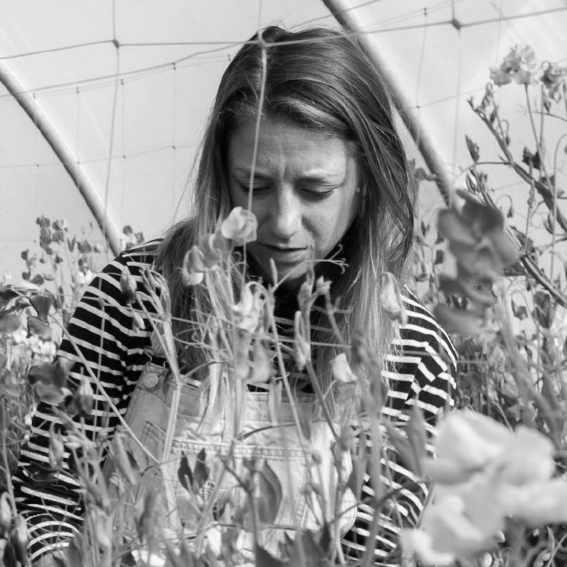
Valentine’s Day is synonymous with red roses, but the Spring Summer Autumn Winter Collective (SSAW) has been campaigning for years to turn this tradition upside down and promote a more considered approach to gifting flowers in winter. “There is nothing seasonal about a rose in February,” says Jessica Blume (above), one of the SSAW co-founders. “We expect the first flush of flowers between late May and early June – if we’re lucky a second in August to September. February is clearly no time for roses in bloom – not here, nor in most parts of the world. So why buy roses in February?” Roses grown for Valentine’s Day require large amounts of water and energy from greenhouse heating. Pesticide runoff is also an issue – as flowers are not consumables, regulations on pesticide use are much less stringent. An estimated eight million roses (570 tonnes) are imported to the UK for Valentine’s Day – that’s a big environmental impact. To arrive fit for use, flowers often need to be flown and trucked while refrigerated. “It is said that for every day a flower spends travelling it loses 15 per cent of its value,” says Jessica. So this year, consider buying something seasonal, such as hellebores, narcissi or hyacinths, or even a bareroot rose, at the natural point in its yearly cycle, that you can watch grow for years to come.
To read more about why roses aren’t so romantic in February and for ideas on other flowers to buy instead, head to gardensillustrated.com/ valentinesroses


Clematis Sea Breeze (= ‘Zo09063’).

Clematis ‘Hagley Hybrid’.
Clematis Diamantina (= ‘Evipo039’).
Taylors Clematis, popular grower of climbing plants, has been acquired by Sarah Raven. Featuring more than 100 clematis cultivars, including Clematis ‘Hagley Hybrid’ (£16.95) and Clematis ‘Huldine’ (£18.95), the range can now be found at Sarah Raven alongside pots, tools and a range of other plants. sarahraven.com
Clematis ‘Huldine’.


Blenheim Palace and Estate is home to the greatest number of ancient oak trees in Europe and is safeguarding the future of the collection with an extensive tree-growing initiative. Last year, the estate forestry team collected over 20,000 acorns as well as more than 50,000 seedlings from 20 other native species of tree, including cherry, walnut and beech. Saplings planted out in the parkland in 2016 are now around half a metre tall, and it is hoped that the programme will enhance the estate and contribute to a healthier environment. See the ancient oaks for yourself by booking a visit at blenheimpalace.com
Italian studio Stefano Boeri Architetti has designed a new centre for prayer, meditation and peace at a sacred Buddhist site in Nepal. Ramagrama Stupa, an archaeological burial site crowned by a hill and an ancient tree, still houses an intact portion of the relics of the Buddha and is one of the most important historical, religious and cultural sites for Buddhism. Buddhist communities and other cultural organisations have committed to preserving and enhancing the space. The masterplan includes two giant gardens: a Peace Meadow for contemplation, with a ground design that recalls the mandala symbol; as well as a Biodiversity Ring, which will host 80,000 plants of 70 different local species. For more information, visit stefanoboeriarchitetti.net
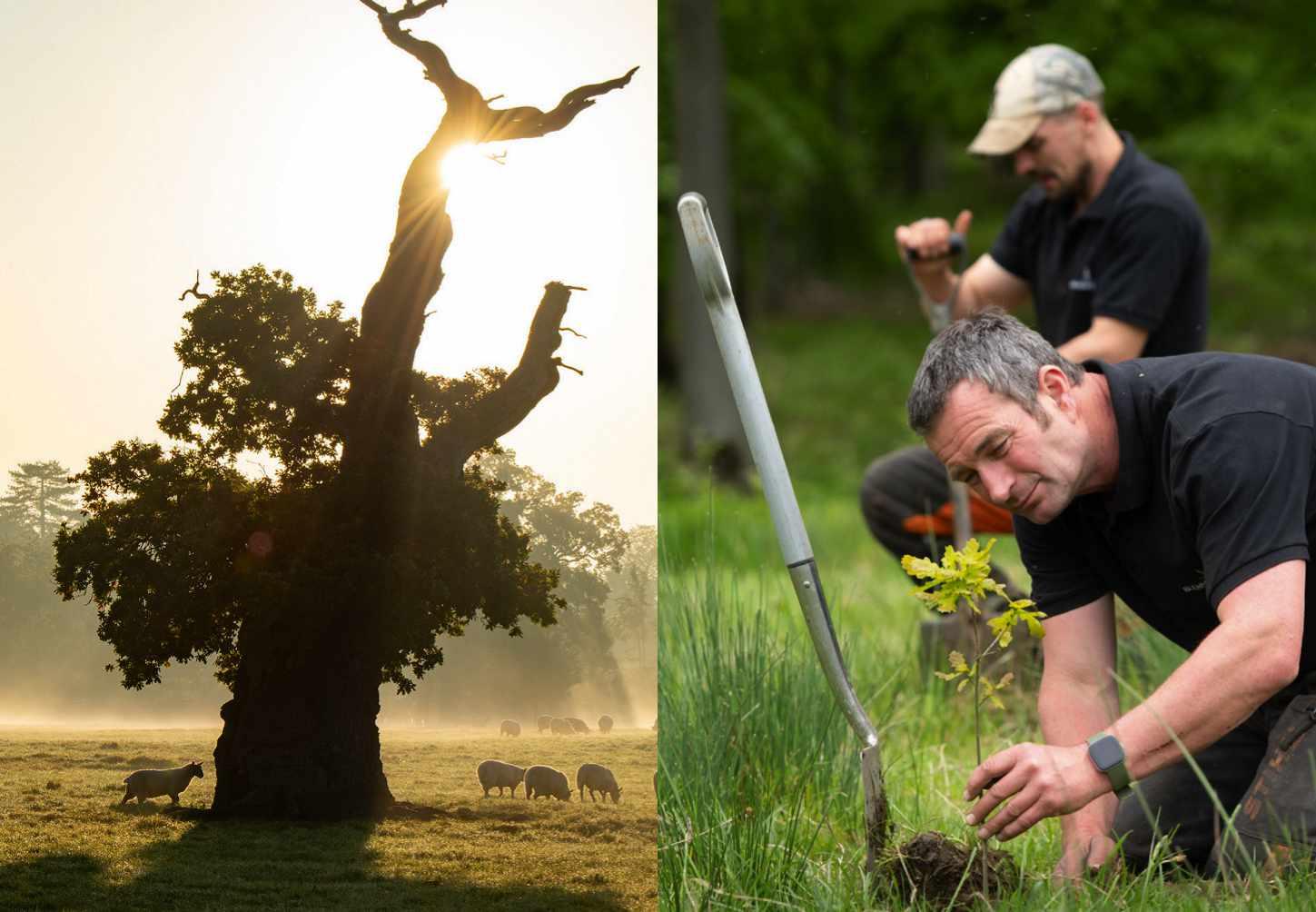
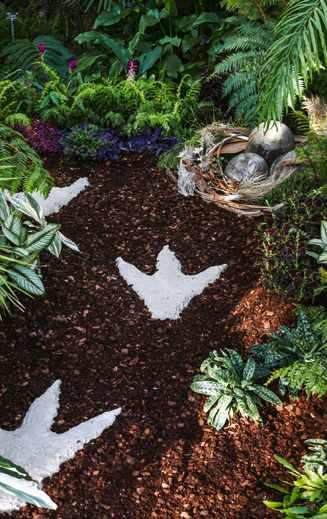
3
Plants Before Time Visit Wisley to discover fascinating houseplants among fossils and footprints. Saturday 3 February – Sunday 10 March, 10am-3.45pm (opens 9.30am weekends). RHS Garden Wisley, Woking, Surrey GU23 6QB. rhs.org.uk
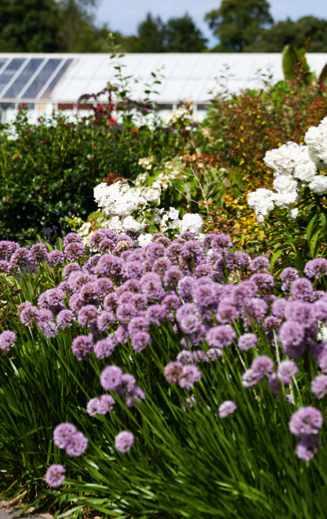
6
Herbalist Walk, Talk and Tea Dive into the world of medicinal plants and their healing properties with an expert herbalist. Tuesday 6 February, 11am-12.30pm. £15. One Garden Brighton, Stanmer Park, Lewes Road, Brighton, East Sussex BN1 9SE. onegardenbrighton.com
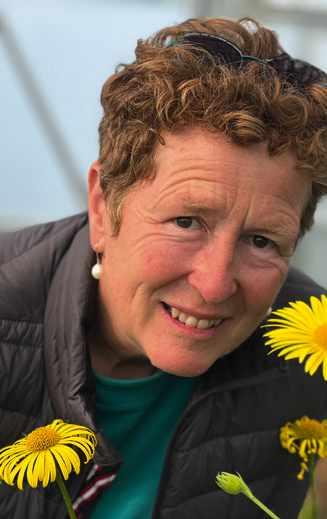
28
Early Flowering Perennials with Rosy Hardy A talk on the attributes of 24 early flowering perennials. Wednesday 28 February, 10.30am-12.30pm. £22.50. Hardy’s Cottage Garden Plants, Whitchurch, Hampshire RG28 7FA. hardysplants.co.uk

The Generous Gardener has announced a new programme of lectures for this year with a range of fascinating speakers. The first lecture day, on 7 March, will see talks from Troy Scott Smith on the history, care and cultivation of roses, followed by an afternoon lecture from Charlotte Harris and Hugo Bugg of Harris Bugg Studio on respecting the spirit of a place when designing a garden. Nick Macer, Marian Boswall, Polly Nicholson, Jamie Butterworth, Kate Stuart-Smith, Arthur Parkinson and Andy Sturgeon are all on the bill for lectures later in the year. Each day costs £135 and will be held at the historic Arts and Crafts Manor House at Rodmarton with refreshments and a two-course lunch included. For more information and to book, head to thegenerousgardener.co.uk

Plankbridge, the UK-based maker of a range of shepherd’s huts, has released its take on a ‘tiny house’. The Sixpenny Hut House is based on the design of a Dutch barn near the village of Sixpenny Handley in Dorset. The two-storey space includes a fully fitted kitchen, loft bedroom and ensuite bathroom as well many space-saving storage solutions. The Sixpenny Hut House costs £95,000 and more information can be found at plankbridge.com
Garden designer Zoe Claymore has collaborated with garden product creators LuxUnique to launch a new line of galvanised steel planters. Initially created as bespoke beds for The Wildlife Trusts’ Renter’s Retreat ‘Get Started’ garden at RHS Hampton Court 2023, the planters are now available for purchase. Each planter in The Hampton Collection is made to order and comes with a ten-year guarantee. Prices start at £250 and there are 30 size options. For more information and to order visit luxunique.co.uk

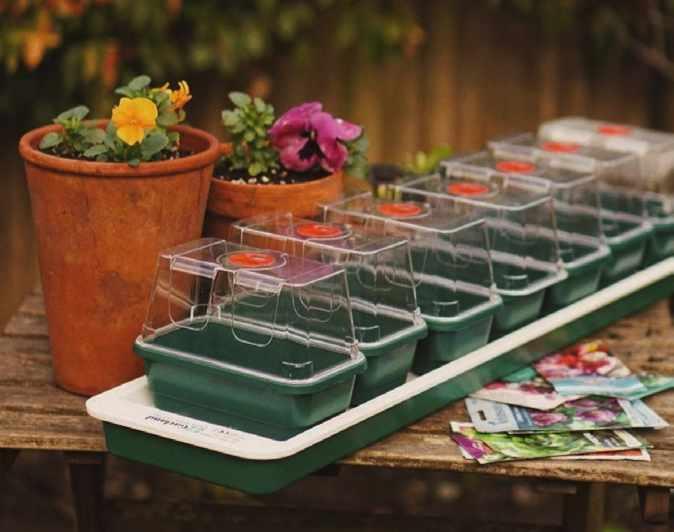
WINDOWSILL GROWING
Super 7 Propagator, £47.95, Harrod Horticultural, harrodhorticultural.com
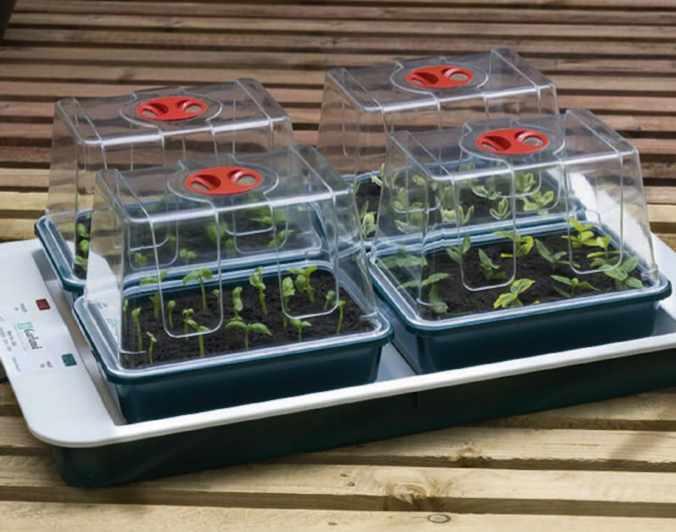
INDIVIDUAL TRAYS
Four Top Electric Propagator, £55.95, Mr Fothergill’s, mr-fothergills.co.uk
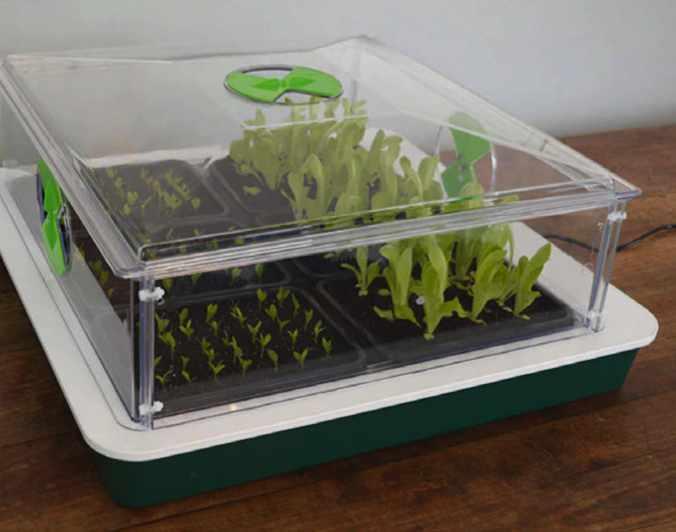
INNOVATIVE DESIGN
Large Vitopod Propagator, £357, Two Wests, twowests.co.uk

To find a wider selection of propagators scan the QR code with your phone camera, or visit gardensillustrated.com/ propagators



COMPILED BY MOLLY BLAIR



5200,
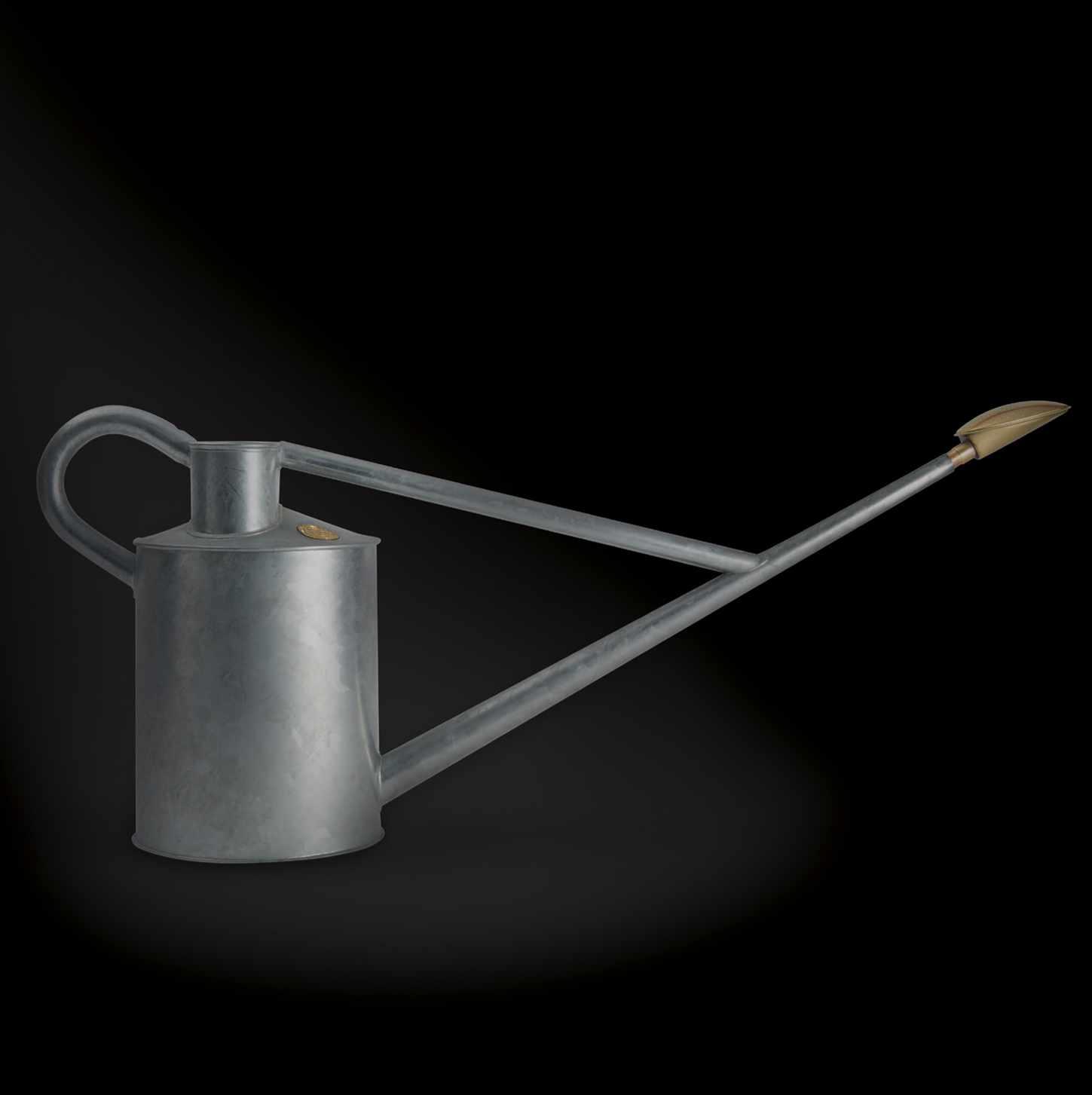


7





1. The Warley Fall Hot Dipped Galvanised Watering Can, two gallon, £150, 0121 420 2494, haws.co.uk 2. Conic Planter, H 1.2m x Ø 1m, £879, 01243 967958, shop.andystedmandesign.com 3. Hori Hori Knife Deluxe & Leather Holster, £40, 01243 967958, shop.andystedmandesign.com 4. Farmer-Florist Tool Belt, brown, right-handed, $217.95, shop.floretflowers.com 5. Burgon & Ball Dig The Glove Gardening Gloves, denim, £18, 0344 567 8365, farrar-tanner.co.uk 6. Sneeboer Border Fork, £139.95, and Sneeboer Border Spade, £140.95, 0333 400 1500, harrodhorticultural.com 7. Thick Canvas Waxed Apron, navy, £84.95, 0345 605 2505, worm.co.uk 8. Taira Shears, £359, 01747 445059, niwaki.com 9. L’Alliance Neo Waterproof Boots, designed in partnership with Fairfax & Favor, navy, £295, 01572 772444, lechameau.com



At Elite Garden Studios, we believe that your garden is more than just outdoor space; it’s an opportunity to cultivate something extraordinary. Nestled within nature’s embrace, our garden rooms are more than structures; they are the canvas for your imagination, the sanctuary of your dreams, and the embodiment of refined living.
TEENAGE
Save when you subscribe to the digital edition

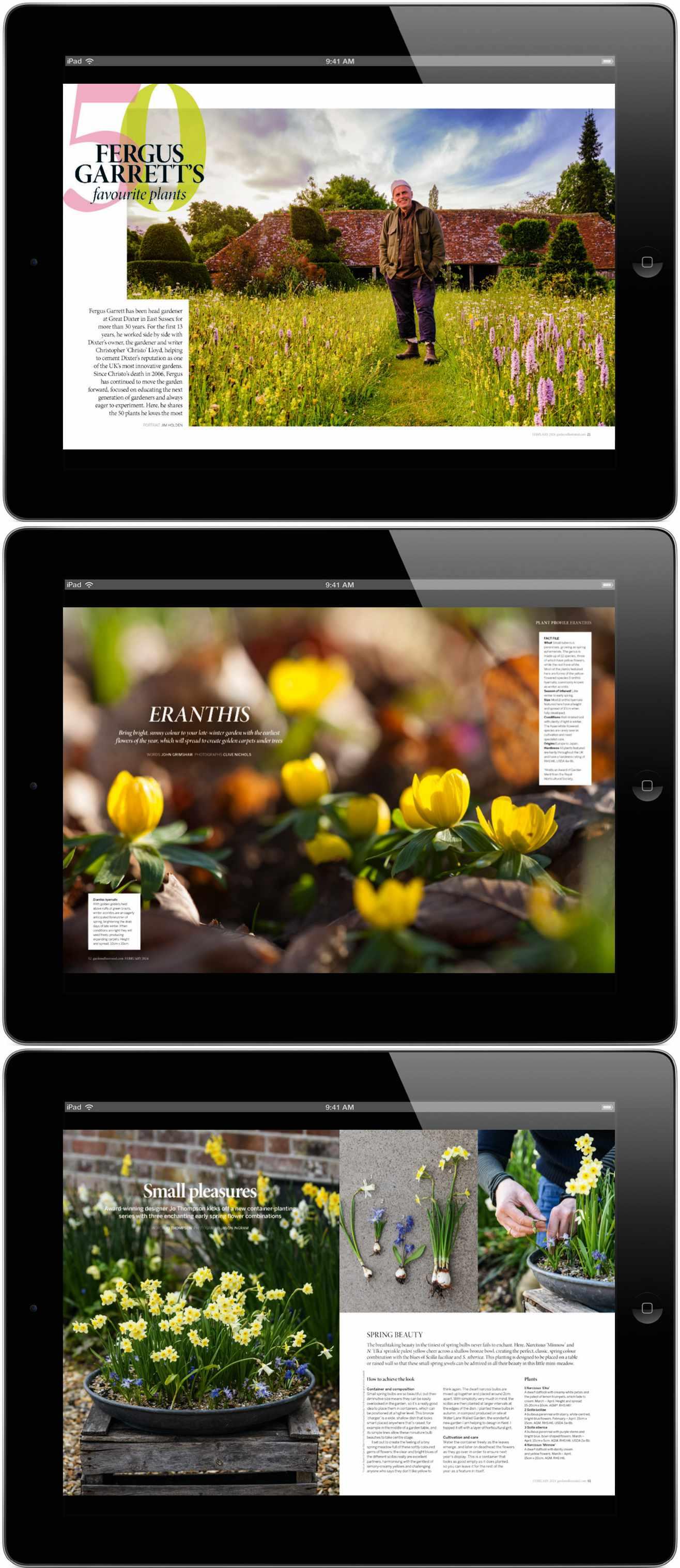



Fergus Garrett has been head gardener at Great Dixter in East Sussex for more than 30 years. For the first 13 years, he worked side by side with Dixter’s owner, the gardener and writer Christopher ‘Christo’ Lloyd, helping to cement Dixter’s reputation as one of the UK’s most innovative gardens. Since Christo’s death in 2006, Fergus has continued to move the garden forward, focused on educating the next generation of gardeners and always eager to experiment. Here, he shares the 50 plants he loves the most
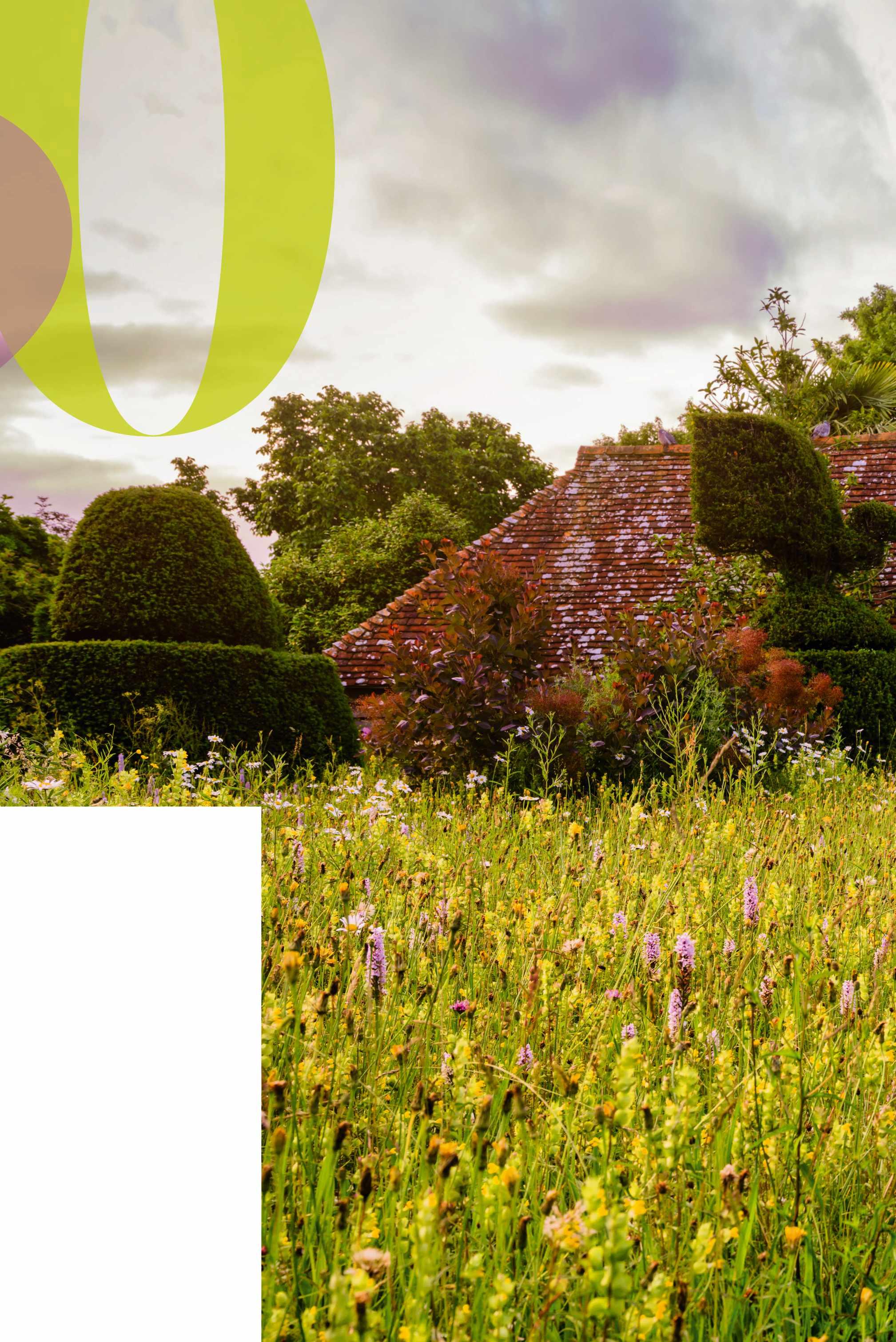
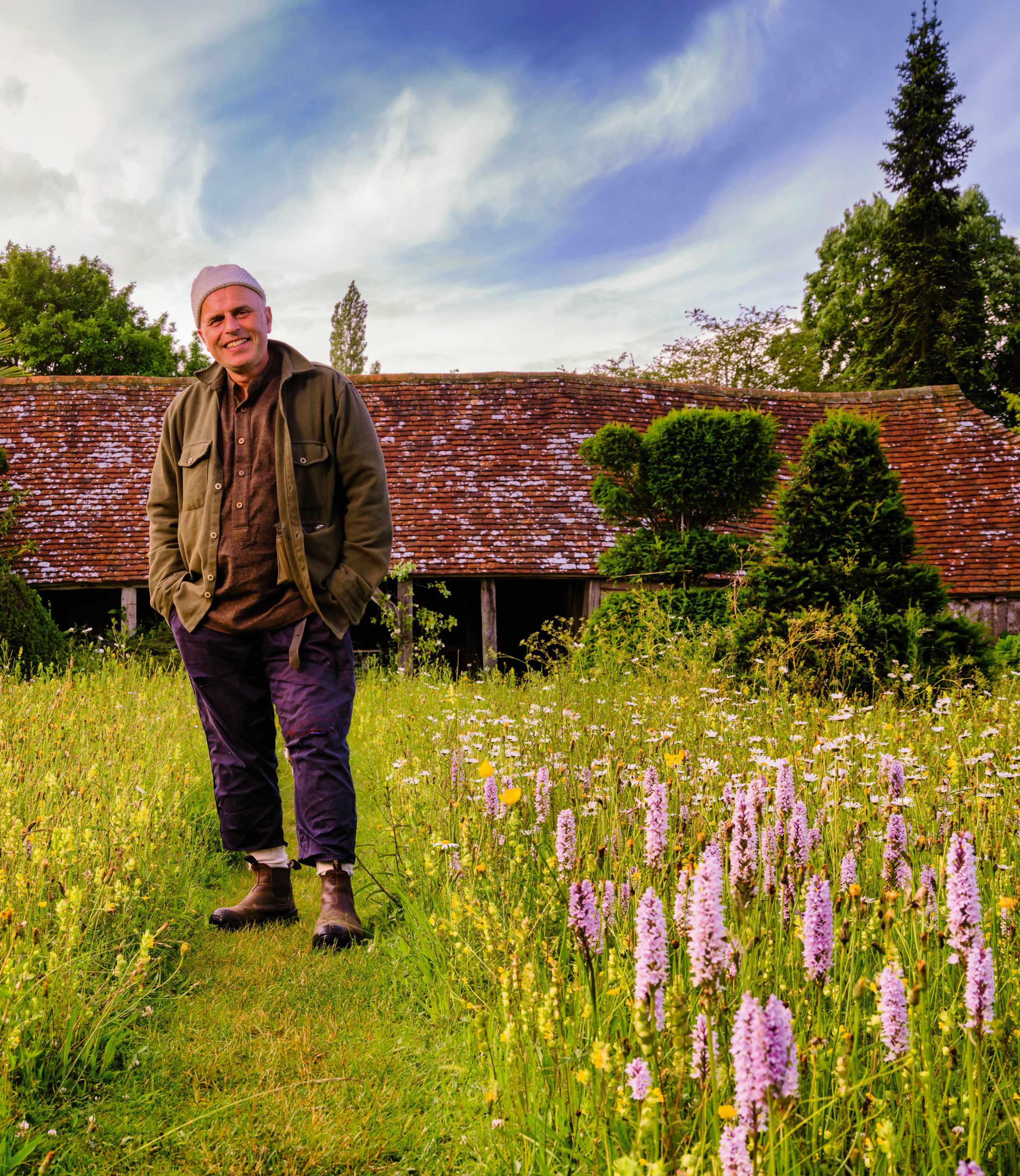
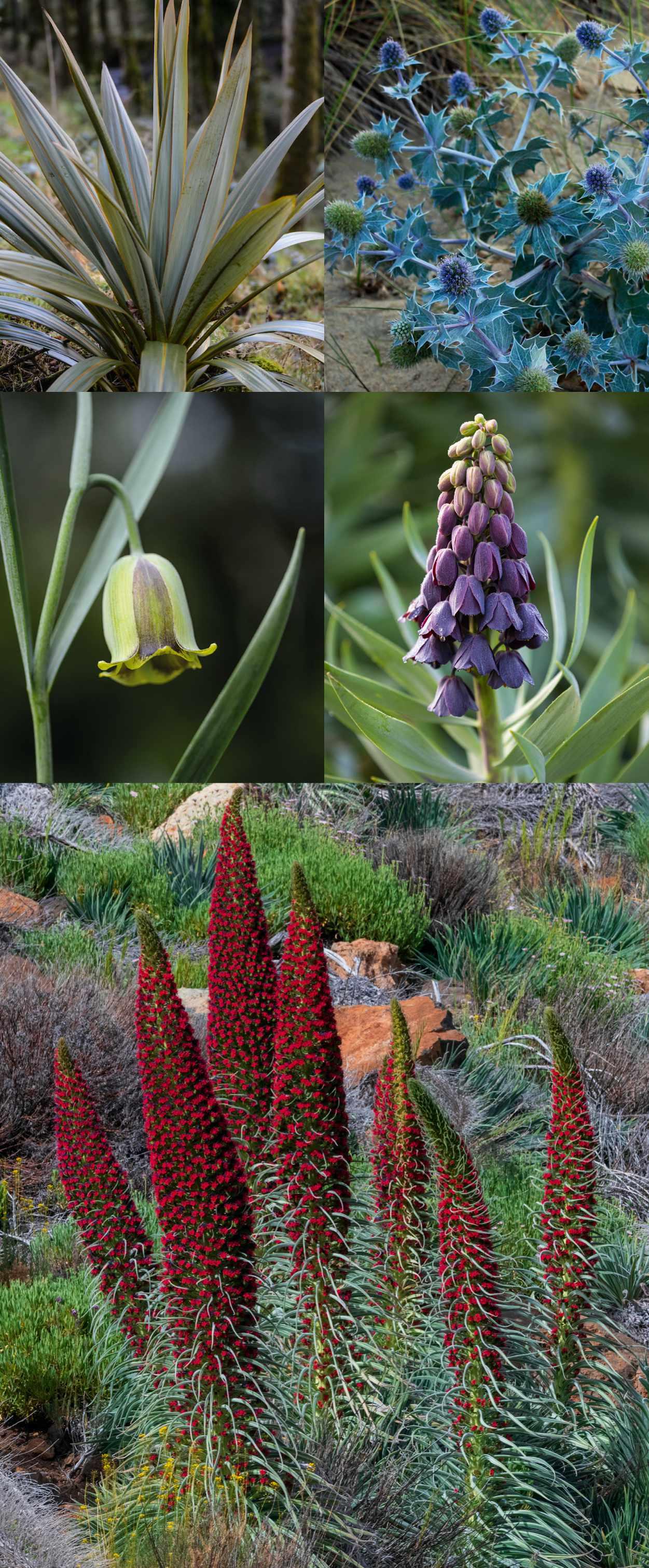
Every gardener should dream – these are some of the plants I fantasise about but cannot quite grow.
1 AGAVE ATTENUATA
The foxtail agave makes bold succulent rosettes of glaucous aqua-green foliage. Long and curved flower spikes with greenish yellow flowers are produced from the largest rosettes. Spineless leaves, a strong structure, zany flower spikes and the willingness to flower make this a plant to drool over. I must try it again on the coast in Hastings where it may get through the winters. Height (H) 3m. Spread (S) 70cm. Plant type (PT) Perennial succulent. Conditions (C) Well-drained sand or clay; full sun. Needs a sheltered position ideally west- or south-facing. Season of interest (SI) Foliage: year round; flowers: spring – summer. Hardiness rating (HR) RHS H1C, USDA 10a-12†
2 CORDYLINE INDIVISA
The most dramatic of all the cordylines, with bigger and more striking foliage. A New Zealand endemic, the leaves have a blue-green tinge, are shaped like a broad sword with a distinctive midrib, and can be more than a metre long. A dramatic punctuation point for your borders. Will self-seed in the mildest areas and is especially good in coastal gardens. H 3m. S 2m. PT Tree. C Moist, fertile, organically rich, welldrained soils; part shade. SI Year round. HR RHS H2, USDA 9a-11.
3 ECHIUM WILDPRETII
Endemic to the Canary Isles, this is a tall and striking monocarpic bugloss, producing a robust spire peppered with fiery brick-red flowers. The first-year rosettes are attractive, with lance-like, pale grey-green leaves. Hairy throughout, this is a plant that is stunning at all stages of its life. Will self-seed if it likes you and is good on the coast. H 3m. S 40cm. PT Biennial C Well-drained soils; full sun. Thrives in arid and dry conditions. In its native habitat, it typically grows in rocky and volcanically soiled slopes in cool summers. SI Flowers May to June. HR RHS H2, USDA 9a-11.
4 ERYNGIUM MARITIMUM
In my 40 years of gardening, I have tried this several times and failed every time – probably because most of my life has been on clay. Slightly on the succulent side, it is a small yet highly architectural plant, intensely glaucous, stiff and spiny all over with distinct sea holly flowers, tinged blue, surrounded with spiny bracts. H 50cm. S 30cm. PT Perennial C Well-drained soil, preferably sandy; full sun. SI Flowers: spring – summer. HR RHS H5, USDA 5a-8b.
5 FRITILLARIA ACMOPETALA
Elegant stems with whorls of narrow, grey-green leaves carry long, pendulous, bell-shaped flowers in April. The flowers have six tepals, the outer three of which are a golden green, blushed with a greyish bloom, and the inner ones are marked with purple and brown. Found in Turkey through to Palestine growing in open maquis. AGM*. H 60cm. S 20cm. PT Bulb C Rich, well-drained soil; full sun. SI April. HR RHS H4, USDA 5a-8b.
6 FRITILLARIA PERSICA
Success with this robust bulbous perennial, from the rocky parts of the Middle East, is elusive to most gardeners – flowering one year and then going blind the next. Each plant has more than 30 deep-purple – almost-black – bell-shaped flowers, evenly spaced out on a glaucous green body of an upright stem with narrow twisted leaves. H 70cm. S 30cm. PT Bulb C Well-drained soil; full sun. SI Flowers: April – May. HR RHS H4, USDA 5a-8b.
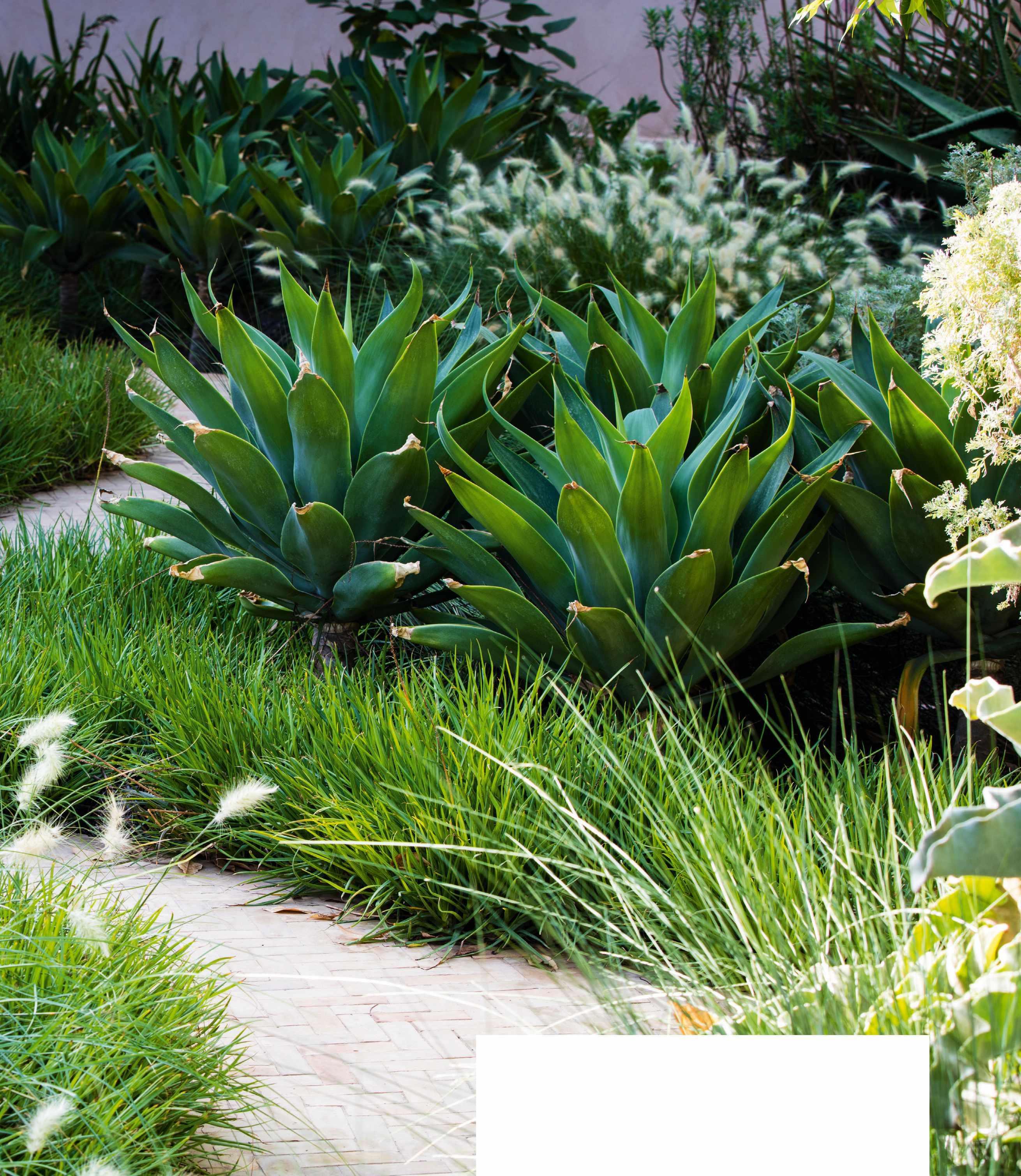
Spineless leaves, a strong structure, zany flower spikes and the willingness to flower make Agave attenuata a plant to drool over

Clematis rehderiana is a freeflowering species with masses of delicate pale-yellow, cowslip- scented flowers in autumn 12
7 HERACLEUM VILLOSUM
Previously known as Heracleum stevenii, this spectacular perennial hogweed from Crimea has coarsely lobed, grey-green leaves making a large mound from which arise a multitude of broad, cow parsleylike inflorescences carrying a complex arrangement of white flowers. Will seed if it likes you. The sap will burn you like other hogweeds. H 1.5m. S 1.5m. PT Perennial C Rich, moist, well-drained soil; full sun. SI Spring – summer. HR RHS H4, USDA 5a-8b.
8 WIGANDIA URENS
I tried this at Dixter many years ago and lost it. It needs heat – you see it growing out of walls in the South of France. Native to Central America and northern South America, it is a tall, imposing plant with large clusters of mauve flowers during the summer, on stiff stems, with large oval-shaped, dark-green leaves. Can cause dermatitis, but worth it, as it’s spectacular. H 3m. S 1m. PT Shrub. C Well-drained soil; full sun to part shade. SI Year round with dramatic foliage. Flowers in summer. HR RHS H2, USDA 8b-10a.
9 ZOSIMA ABSINTHIIFOLIA
A plant of aliens. Squat, dome-shaped umbel with finely cut greygreen foliage and huge white lacey plates for flowers. I’ve germinated and grown it, dreaming of plants nearly 1m wide, but the wet winters and summers and cold clay in East Sussex didn’t match the hot dry summers and ferociously cold winters of Turkey where I first saw it. Monocarpic. H 40cm. S 80cm. PT Perennial C Welldrained soil; full sun. SI March – April. HR RHS H7, USDA 3a-7b.
These are the plants that stop me in my tracks – I love them for their architecture and impact.
10 BESCHORNERIA YUCCOIDES
A yucca-like plant that has a little more swagger. It is armed with bluish-grey, sword-shaped leaves ending in a reflexed point. Makes a striking punctuation. In April and May, the largest rosettes push up dramatic, arching, coral-pink stems, bearing nodding green flowers. The flowering rosettes die, giving way to offsets, which take several years before reaching maturity and flowering. Hardy in the mildest areas. H 2m. S 1m. PT Perennial C Well-drained soil; full sun. SI Spring. HR RHS H3, USDA 9a-11.
11 BOEHMERIA PLATANIFOLIA
A hardy, herbaceous perennial with multiple stems carrying serrated, green, sycamore-shaped, nettle-like leaves covered in minute hairs. A non-stinging member of the nettle family from Japan, it makes a distinct presence in the border. The flowers are small and insignificant, creamy white, and borne in tight drooping tassels towards the end of the summer. Best in semi-shade. H 1.5m.
S 1m. PT Perennial C Moist but well-drained soil; part shade. SI Spring – autumn. HR RHS H4, USDA 5a-8b.
12 CLEMATIS REHDERIANA
A free-flowering species from China and Nepal with coarsely textured leaves and masses of small, nodding, delicate, pale-yellow, cowslip-scented flowers in autumn. Can be pruned back hard in winter or early spring to grow and flower again the following summer. Needs a substantial host or structure to support it. AGM. H 4m. S 2m. PT Climber C Fertile, well-drained soil; full sun to part shade. SI September – October. HR RHS H5, USDA 6a-9b.
13 CRATAEGUS PENTAGYNA
An elegant, small hawthorn with a splaying, rangy habit and widely spaced branches. Has handsome lobed leaves, greyish in colour.

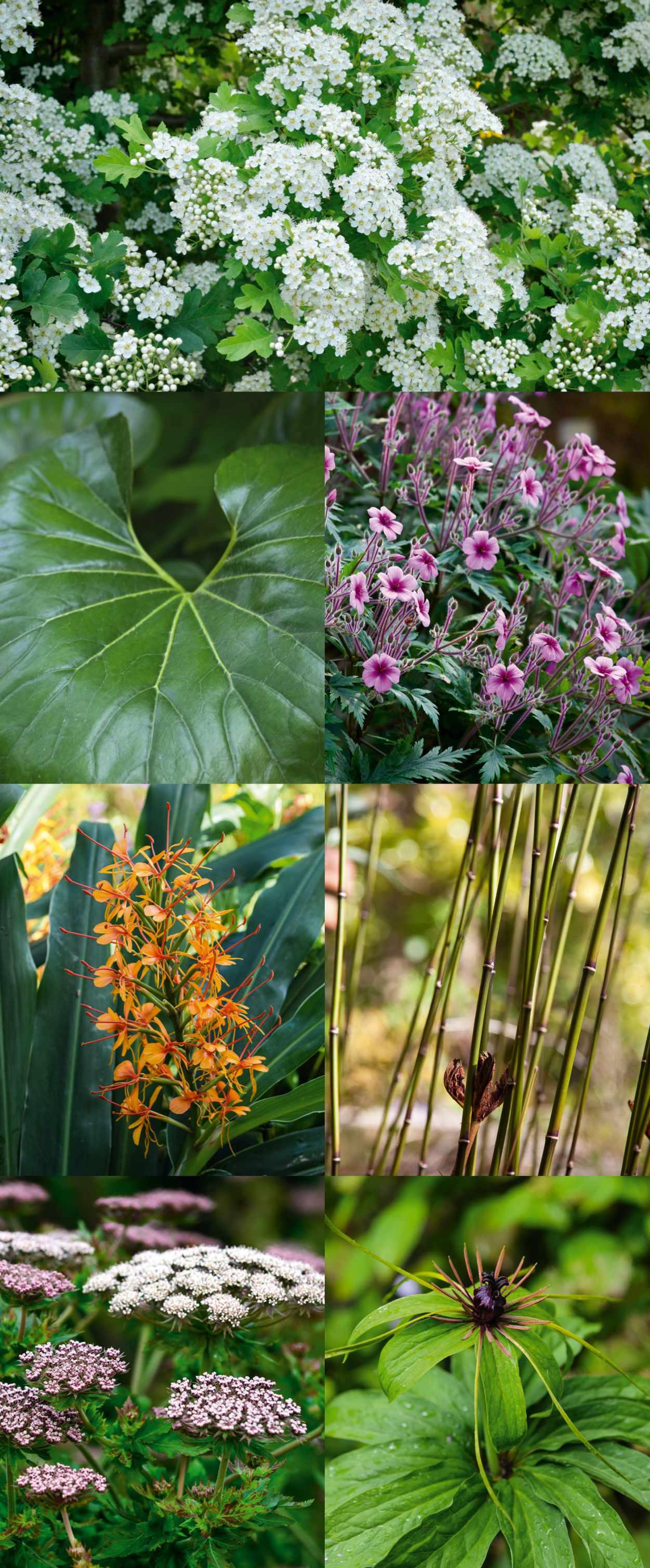
Large, creamy-white flowers fill the plant’s long limbs in May and June, followed by shiny purplish-black fruit. Adored by flying insects, making it the centre of attention when in bloom. H 3m. S 4m. PT Tree C Tolerant of a wide range of soils; full sun to part shade. SI Blossom: May – June; fruit: autumn. HR RHS H7, USDA 4a-7b.
14 FARFUGIUM JAPONICUM
Native to the streams and shores of China, Korea and Japan with dramatic kidney-shaped, deeply glossy green leaves. Makes mounds of bold, shiny foliage, lighting up the darkest corners. In late summer, the clumps are decorated with sprays of deep-yellow daisies. The form ‘Giganteum’ has bigger leaves. Not completely hardy except in the south. H 50cm. S 60cm. PT Perennial C Best in soil rich with organic matter; tolerant of dry shade. SI Foliage: year round; flowers: autumn – winter. HR RHS H3, USDA 9a-11.
15 FERULA COMMUNIS
Great Dixter’s signature plant. Huge plumes of finely cut green foliage emerge in December. Colossal stems covered in a glaucous bloom erupt from the centre in April, reaching 4m high, with widely spaced branches carrying lime-green umbels in May and June. Seedlings are variable and hybrids give mammoth plants. Loved by all insects. H 4m. S 1m. PT Perennial C Well-drained soil; full sun. SI June – July. HR RHS H4, USDA 6a-9b.
16 GERANIUM MADERENSE
Native to Madeira, this tender geranium is huge with large, herb robert-like leaves held on stiff, fleshy stems. It makes a rounded mass of foliage, from which emerge large panicles carrying a profusion of rich pink flowers on hairy stems. The old leaf petioles dig themselves into the soil, holding the plant upright. Dies after flowering and setting seed. Not hardy except in the most sheltered spot. AGM. H 1.5m. S 1m. PT Monocarpic herb. C Well-drained soil; full sun. SI Foliage: year round; flowers April – June. HR RHS H2, USDA 9a-11.
17 HEDYCHIUM ‘TARA’
Terminal clusters of fragrant, richly exotic, orange flowers are densely packed in racemes and decorated with prominent stamens. Dies down in winter to underground rhizomes that are best protected with a deep mulch, unless you’re in a mild climate. AGM. H 2m. S 60cm. PT Perennial C Moist but well-drained, humus-rich soil; full sun to part shade. SI July – November. HR RHS H4, USDA 8a-11.
18 HIMALAYACALAMUS FALCONERI
The most graceful of all the bamboos, with thin, olive-green canes flushing charcoal at each node; naked in their first year, fully furnished with slender green leaves in the second. The second-year stems arch to the ground, making a fountain of foliage. Clumpforming and only hardy in the south. Second-year canes should be cut to the ground every spring, leaving only the naked canes behind. H 3m. S 3m. PT Bamboo C Moist but well-drained soil rich in organic matter; full sun to part shade. SI Year round. HR RHS H3, USDA 8b-11.
19 MELANOSELINUM DECIPIENS
An imposing monocarpic evergreen with giant parsley-like leaves on strong stalks, distinctly scarred at intervals as the old leaves drop off. The young foliage is bronze tinged; the flowers are pink umbels carried above the foliage. Attractive black seeds take the place of the flowers as the plant turns biscuit brown, while remaining attractive through the winter. H 1.5m. S 1m. PT Perennial C Moist but welldrained soil; full sun to part shade. SI Foliage: year round; flowers: April – May. HR RHS H2, USDA 8b-11.
20 PARIS POLYPHYLLA
Whorls of dramatic, lanceolate, green foliage decorate all up the stem, terminating in a most curious and complex flower of

Ferula communis, Great Dixter’s signature plant, has widely spaced branches carrying limegreen umbels in May and June
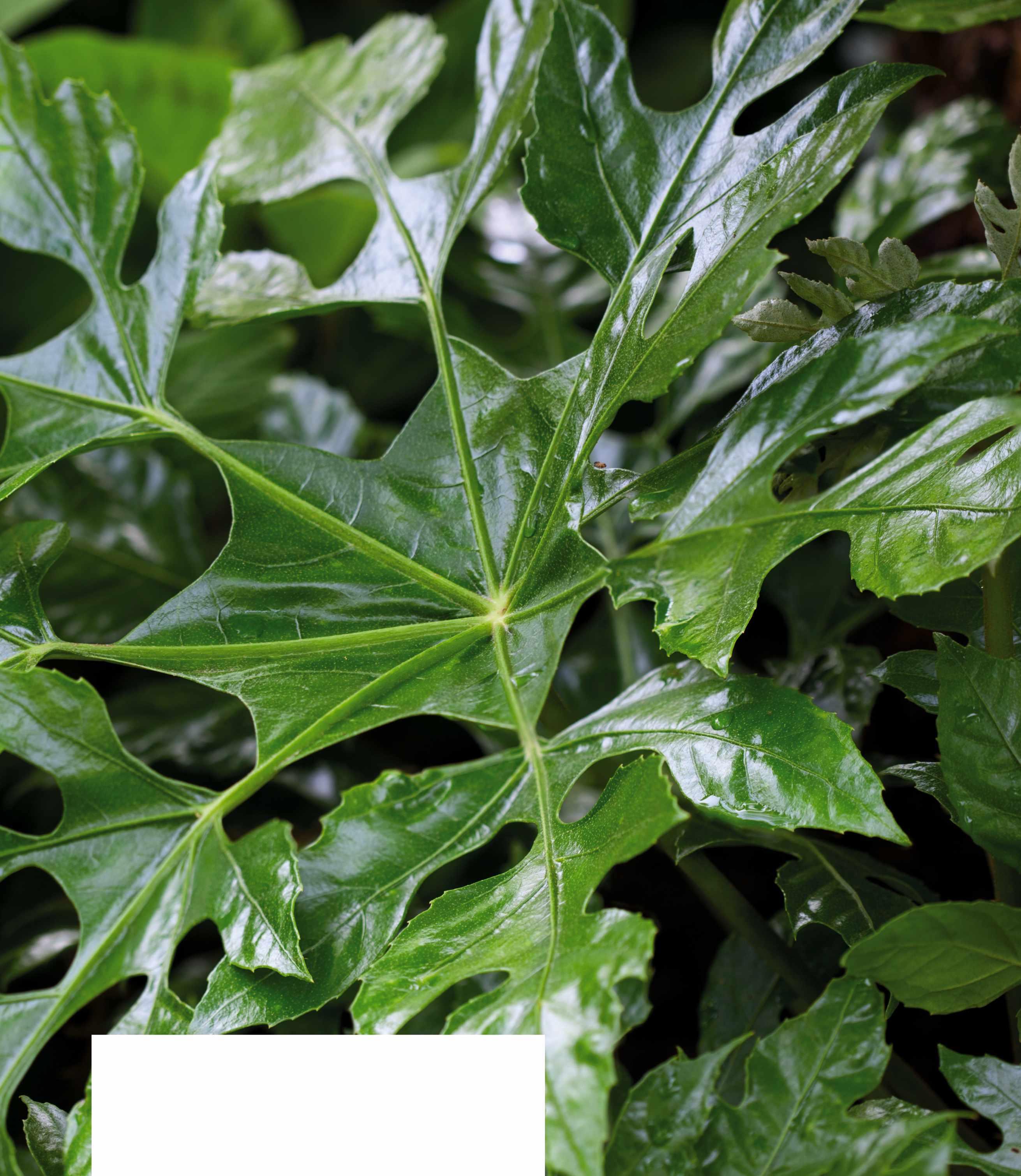
Trevesia palmata is an exceptional foliage plant, with glossy green foliage that is webbed and finely cut, resembling a large snowflake
bold, green sepals and dainty, long, arching, thread-like, yellowgreen petals around a dark maroon and brown bulbous knob. A herbaceous perennial, slow to build up, eventually making a sizeable clump. Bright-red berries follow the flowers before the plant collapses for winter. H 1m. S 40cm. PT Perennial C Rich and fertile soil; full shade. SI May – June. HR RHS H4, USDA 7a-9b.
21 TREVESIA PALMATA
An exceptional foliage plant, with glossy green foliage that is 30-45cm wide, webbed and finely cut, resembling a large snowflake. The lacey young leaves are a dusky pale brown turning green as they age. Makes a single-stemmed tree up to 7m high. Not winter hardy, needing greenhouse protection. H 7m. S 1m. PT Tree C Humus-rich, moist, but well-drained soil; best grown in semi-shade. SI Year round. HR RHS H1C, USDA 10a-12.
Often the plants we cherish the most are those that have associations with people and places we’ve loved. These plants fill me with memories of gardening alongside Christo at Great Dixter.
22 CAMPANULA PYRAMIDALIS
The chimney bellflower was used by the Victorians for spectacular indoor displays. Sown in April and potted on to make large rosettes, it will, in the second year, give rise to several tall stems densely packed with mauve, star-shaped flowers, opening wide to reveal paler centres and a prominent pistil. A short-lived perennial best treated as a biennial. White and pink forms are available. Flowers for longer when brought inside. H 2m. S 60cm. PT Perennial C Moist but well-drained soil; full sun to part shade. SI June – August. HR RHS H4, USDA 7a-11.
23 CHIMONANTHUS PRAECOX
The wintersweet has a hypnotic quality unequalled by any other shrub. Dull for most of the year, it sheds its leaves to reveal a zig-zag of skeletal stems which, as winter progresses, develop fat buds. They open in December into sweetly scented, translucent pale-yellow flowers, each with a murky, wine-coloured centre. Has an overall twiggy appearance and an inexplicable charm. H 3m. S 3m. PT Shrub C Moist but well-drained soil; full sun. SI December –January. HR RHS H4, USDA 7a-9b.
24 CRATAEGUS ELLWANGERIANA
A seldom-seen North American species that is rare in the wild. It’s a small tree with an elegant, rounded habit, with large ovalshaped, serrated leaves. Carries clusters of off-white flowers in the spring, followed by substantial bright-red fruit lasting well into the autumn, as foliage turns golden yellow before leaf fall. H 4m. S 4m. PT Tree C Any soil; full sun to part shade. SI Flowers spring; berries and foliage autumn. HR USDA 4a-8b.
25 ERIGERON KARVINSKIANUS
A plant well known to many, but still worthy of a place on this list. The Mexican fleabane gives a profusion of pale-pink and white daisies over a long period. It flowers all summer long, self-seeds in cracks and walls, it’s useful in pots, and in bedding, drought resistant and resilient. Plants should be sheared back to the base once or twice a year. AGM. H 30cm. S 30cm. PT Perennial C Well-drained soil; full sun. SI June – October. HR RHS H5, USDA 6a-9b.
26 GERANIUM ‘ANN FOLKARD’
A hardy, free-flowering perennial geranium with a trailing habit. The foliage in spring is lime green. Dark-centred magenta flowers are produced on the tips of the stems from July to the end of
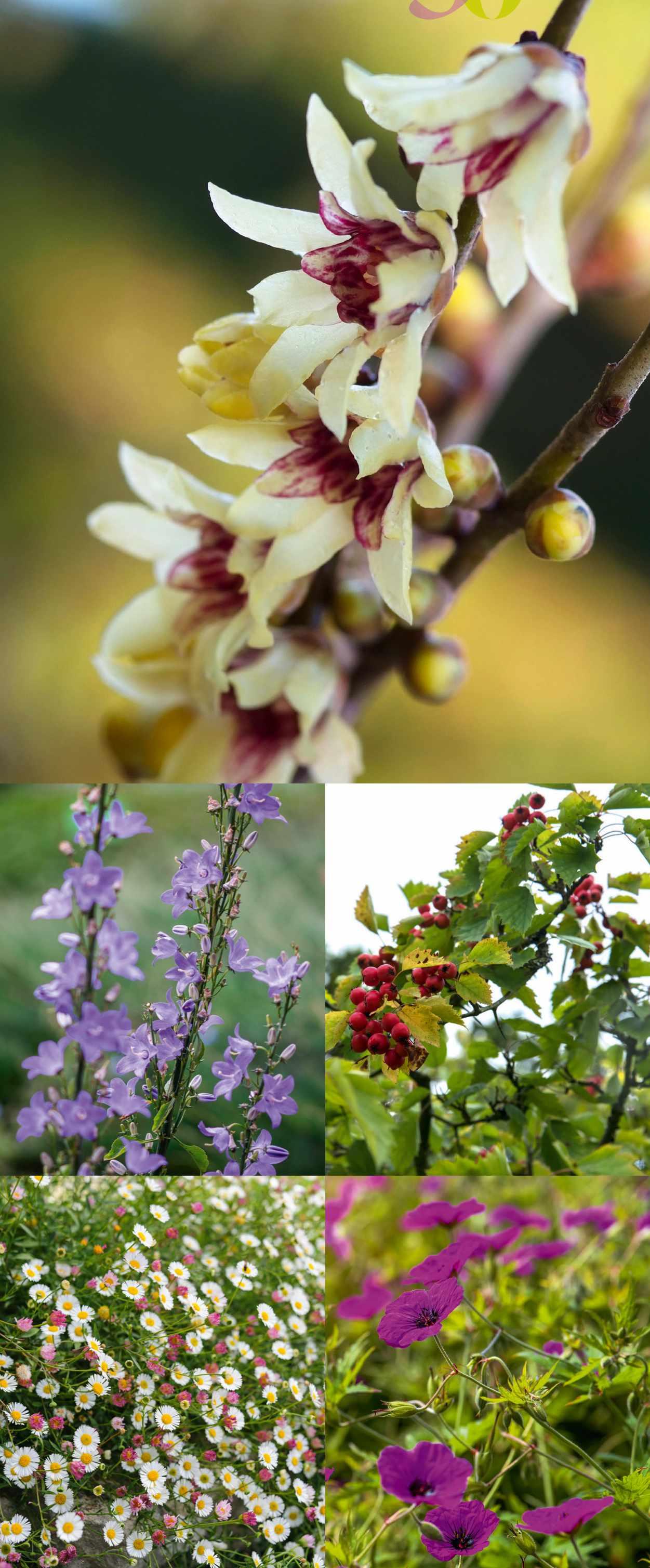
September. The plant can roam freely, trailing into its neighbours, or can be contained into a clump using pea sticks. Cut down to the ground before winter. AGM. H 75cm. S 60cm. PT Perennial
C Moist but well-drained soil; full sun to part shade. SI July –October. HR RHS H7, USDA 6a-8b.
27 NARCISSUS ‘BABY BOOMER’
Christo was very fond of jonquils and this one is the closest I can find to his mother’s original plant. A delicate multi-headed daffodil with narrow, rush-like leaves and upright stems carrying up to five or six small, fresh-yellow, highly scented flowers in early spring. Very good in pots or integrated among perennials in the border. H 40cm. S 20cm. PT Bulb
C Moist but well-drained soil; full sun to part shade. SI April. HR RHS H6, USDA 7a-9b.
28 OLEARIA SOLANDRI
The coastal daisy bush will not stop you in your tracks initially, but once you analyse its qualities, you realise what an extraordinary plant it is. Evergreen, with an upright, bushy habit, with dense coverings of brownish, olive-green, heather-like leaves, and the young growth lighter in colour, this plant has a great texture. The flowers are insignificant and occasionally scented of heliotrope. H 4m. S 3m. PT Shrub C Moist but well-drained soil; full sun to part shade. SI Year round. HR RHS H4, USDA 7a-9b.
29 PAULOWNIA TOMENTOSA
The foxglove tree is native to central and western China, where it grows to over 25m high, making a large dome and flowering in early spring with scented, long, tubular, mauve flowers. When stooled to 10cm from the ground, the plant puts all its energy into producing 3-4m tall, upright stems with gigantic leaves, without the flowers. Invasive in the wrong place. AGM. H 4m. S 1m.
PT Tree C Tolerant of a wide range of soils; full sun. SI Foliage: June – November; flowers: spring. HR RHS H5, USDA 5a-8b.
30 PEUCEDANUM VERTICILLARE
A stylish monocarpic umbel with broad celery-like leaves that are flushed brown when young, turning green with age. Upright, tall, dark stems carry whorls of flat-headed, mustard-yellow flowers. Self-seeds. Makes a stunning, solitary, architectural feature especially when rising above its surroundings. H 2.5m. S 50cm. PT Monocarpic herb. C Moist but well-drained soil; full sun to part shade. SI Summer. HR RHS H7, USDA 6a-8b.
31 POLYPODIUM X MANTONIAE ‘CORNUBIENSE’
All polypodies are useful, being wintergreen when so many plants around them are dormant. This one has fresh-green, lacey foliage that is finely cut and broadly ovate at ground level, with a slowly colonising creeping habit. Sometimes simpler, less finely cut leaves are produced. Grows best in moist shade, as long as it’s not waterlogged. Lovely with Cyclamen hederifolium and snowdrops. AGM. H 30cm. S 30cm. PT Fern C Moist but well-drained soil; full sun to part shade. SI Year round.
HR RHS H6, USDA 5a-9b.
32 VERBASCUM OLYMPICUM
The most impressive of all verbascums, with huge rosettes of hairy grey-green leaves. In May, it pushes up a skyrocket of a stem that metamorphosises into a huge branching candelabra, carrying bright-yellow flowers in June and July, creating dramatic accents in the border. After flowering, it sets seed and dies, the young seedlings taking two to three years to reach flowering size. H 2.5m. S 60cm. PT Biennial. C Light, well-drained soil; full sun. SI June – August.
HR RHS H6, USDA 5a-9b.
30 gardensillustrated.com FEBRUARY 2024
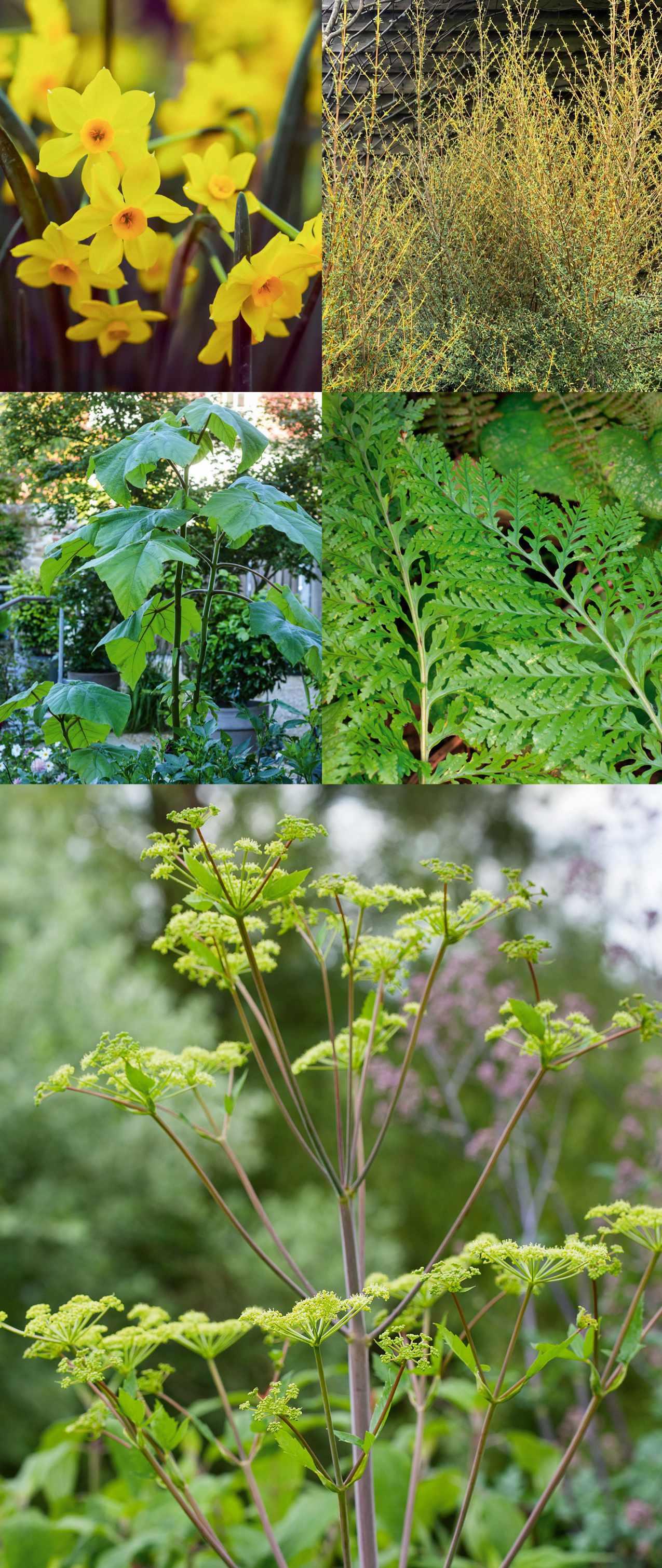
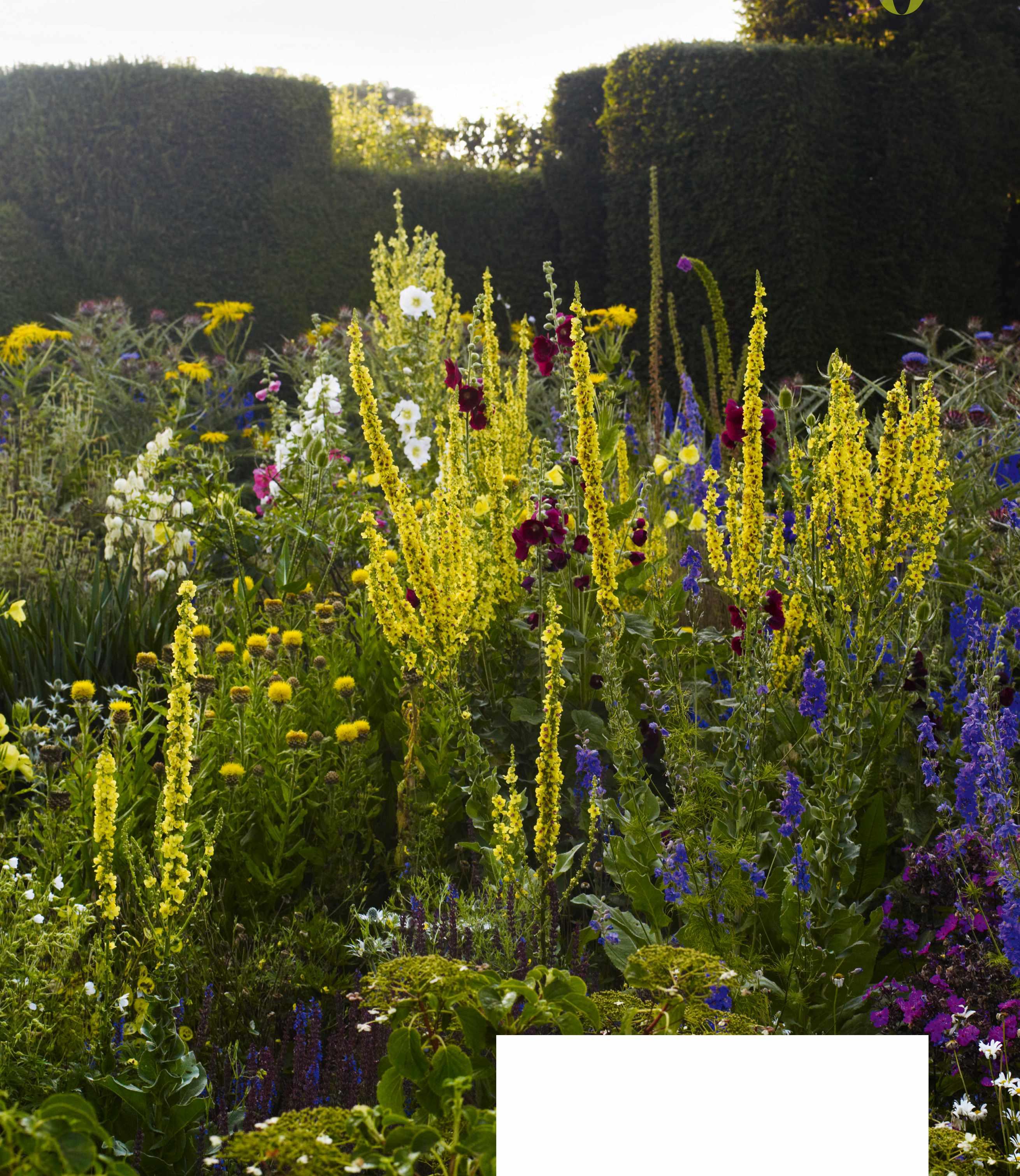
Verbascum olympicum pushes up a skyrocket of a stem that becomes a huge candelabra with bright-yellow flowers
Euphorbia characias subsp. wulfenii makes a rounded evergreen bush with bold heads of lime-green flowers
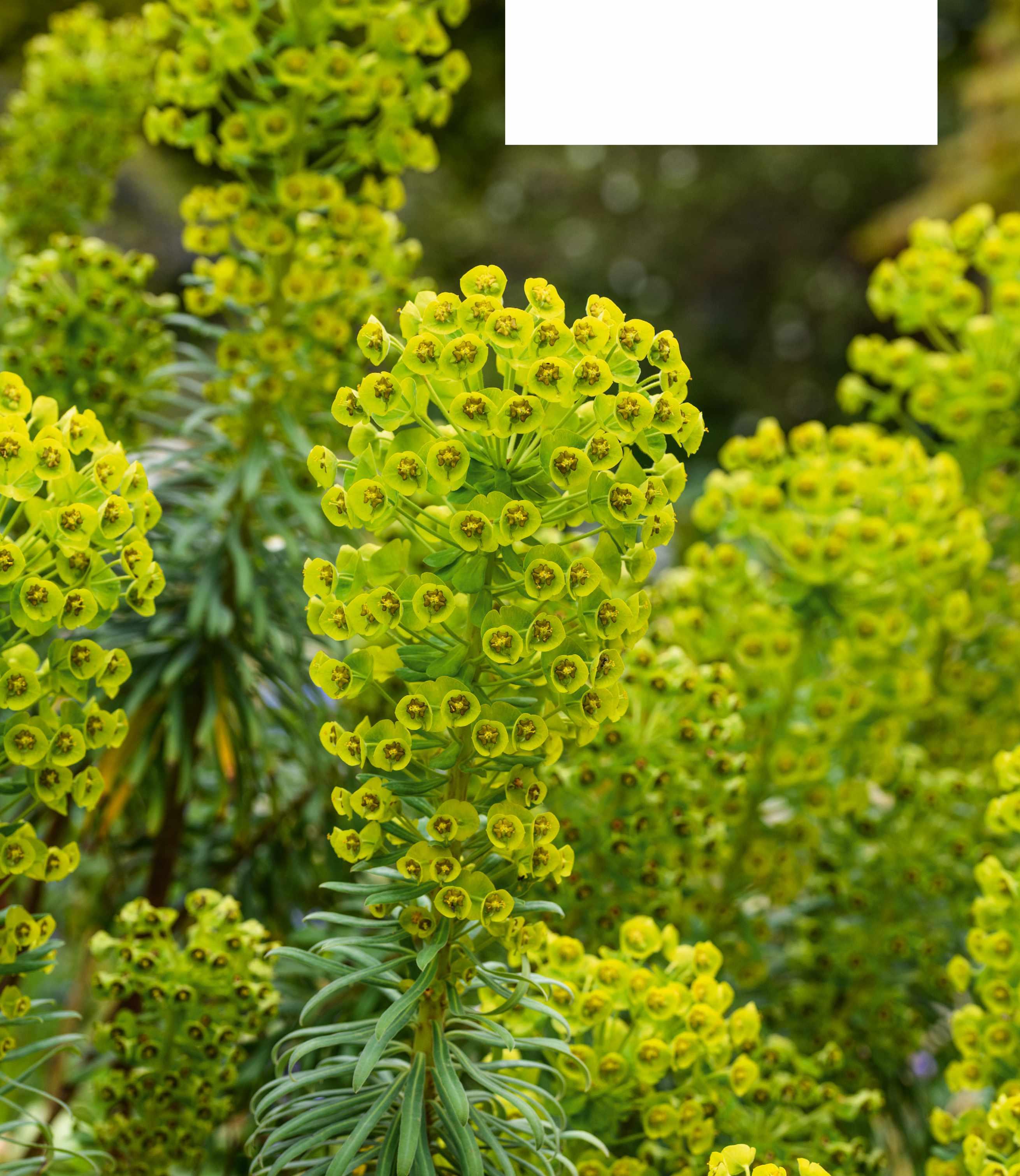
Every garden relies on stalwart garden plants that do the work for you and never let you down. These are the plants I wouldn’t want to garden without.
33 ASARUM EUROPAEUM
The European wild ginger is a creeping, ground-covering, evergreen perennial with a wide distribution across temperate Europe, occurring in deciduous woodland and coniferous forest. It has glossy, dark-green, kidney-shaped leaves with brownishmaroon, solitary, fused flowers in late winter and spring. Tolerant of shade, Asarum can be planted as an understorey to many perennials, taking centre stage as the perennials retreat. H 15cm. S 20cm. PT Perennial C Soil rich in organic matter; full shade. SI Year round. HR RHS H4, USDA 7a-9b.
34 CONSOLIDA ‘SUBLIME LILAC’
A tall and upright annual with feathery lace-like leaves and narrow spikes of delightful, mauve, double, long-spurred flowers. Sown in autumn and planted out in March, we use it threaded through the borders, flowering in June and July, giving useful colour before the summer flowers arrive. Makes an excellent cut flower. H 1.5m. S 30cm. PT Annual C Moist but well-drained soil; full sun. SI July – September. HR RHS H5.
35 CRYPTOMERIA JAPONICA ARAUCARIOIDES GROUP
An ungainly tree of great character with reddish-brown bark and an open habit. Has long branches that twist and turn, with stems covered in short, dark-green, sickle-shaped needles pressed tight around the wood, resulting in a prickly cord-like structure. Has the feel of a monkey puzzle but finer in many ways. Makes a great feature when mixed with broaderleaved plants. H 6m. S 4m. PT Tree C Well-drained soil; full sun. SI Year round. HR RHS H5, USDA 6a-9b.
36 EUPHORBIA CHARACIAS SUBSP. WULFENII
A common, first-class garden plant with whorls of grey-green leaves, making a rounded evergreen bush. Bold heads of lime-green flowers are produced on the mature stems, which can be cut away as the flowers fade. New shoots will replace the old ones and new seedlings will replace old plants. Flowers from spring into summer, making dramatic points of lime-green throughout the garden. H 1m. S 75cm. PT Sub-shrub. C Well-drained soil; full sun. SI Foliage: year round; flowers: March – May. HR RHS H4, USDA 6a-8b.
37 GALANTHUS PLICATUS ‘AUGUSTUS’
The pleated snowdrop from eastern Europe has broad, bluish, greygreen leaves characterised by folded-over leaf edges, a distinctive midrib and residual markings, giving it a pleated look. The nodding white flowers are held on short stems, with the inner segments marked green, and arrive at the end of February. The form ‘Augustus’ is chunky and bold, making quite a show when planted en masse. AGM. H 15cm. S 15cm. PT Bulb C Moist but well-drained soil; full sun. SI February – March. HR RHS H5, USDA 3a-7b.
38 LUMA APICULATA ‘GLANLEAM GOLD’
An evergreen shrub or small multi-branched tree with attractive reddish bark, small dark-green leaves edged with yellow markings, and clusters of white flowers in summer. Makes a great foliage feature in the border, contrasting with neighbouring grasses. Prefers full sun or semi shade, is slow growing and needs no regular pruning. H 4m. S 2m. PT Shrub C Well-drained soil; full sun to part shade. SI Foliage: year round; flowers: June – October. HR RHS H4, USDA 8a-9b.
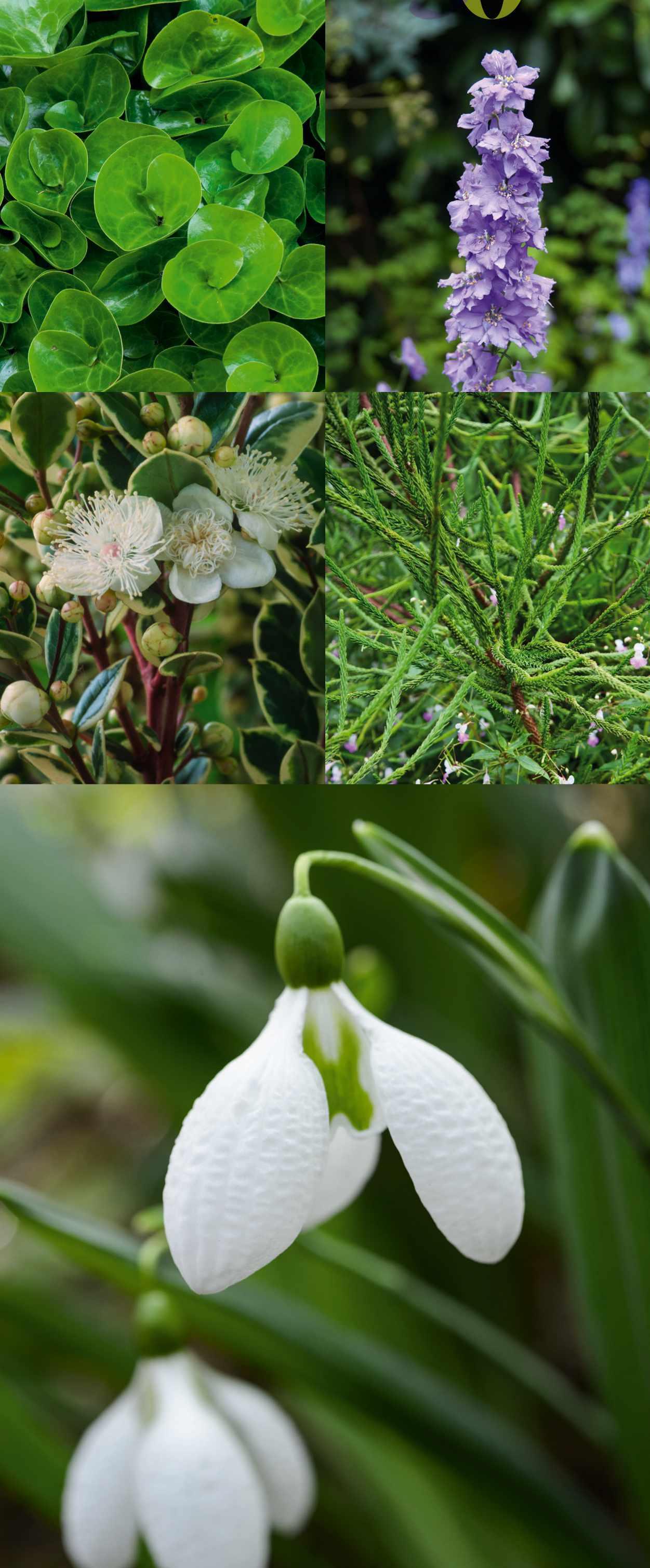
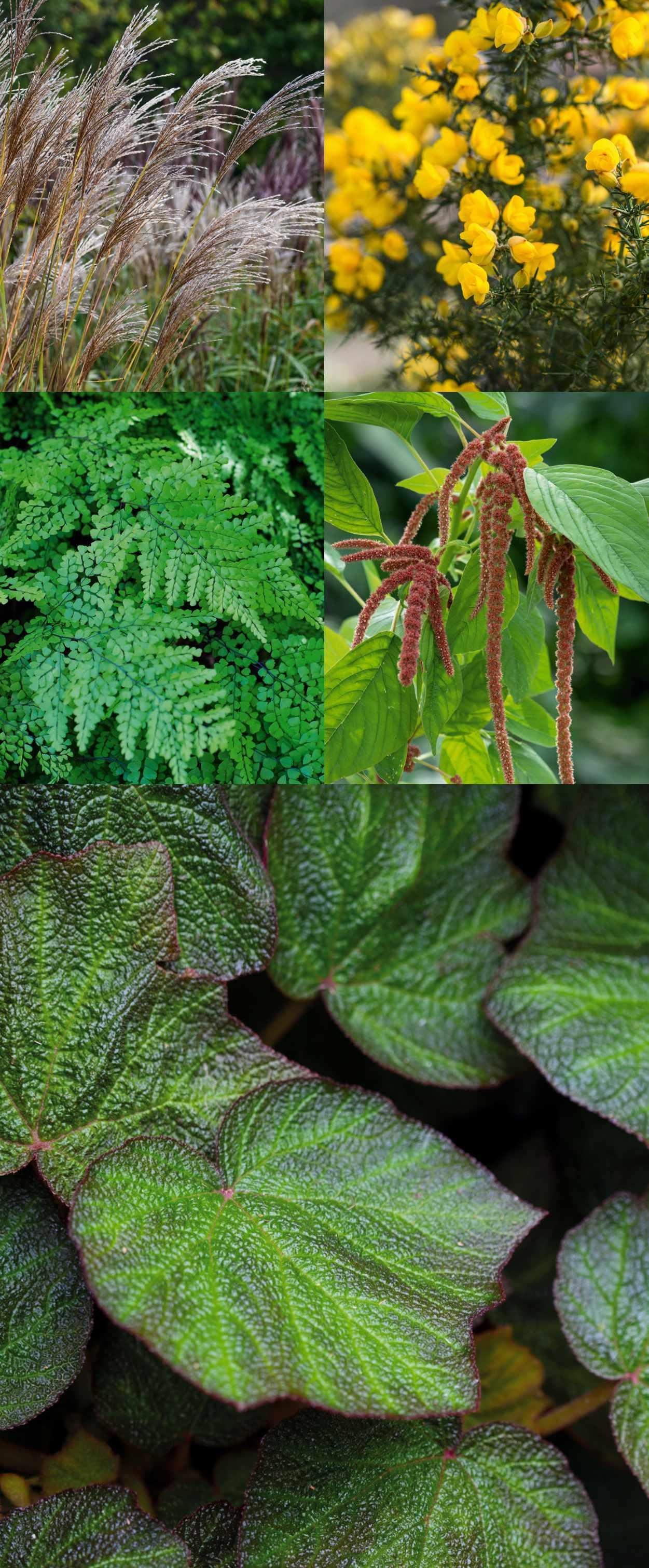
39 MISCANTHUS SINENSIS ‘MALEPARTUS’
A medium-sized upright grass with a neat composition, flowering late in September, with feathery plumes rising well above the foliage. Autumn colours of burnt oranges and yellows follow before the whole plant turns brown for the winter. Makes a good shape contrast to all the domes in a mixed border. Cut down in late winter or early spring. H 2m. S 50cm. PT Grass C Tolerant of a wide range of soils; full sun. SI Flowers: August –November. HR RHS H6, USDA 4a-9b.
40 PAPAVER COMMUTATUM ‘LADYBIRD’
Nothing quite brings in the summer like a ladybird poppy. Bright-red flowers, each petal boldly dressed with a black blotch at its base, nodding buds and finely lobed leaves make it a vibrant garden plant. We autumn sow, prick out and then plant through the borders randomly at high density and low density to make seams of red through all the open spaces. AGM. H 45cm. S 30cm. PT Annual. C Well-drained soil; full sun. SI June – August. HR RHS H5.
41 ULEX EUROPAEUS ‘FLORE PLENO’
This double gorse flowers its heart out throughout the year with golden-yellow flowers that are sweetly scented of coconuts. It has an interesting texture and an undulating, upright, pointing habit on a rounded bush, with spine-tipped stems and spiny leaves. Plants can be cut back once they get too big and they will sprout readily from old wood. AGM. H 1.5m S 1.5m. PT Shrub C Tolerant of a wide range of soils; full sun. SI March – November. HR RHS H6, USDA 6a-9b.
These plants may not fit into the other categories, but are ones that add another dimension to the ones already chosen – they have a life and a purpose of their own.
42 ADIANTUM VENUSTUM
The Himalayan maidenhair fern is a hardy evergreen fern that has finely divided, triangular fronds that are dainty and lacelike, carried on black stems with an overlapping habit. Slow to increase, it does best in moist conditions in soil that is rich in organic matter. Tolerant of deep deciduous shade, it will sit under shrubs and perennials, covering the soil. AGM. H 20cm. S 40cm. PT Fern. C Moist, organic-rich soil; part to full shade. SI Year round. HR RHS H7, USDA 3a-8b.
43 AMARANTHUS CAUDATUS ‘CORAL FOUNTAIN’
A vigorous love-lies-bleeding, with pale-green leaves and coralblushed stems supporting long, drooping tassels of dusky, coral-red flowers all summer long. Sown under glass mid-April, plants will be ready for planting by the first week of May. Needs a sunny site and does best in rich soil. Free-flowering and dramatic. H 1.5m. S 50cm. PT Half-hardy annual. C Humus-rich, moist but well-drained soil; full sun. SI July – October. HR RHS H2.
44 BEGONIA SOLI-MUTATA
A ground-hugging, tender begonia with rounded obovate, dark-green, almost brown, leaves; deeply veined and heavily textured, glossy and with a rough surface. The flowers are small and white and held in loose clusters in panicles above the foliage. Makes layers of foliage flushed with brown and a perfect foil to ferns. Easy from cuttings. Needs greenhouse cover for the winter but enjoys being planted out for the summer. H 30cm. S 50cm. PT Perennial C Moist organic-rich soil; part shade. SI Year round. HR RHS H1B, USDA 9a-11.
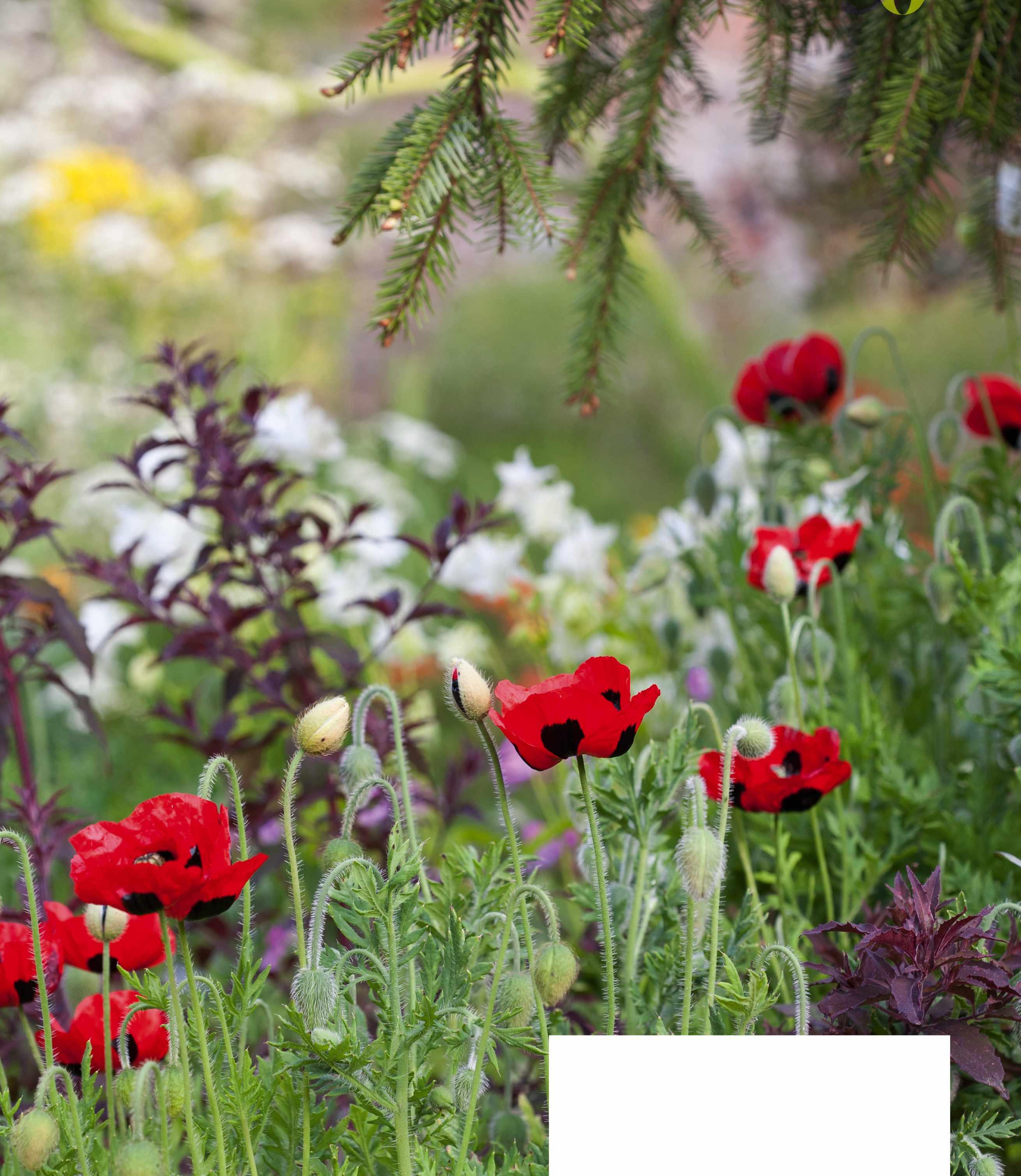
Nothing quite brings in the summer like a ladybird poppy. Bright-red flowers and lobed leaves make it a vibrant plant
The deep-purple, star-shaped flowers of Clematis x aromatica are strongly scented, blooming from July to September
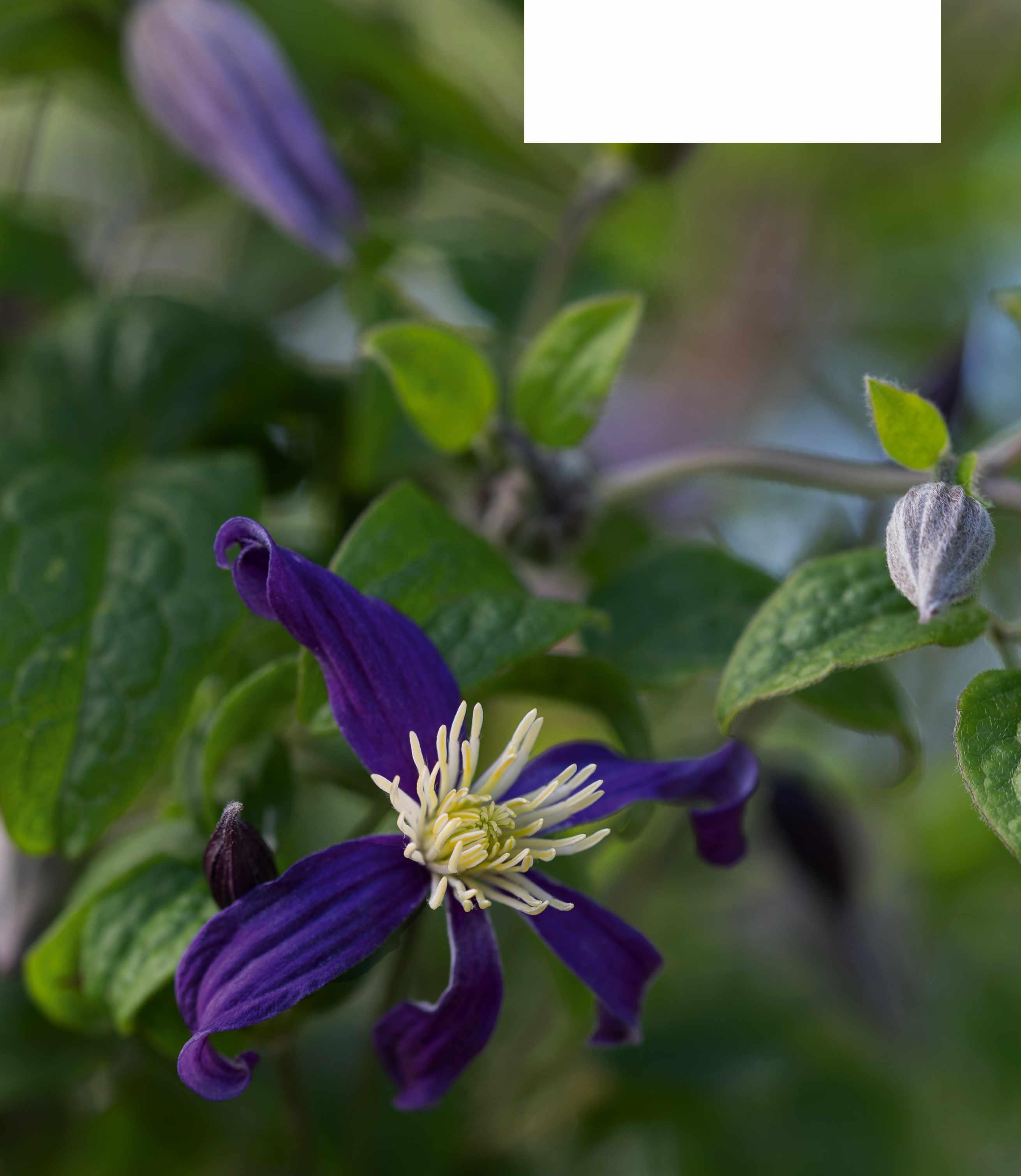
45 CLEMATIS X AROMATICA
A hybrid between C flammula and C integrifolia with deep-purple, star-shaped flowers that are 4cm across with an emboss of bold creamy-white stamens. The flowers are strongly scented, blooming from July to September. Of moderate vigour, making a useful garden plant scrambling through small shrubs such as roses and weigelas. H 2m. S 1m. PT Climber C Moist but welldrained soil; full sun. SI July – September. HR RHS H6, USDA 5a-9b.
46 EUPHORBIA X PSEUDOVIRGATA
A hybrid between E virgata and E esula resulting in a somewhat invasive spurge, with airy, grey-green foliage and a running rootstock scrambling through vegetation, coming alive with bright, lime-green flowers over a long period. Its running nature can be used to your advantage, as it colonises areas without squeezing other plants out, filling the open spaces and threading acid green through other colours. H 1m. S 30cm.
PT Perennial. C Tolerant of a wide range of soils; full sun. SI Year round; flowers: July – October. HR RHS H4, USDA 6a-8b.
47 LATHYRUS ROTUNDIFOLIUS
A medium-sized, delicate perennial sweet pea with petite, rounded leaves on slender stems and clusters of small, brick-red, unscented flowers. Clinging tendrils help this pea work into its surroundings, and in the wild it is often seen as a plant of high meadows, scrambling up vegetation. Can be propagated from seeds sown in the autumn or early spring. H 1.5m. S 30cm.
PT Perennial C Tolerant of a wide range of soils; full sun to part shade. SI June – August. HR RHS H7, USDA 3a-8b.
48 OLOPTUM MILIACEUM
A clump-forming perennial grass with a low mound of leaves and erect stems, decorated in whorls of branches supporting feathery branchlets, resulting in a complex yet dainty framework. It has a light and wispy appearance, swaying in the faintest breeze, and has a long season with flowering lasting for a long time. Replace old and tired plants with new seedlings. H 1.5m. S 50cm. PT Grass C Moist but well-drained soil; full sun. SI May – December. HR RHS H5, USDA 7a-9b.
49 SAMBUCUS ‘GATE INTO FIELD’
A relatively new introduction by Cotswold Garden Flowers. A hybrid with great character, flowering twice in a year, first in May on old stems carried forward from the previous year, and then again in August/September, flowering on new shoots formed in the current year. The foliage is pewter coloured, and the flowers are a soft cream, carried as large plates. A first-class plant given the space. H 5m. S 5m. PT Shrub C Tolerant of a wide range of soils; full sun to part shade. SI May and August –September. HR RHS H6, USDA 4a-7b.
50 THALICTRUM ‘BLACK STOCKINGS’
A tall and upright, hardy meadow rue with finely cut, lacey grey green foliage. Has stiff blackish stems carrying cloudy sprays of bright-purple, starry flowers at head height. Self-supporting, needing no staking; a dramatic and trouble-free perennial. Attractive seedheads follow. Seedlings are variable. H 2m. S 50cm. PT Perennial. C Moist but well-drained soil; full sun to part shade. SI Flowers: June – July. HR RHS H7, USDA 5a-9b.
USEFUL INFORMATION
Great Dixter House & Gardens Address Northiam, Rye, East Sussex TN31 6PH. Tel 01797 252878. Web greatdixter.co.uk
Open Gardens open from March to end of October; nursery open seven days a week, April to October, and six days, closed on Sundays, from November to March. See website for opening times.
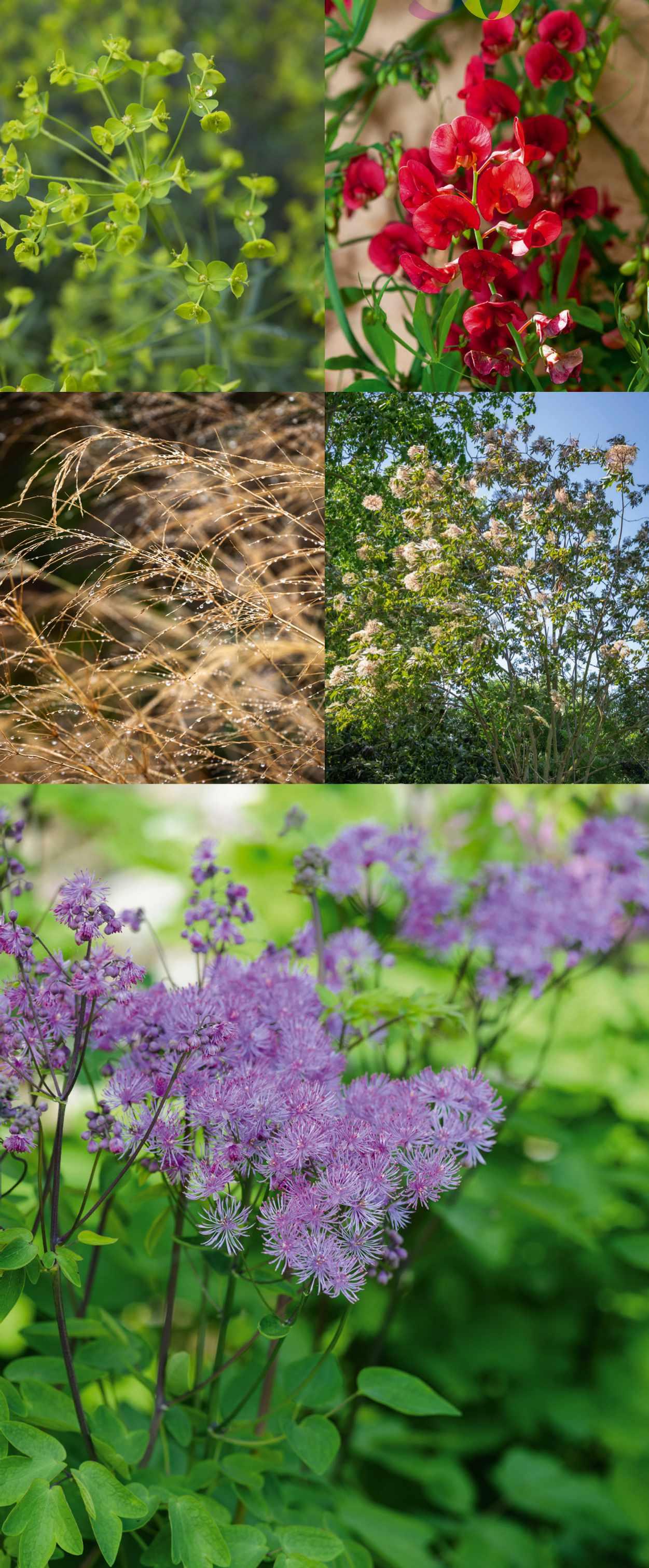

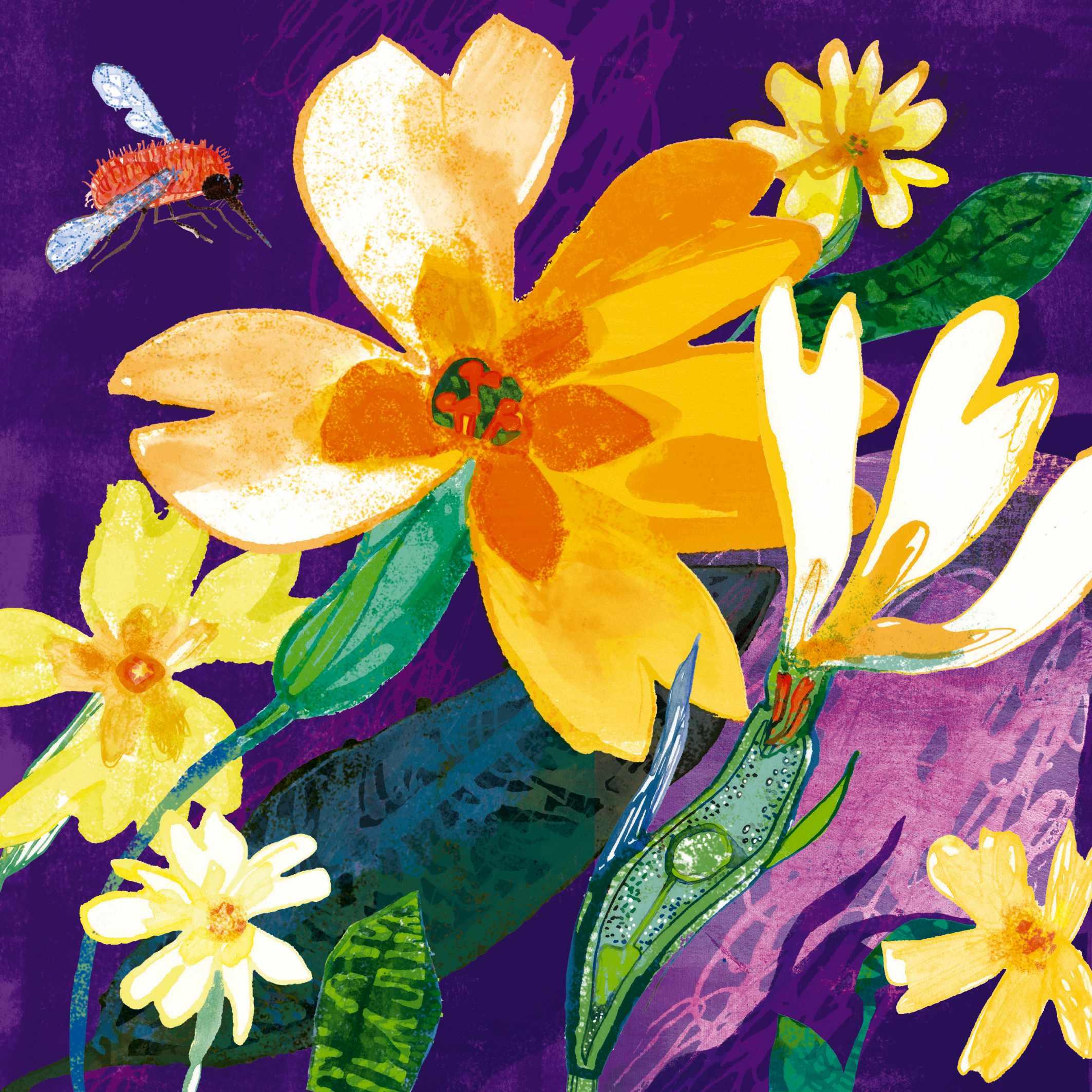
Ken Thompson looks at some of the intriguing – and often less than obvious – ways in which plants have adapted to survive and thrive
ILLUSTRATION JILL CALDER
e can all agree that plants are beautiful. But what is much less obvious is that they’re also resourceful, adaptable and, above all, smart. For example, they can measure exactly how much carbon dioxide – a chemical compound that us mere mortals can neither see, taste nor smell – is in the atmosphere. Not only that, but they can also then respond accordingly; in fact, old herbarium specimens show that plants noticed rising carbon dioxide levels long before we ever did. Another example: seeds in the soil can measure changing temperature and use that information to check how deeply buried they are, and what’s growing above them. Finally, they put all that information together to decide whether or not it’s a good idea to germinate.
Plants do all that, and a lot more, without lifting a finger, which makes it easy for the dim-witted observer (that is, me and you) to assume that they’re not doing very much. You can begin to see why, when the science fiction writer John Wyndham wanted to conjure up a plant

that would really make people sit up and take notice, he was forced (in his 1951 novel The Day of the Triffids) to invent a carnivorous giant that could walk around.
In fact, although plants are clever, their cleverness is so unlike human intelligence that we simply fail to recognise it. If we deny that plants are intelligent, all we really mean is that they aren’t like us – and I do wonder if we would recognise a really alien intelligence if we tripped over it.
Sometimes it’s obvious that plants are up to something, but much less easy to tell exactly what. For example, most species of Primula, including our familiar native primrose, P. vulgaris, show a condition known in botanical jargon as heterostyly. Some primrose plants have a long style, with the receptive stigma at the top of the petal tube and the stamens half-way down the tube. These plants are called ‘pin-eyed’. Others, with the stigma half-way down the tube and the stamens at the top, are known as ‘thrum-eyed’. The two kinds of plants are easily distinguished once you get your eye in.
For a long time, no-one paid much attention to heterostyly, and the 18th-century Swedish naturalist Carl Linnaeus, who developed the modern system of identifying, naming and classifying organisms, himself regarded it as an insignificant bit of floral variation that no serious botanist would consider important. The first person to figure out what was actually going on was Charles Darwin, in his book The Effects of Cross and Self Fertilisation in the Vegetable Kingdom, published in 1876.
Darwin realised, and then proved experimentally, that heterostyly is all about preventing self-pollination: pollen from one kind of plant that gets on the proboscis of a butterfly (or my favourite pollinator, a bee-fly) is in just the right place to pollinate the other kind, but not the same kind, which more or less prevents self-pollination. So chuffed was Darwin by the discovery that he declared in his autobiography that ‘no little discovery of mine ever gave me so much pleasure as the making out the meaning of heterostyled flowers’.
Although plants are clever, their cleverness is so unlike human intelligence that we simply fail to recognise it. If we deny that plants are intelligent, all we really mean is that they aren’t like us
It took a lot longer to figure out the purpose of another bit of seemingly pointless floral variation. In plants with enantiostyly (derived from enantios, the Greek word for opposite), which is a kind of ‘sideways heterostyly’, the style is deflected to either the left or the right. So once again there are two morphs and, if you put them side by side, they look like mirror images.
Just like heterostyly, enantiostyly acts as a mechanism to prevent or reduce self-pollination. ‘Handedness’ of flowers works because left- and right-handed morphs place most of their pollen on different sides of a visiting bee, where it’s in the right place to be transferred to the stigma of the other morph.
Enantiostyly has evolved independently on several occasions, but remains uncommon. Sadly, I must tell you that nothing with enantiostyly is hardy enough to grow outdoors in the UK. But houseplant enthusiasts don’t have to go far to see it – all species of African violet (formerly known botanically as Saintpaulia, but now reclassified into the genus Streptocarpus) have enantiostylous flowers. ■
• Dr Ken Thompson is a plant ecologist and myth buster, who is known for his scientific and practical approach to gardening. He is author of books on invasive species, biodiversity, wildlife gardening, weeds and compost making.
SINGLE SNOWDROPS
SINGLE SNOWDROPS
DOUBLE SNOWDROPS
DOUBLE SNOWDROPS
ENGLISH BLUEBELLS
CROCUS
MINIATURE DAFFODILS
ACONITES
DWARF IRIS
FRITILLARIA
SNOWFLAKES
DOGS TOOTH PAGODA
P&P

£11 PER 100
£95 PER 1000
£16 PER 100
£140 PER 1000
£16 PER 100
£9 PER 50
£9 PER 50
£10 PER 50
£9 PER 50
£9 PER 50
£15 PER 10
£11 PER 10
£3, CREDIT AND DEBIT CARDS ACCEPTED. MAKE CHEQUES & POSTAL ORDERS PAYABLE TO: ANGLIA BULBS, LORDS LANE, WISBECH, CAMBS PE13 4TU. TEL: 01945 410966 ALL BULBS TOP QUALITY







What Experimental dry garden, owned by the Goulandris Natural History Museum, and is the headquarters of the Mediterranean Garden Society.
Where 30km east of central Athens, Greece. Size Four acres.
Soil Alkaline. Intensively gardened areas have mostly the terra rosa soil of the Mesogeian plain over which the garden looks, but the wild hillside above has thin, stony soil. Climate Mediterranean (long, hot summers; short, rainy winters).
Hardiness zone USDA 9.
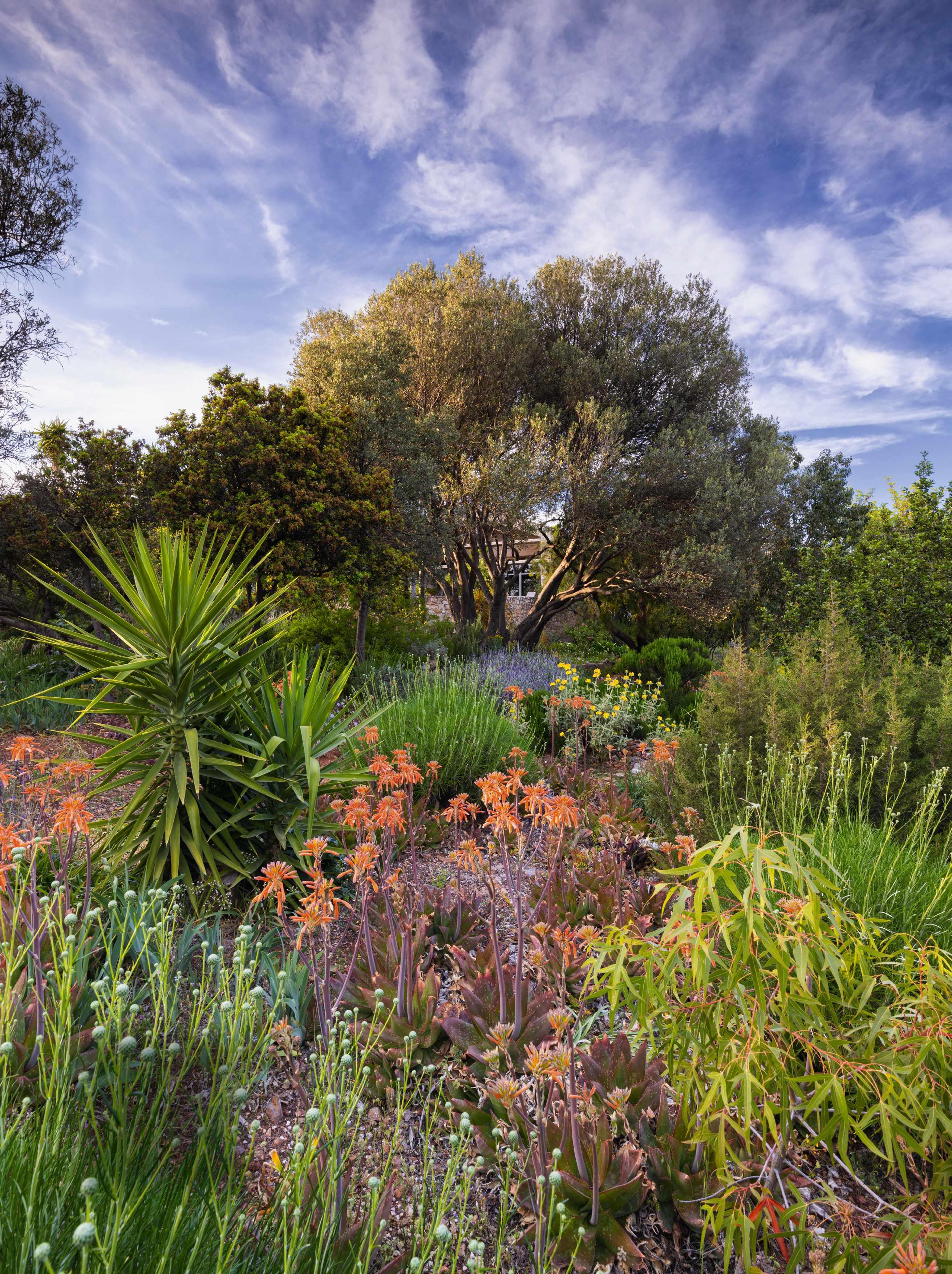
Looking north over an experimental area of natives and succulents, where only the toughest plants survive. Mauve-flowered native Ptilostemon chamaepeuce grows well in poor soil, while Central American Yucca elephantipes, Australian Brachychiton gregorii and South African Aloe maculata are also notable for their resilience.
long-lasting, pale-apricot
propagate easily and quickly make a good groundcover.
in
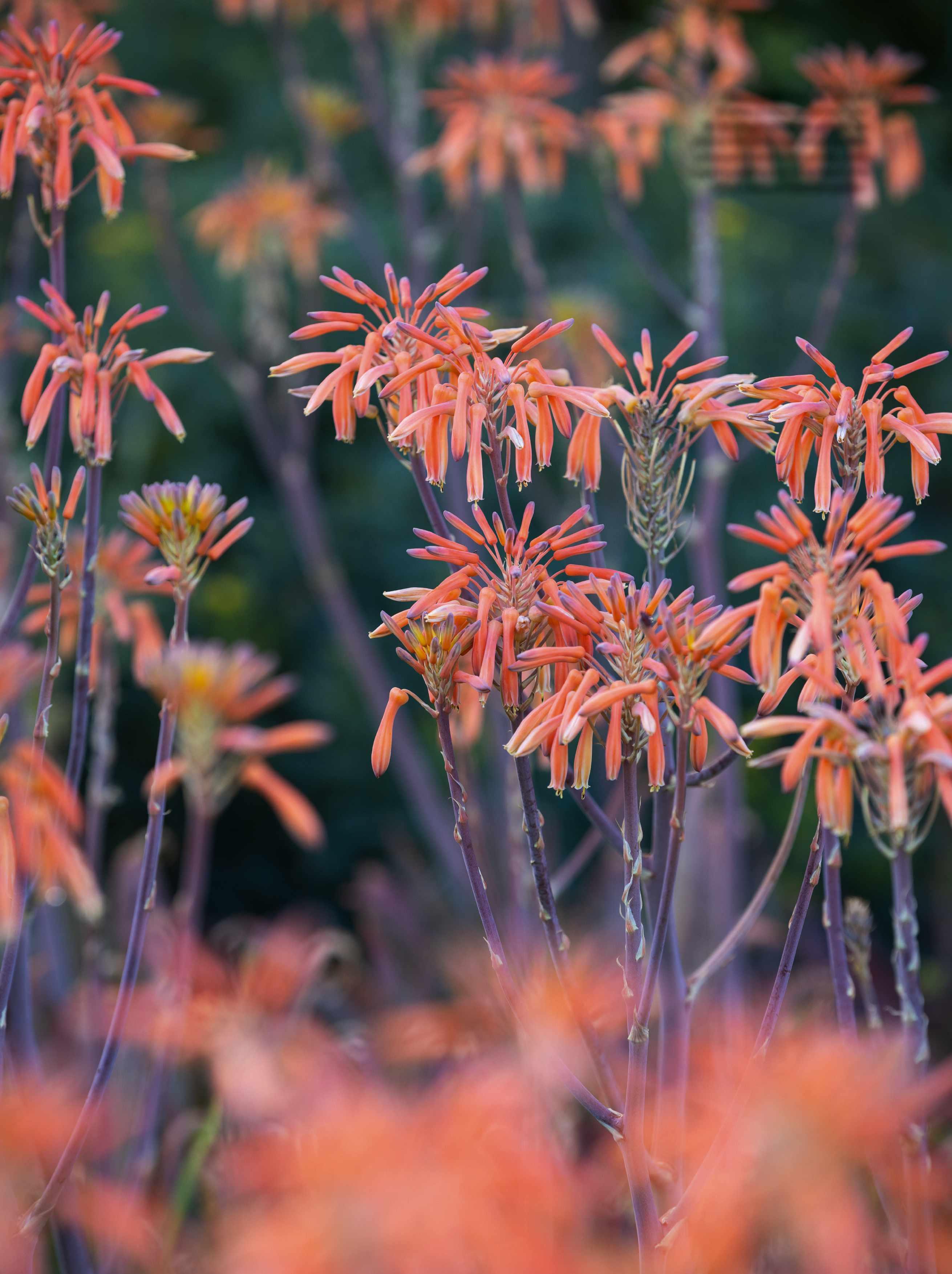
A series of dedicated women have transformed a scrubby hillside near Athens into a remarkable, experimental garden filled with resilient Mediterranean plants from all over the world
WORDS JENNIFER GAY PHOTOGRAPHS RICHARD BLOOM

Just east of Athens, overlooking the Mesogeian plain, lies a unique garden –Sparoza. Established in the 1960s by the renowned British urban planner Jacky Tyrwhitt, around her private home, it is an organic, experimental, dry garden with a treasure trove of nearly 1,000 different Greek native and Mediterranean climate-zone plants. It has also been the headquarters of the Mediterranean Garden Society (MGS) since 1994.
It is difficult to overstate the specialness of this place. It is one of only a handful of historic gardens in Greece and has been a flagship for the promotion of dry gardening since its inception. Entering the garden today, it’s hard to imagine the lunar landscape of a hill that Jacky bought. As she began to tackle her project, she found herself working on an arid, hot and windy site, with poor stony soil and plenty of protruding bedrock. She even resorted to using dynamite to blow craters into the hillside for her tree-planting holes, and wrote of Sparoza that ‘anything that grew under the difficult conditions prevailing here would be almost certain to grow better elsewhere’.
However, the story of the garden is that of not one but two pioneering plantswomen. On her death in 1983, Jacky left Sparoza to the Goulandris Natural History Museum for the protection and
preservation of the native flora. A transitional period followed until Sally Razelou, the Anglo-Irish artist-gardener, took over the reins in 1992, and a new phase of garden reinvigoration began. She not only nurtured and developed Sparoza for nearly 30 years until her death in 2021, but also helped found the MGS in the early 1990s.
Both women championed the use of native flora at a time when it was largely overlooked, and both celebrated the rhythm of a natural Mediterranean garden, with flowering beginning in autumn, prompted by rain, peaking in spring, then resting in summer. Significantly, both kept records of climate data and their work.
I came to Sparoza in 2000 as the first of Sally’s garden assistants, and this experience and her friendship had a profound influence on me and my work. I remember driving (rather fast) up the track to the property with Sally at the wheel, catching a first glimpse of olives and mounds of Pistacia lentiscus in the otherwise aestivating, unirrigated phrygana (scrubland). We curved round the bottom end of this long, narrow piece of hillside, revealing a modest, vernacular stone house lying long and low in a hollow, with the intensive, watered part of the garden wrapped around it.
I have now come back to see Lucie Willan, the current custodian, and together we walk To continue turn to page 48
Above Jacky’s old swimming pool has been repurposed as a wildlife pond; especially important where there is little freshwater habitat. Behind the pool are some of the cypresses Jacky used for original windbreak planting (planned with the help of Greek landscape architect Marina Adams).
Right above Amid the varied, multi-layered planting in Derek’s Garden (named for Derek Toms, one of the instigators of the MGS), the Australian Eucalyptus globulus towers above the clipped forms of Pistacia lentiscus and Teucrium fruticans perfect foils for the natural growth of Phlomis fruticosa, Pseudodictamnus acetabulosus, Cneorum tricoccon and Acanthus mollis
Right below A window into the rich, floral mosaic of the woodland border. To the right, a beautifully pruned Phillyrea latifolia lends height and structure to treasures such as Euphorbia characias, Iris germanica, Salvia microphylla and Agapanthus praecox subsp. orientalis
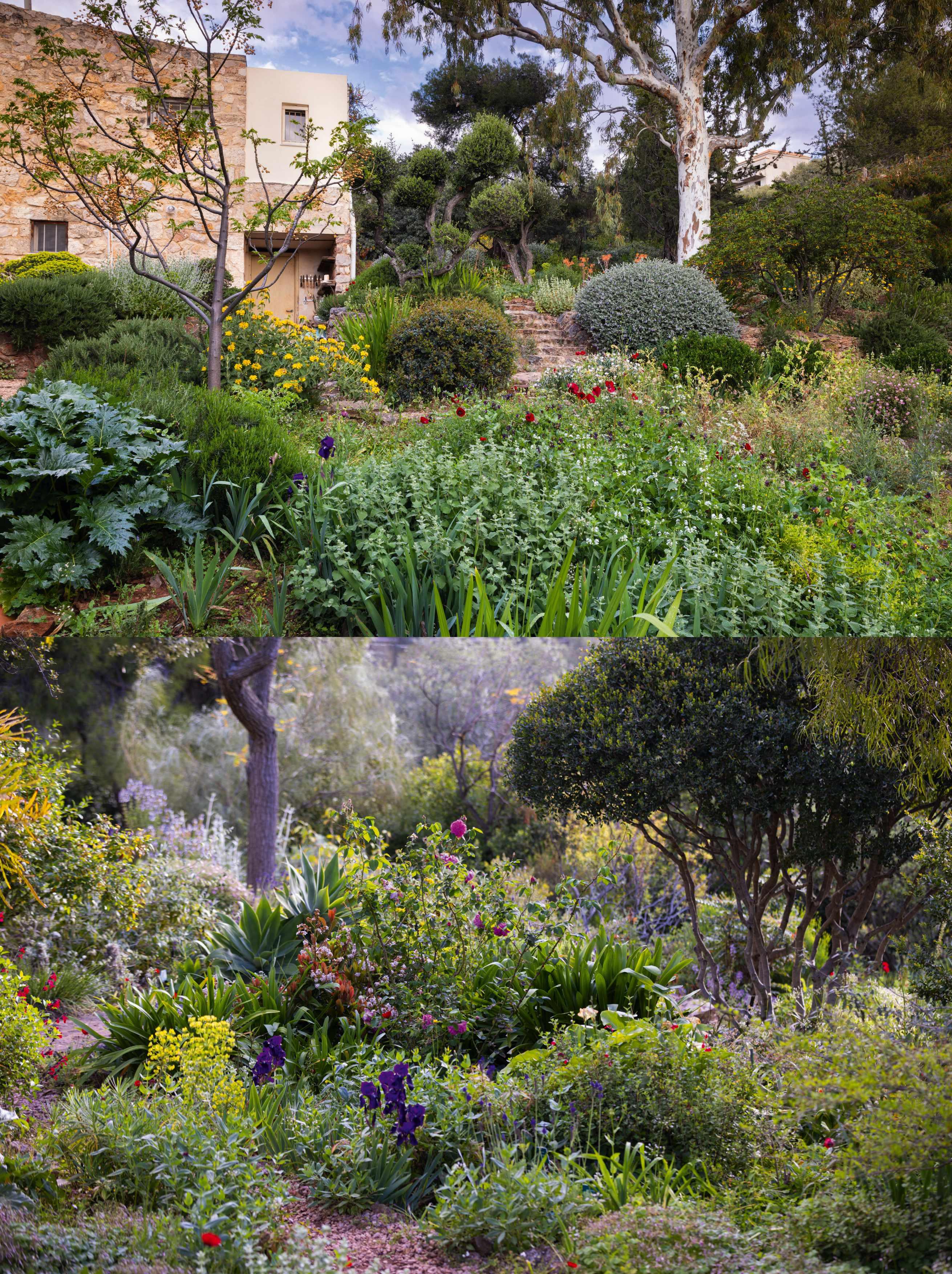
Jacky even resorted to using dynamite to blow craters into the hillside for her tree-planting holes, and wrote that anything that grew here would be almost certain to grow better elsewhere

There are far-reaching views over the fertile Mesogeian plain from the wild part of the garden. The thin, stony soil found on Sparoza hill is home to a rich diversity of wild annuals and bulbs. Leaves of Narcissus papyraceus and Charybdis maritima are seen here, as well as shrubby Phlomis fruticosa and Thymbra capitata. The silvery olives on the hill offer shade alongside planted pines and cypresses.
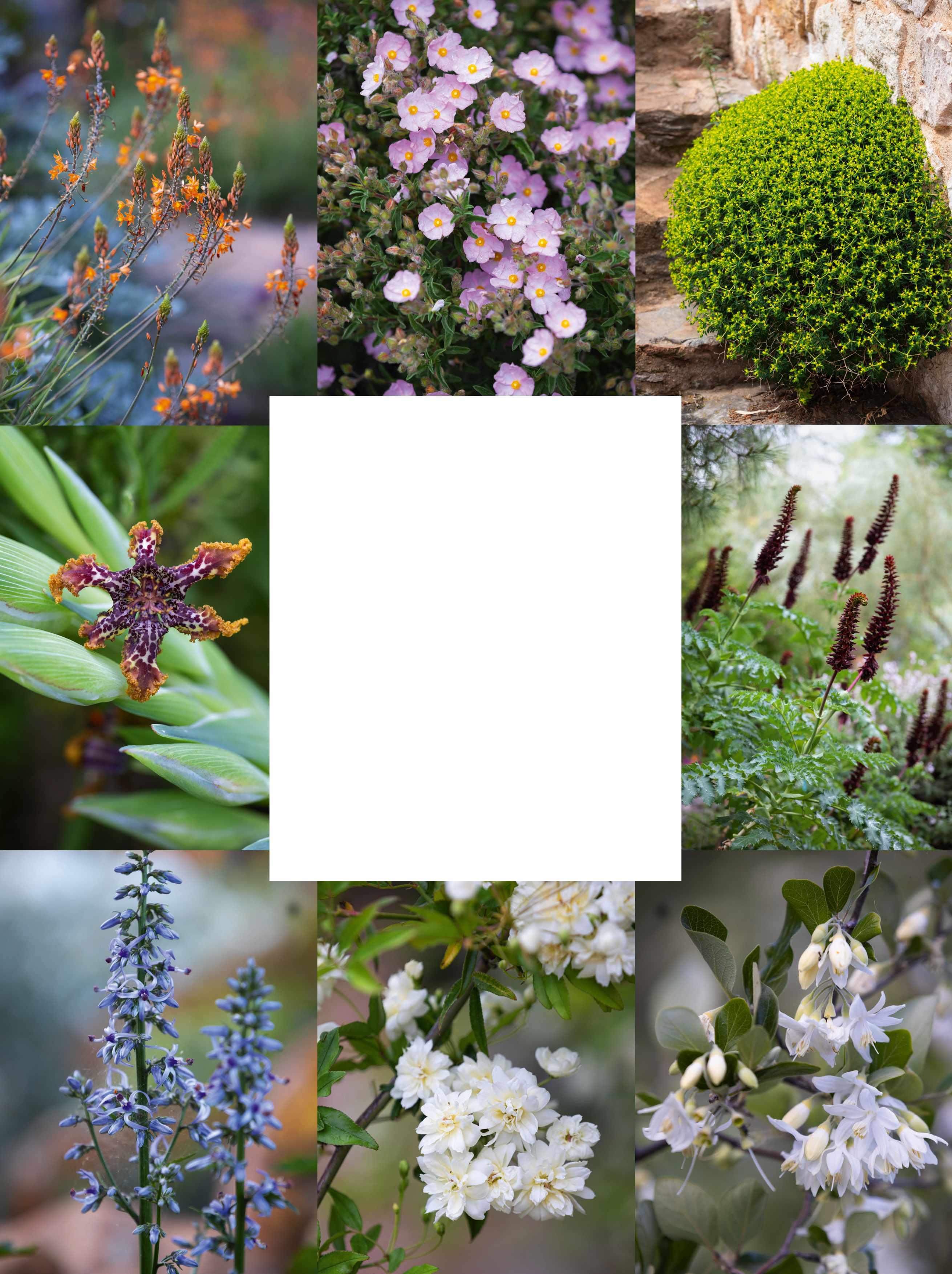
1 Bulbine frutescens ‘Hallmark’ A tough performer from South Africa, happy in sun and shade, tolerating alkalinity well. Abundant orange flowers rarely pause at Sparoza. Height and spread: 50-60cm x 60cm. RHS H3†
2 Cistus x skanbergii Masses of pretty, soft salmon-pink flowers cover this evergreen cushion in spring. Associates very well with silver-greys and lime-greens. 60-80cm x 1m. RHS H4.
3 Euphorbia acanthothamnos A classic dry-garden plant that deserves to be better known. Forms a leafless, spiky, architectural bronzed cushion in summer; brilliant lime-green flowers in early spring. 30-50cm x 70cm-1m. RHS H2.
4 Ferraria crispa The exotic, velvety, South African starfish iris is a stand-out example of the wealth of ephemeral Mediterranean bulbs at Sparoza. Full sun or semi shade. 30-50cm x 20cm. RHS H2.
5 Melianthus major This South African endemic with striking architectural leaves injects drama and a sub-tropical edge into planting compositions. Enjoys the protection of a wall. 1.5-2.5m x 1.5-2.5m. AGM*. RHS H3.
6 Petromarula pinnata Beautiful Cretan chasmophytic endemic. Countless blue star-shaped flowers on tall stems in late spring. Happiest in deep gorges, sun or shade. 50-80cm x 50-60cm. RHS H4.
7 Rosa banksiae var. banksiae Every April, this iconic Banksian rose produces a profusion of double, creamy-white, fragrant flowers easily covering a seasoned wooden pergola to the east of the house. 4-8m x 2.5-5m. RHS H5, USDA 8a-10b.
8 Styrax officinalis This fascinating eastern Mediterranean shrub or small tree grows on dry rocky slopes, producing scented, white, star-like flowers in spring.
The fragrant resin (storax) has been used medicinally and as a perfume since ancient times. 6m x 3-4m. RHS H5, USDA 9a-10b.
*Holds an Award of Garden Merit from the Royal Horticultural Society. †Hardiness ratings given where available.
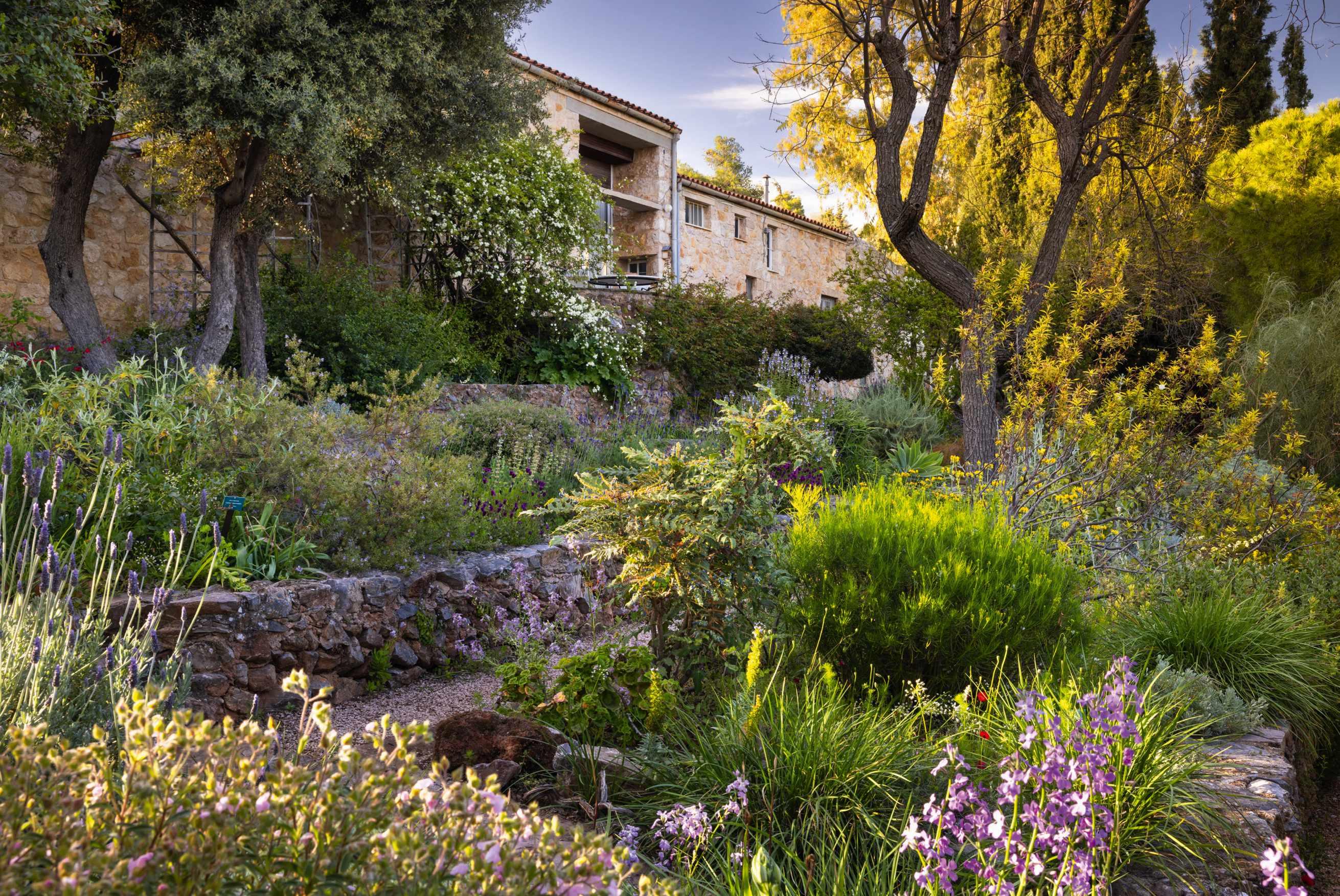
out of the huge glass doors on the east side of the house to the spacious verandah, graced with a huge Banksian rose. We look down on the series of terraces that are Jacky’s original garden: an extraordinary array of trees, shrubs and bulbs from the five Mediterranean climate zones of the world.
“I think of the Terraces as a Mediterranean cottage garden,” says Lucie. “We’re constantly adding to increase diversity and interest.” There’s a strong showing of South African plants, with Freylinia lanceolata, Coleonema album, Euryops virgineus, Searsia lancea and Haemanthus coccineus growing amid natives such as Cercis siliquastrum and Fritillaria obliqua, one of the rarest in Greece.
The Dancing Olives, the affectionate name given by Sally to a group of artistically pruned wild olives at the far end of the terraces, mark the point where garden merges with wild phrygana. And this is where the real drama and remarkable, ephemeral beauty of this garden comes into its own. “Sparoza remains, in essence, a wild garden,” explains Lucie.
“Native bulbs and annuals come in successive waves, peaking one after the other. It starts with pink carpets of Cyclamen graecum in autumn, moving through crocuses and Sternbergia lutea to Anemone coronaria and A. pavonina in mid-winter. It is astonishingly beautiful and incredibly moving.” The drama builds with annuals and bee orchids erupting in April. “And then, after a final crescendo
of Bupleurum flavum shot through with the electric blue of Delphinium peregrinum, it goes quiet. I’ve started a New Year’s Day flower count, and on 1 January this year, we had 136 species flowering.”
We walk to the specialist nursery Sally created almost 30 years ago where we ooh and aah over treasures such as Cretan endemic Petromarula pinnata, while musing over the climate challenges we have both experienced. During my time here, Sally recorded Sparoza’s lowest ever rainfall year (190mm). Lucie’s records show marked erraticism, with summer temperatures edging higher and heavy snowfall three years in a row, when usually it would only be expected every ten.
After the exceptional drought of 2000, Sally trialled succulents such as aloes and yuccas, and found they were also excellent at reversing erosion. This spirit of experimentation continues - Lucie is planning a new trial area to help gardeners select what will withstand these increasing extremes.
“Sparoza is a tribute to what you can create on a very hostile site with limited resources, but lots of time, vision and love,” she says. It seems this sanctuary of serenity is in safe hands. ■
USEFUL INFORMATION
Sparoza is a private garden but opens for pre-booked tours. Web sparozagarden.com; mediterraneangardensociety.org
Above On the Terraces, Jacky’s Rosa banksiae var. banksiae is in full bloom over the old wooden pergola.
On the wall to the right, below Rosa ‘Mermaid’, a dense tapestry of plants includes Matthiola sinuata, Salvia canariensis and Cistus x skanbergii
Right above Looking north towards the amphitheatrical hillside, a fine specimen of Cupressus arizonica grows near the pools, with a young Melia azedarach, another remarkably drought-tolerant tree, on the right. In the foreground, the lime-green flowers of Euphorbia acanthothamnos are interwoven with dark-green Salvia rosmarinus and the sword-like leaves of Chasmanthe floribunda
Right below Sally experimented with various aloes in the 1990s and early 2000s, when Sparoza experienced particularly low rainfall. Often planted from stem cuttings, almost all have taken, surviving with no water support and helping to repair soil erosion.
Aloe x caesia is particularly robust, flowering winter to spring.

Sparoza is a tribute to what you can create on a very hostile site with limited resources, but lots of time, vision and love
All Season 2 episodes, with top guests describing their dream gardens, are available now wherever you get your podcasts








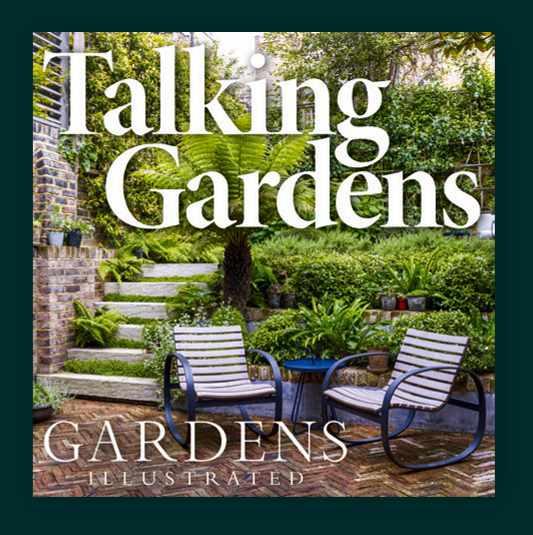

You can find Talking Gardens on Apple Podcasts, Google, Spotify, Acast and all good podcast providers. Subscribe so you never miss an episode.
Having worked together since college, Suzi (left) and Moy now job-share as deputy head gardeners for the walled garden at Knepp Castle
PORTRAIT RICHARD BLOOM
Who has inspired your career? We have shared a career from college to our current position at Knepp – we’re horticultural partners in crime. A huge influence for both of us has been a network of incredible professional women gardeners in Sussex, with whom we have worked for years, sharing jobs, knowledge and raising families. Favourite garden The Old Vicarage in Firle, East Sussex at the foot of the South Downs. It was designed by Lanning Roper and was the first garden we worked in together. Moy still cares for it today and has done so for 18 years. It is a dreamy series of walled gardens, tended with love for generations, which you can feel in every corner. Worthwhile tips Use a good-quality moisturiser, with SPF. Get to know your plants like you would a person – where are they from, what are their likes and dislikes? Don’t be afraid to experiment and play – death is a natural process. Favourite ‘weed’ At Knepp, we reframe weeds as plants that have arrived under their own steam, and they get full consideration in terms of their place in the garden. Biggest challenge facing gardeners today The only constant now is the extremes of our climate and unpredictable weather conditions. It’s important to learn and accept the way your garden moves and changes. What can people do to garden more sustainably? Repurpose everything you can before buying in something new. Look outside your own garden. How do you connect to the wider landscape and what part does your space play? Connectivity instantly allows us to have a greater impact, creating corridors linking nature, people and resources. How have you found the transition to a rewilded garden? It’s been an intense journey of discovery – from dominating the space to thinking of ourselves as part of the ecosystem. We’ve evolved alongside the garden. It’s incredibly freeing to be able to experiment, and it’s a real privilege to reflect upon and then record the garden’s development. Pinch-yourself moments Sir David Attenborough filming in the garden. It was the height of the Covid pandemic, so we couldn’t actually meet him, but it was so exciting to even be in the same space as him. Attending the premiere of Wilding, the film about Knepp. And the arrival of our first pair of beavers on the rewilding project was also a highlight. Instagram @moyfierheller @suzi_turner_ @kneppwilding

We’ve evolved alongside the garden. It’s freeing to be able to experiment, and a privilege to reflect upon and record the garden’s development
GI Read about Knepp Castle walled garden at gardensillustrated.com/knepp
Bring bright, sunny colour to your late-winter garden with the earliest flowers of the year, which will spread to create golden carpets under trees
WORDS JOHN GRIMSHAW PHOTOGRAPHS CLIVE NICHOLS
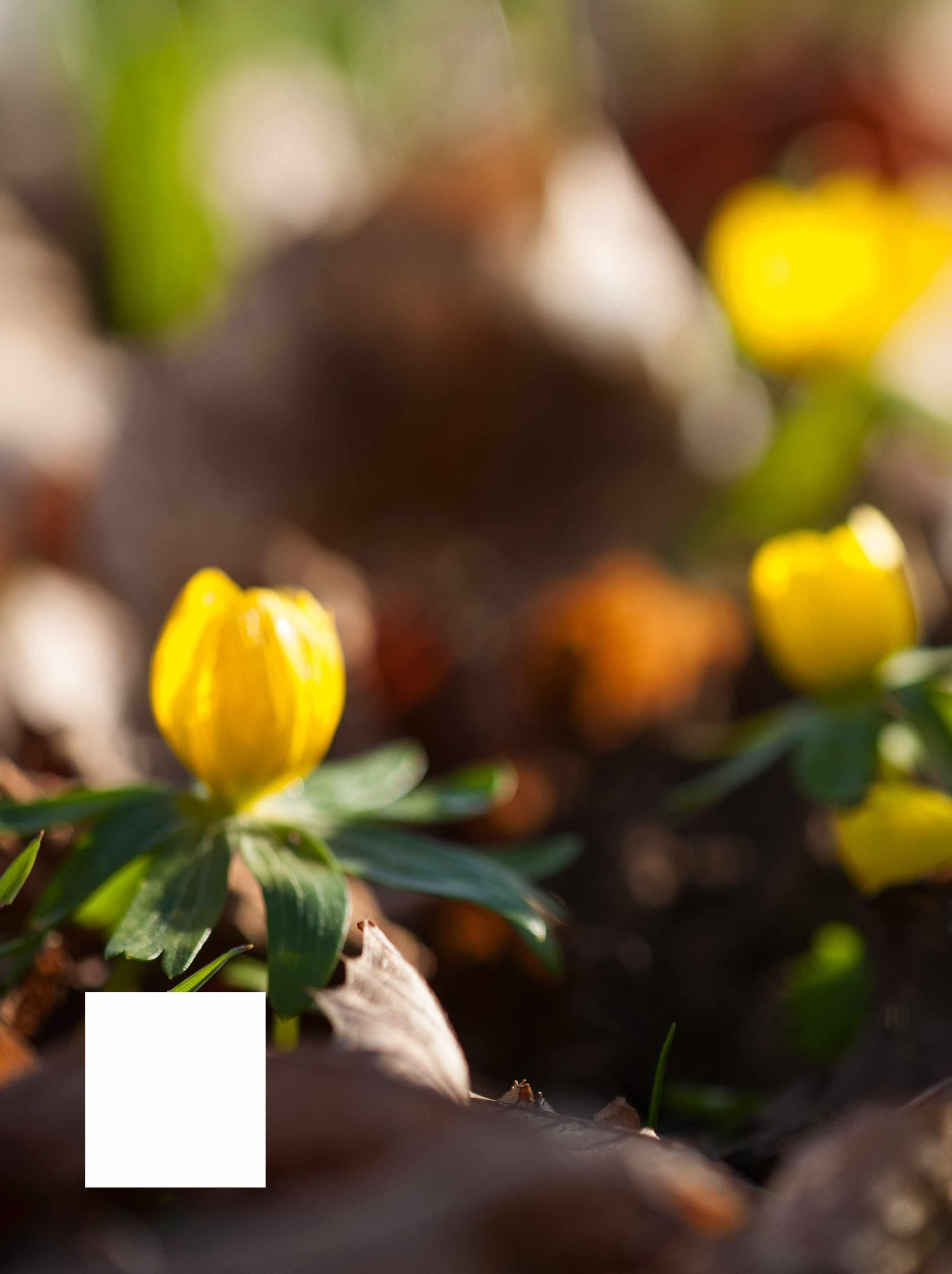
Eranthis hyemalis
With golden goblets held above ruffs of green bracts, winter aconites are an eagerly anticipated forerunner of spring, brightening the drab days of late winter. When conditions are right they will seed freely, producing expanding carpets. Height and spread: 10cm x 10cm.

What Small tuberous perennials, growing as spring ephemerals. The genus is made up of 12 species, three of which have yellow flowers, while the rest have white.
Most of the plants featured here are forms of the yellowflowered species Eranthis hyemalis, commonly known as winter aconite.
Season of interest Late winter to early spring.
Size Most Eranthis hyemalis featured here have a height and spread of 10cm when fully developed.
Conditions Well-drained soil with plenty of light in winter. The Asian white-flowered species are rarely seen in cultivation and need specialist care.
Origins Europe to Japan.
Hardiness All plants featured are hardy throughout the UK and have a hardiness rating of RHS H6, USDA 4a-9b.
*Holds an Award of Garden Merit from the Royal Horticultural Society.

Eranthis x tubergenii
‘Guinea Gold’
Seen here just as the buds are opening, this is a magnificent hybrid cultivar that flowers at the end of the winter aconite season. Propagate by careful division, as the flowers are sterile and do not produce seed. 12.5cm x 12.5cm. AGM*.
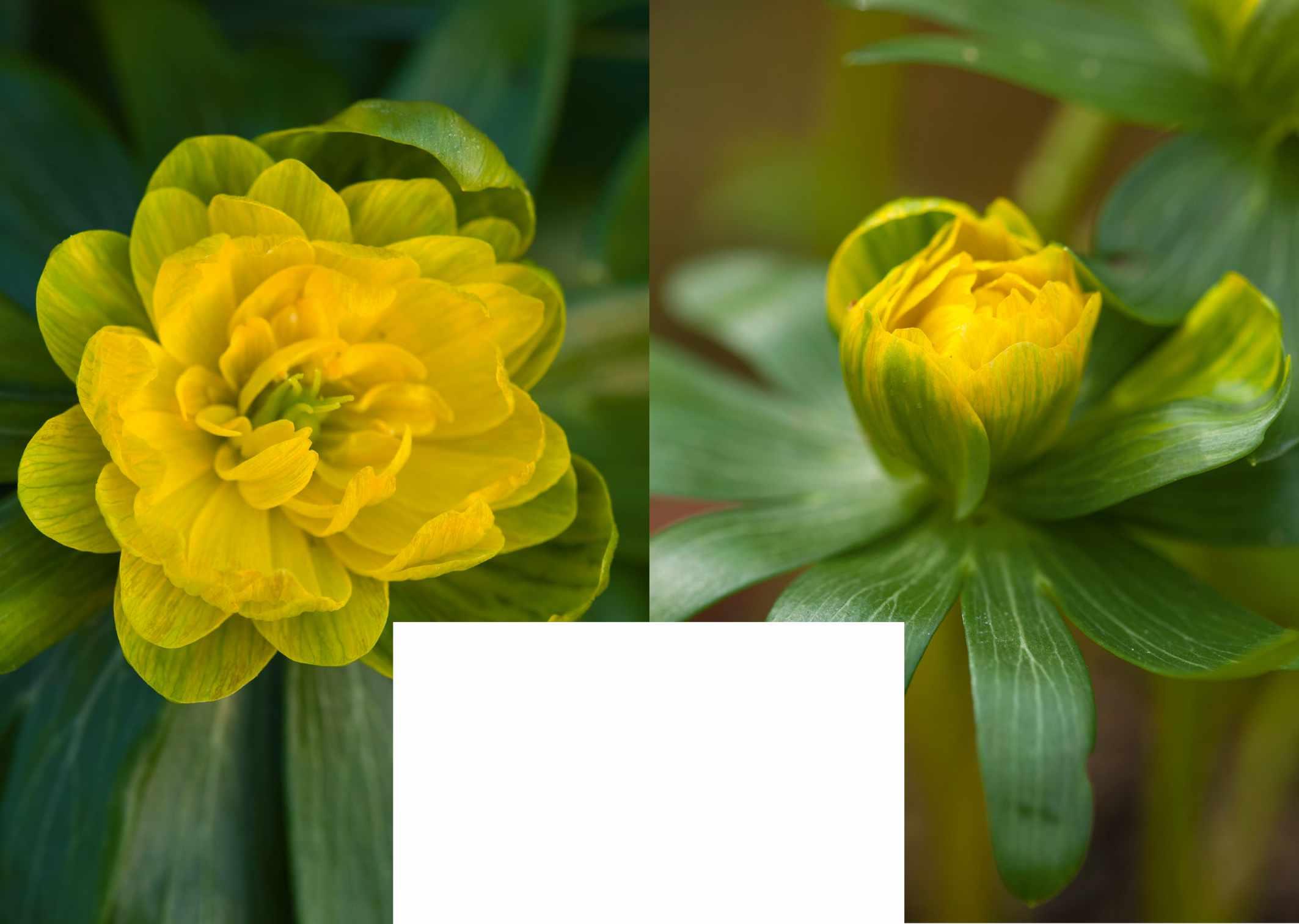
SEranthis Flore Pleno Group
This Group covers all double Eranthis hyemalis, but their flower form can vary somewhat. This one has multiple rows of petaloids, giving a very full effect, but like many doubles it has no anthers. 10cm x 10cm.
Eranthis hyemalis
‘Noël Ayres’
Found at Anglesey Abbey, Cambridgeshire, in the 1950s by the head gardener whose name it bears, and later passed around between enthusiasts. It has tight double flowers, often with a strong dash of green. 10cm x 10cm.
oon after Christmas, I – and if social media is a guide, many other like-minded individuals – can be found out in the garden looking for signs of life from our winter aconites: a crop of postings on first sightings is the result. The appearance of these sunny flowers is a powerful signal that the year has turned and earns them a special place in gardeners’ affections.
Unlike snowdrops and other bulbs with shoots that spear out of the ground, winter aconites shoulder their way up, with the flowering stem forming an arch, the top of which breaks the surface first. As it emerges, it straightens out and pulls up the bud at its tip, protected from this treatment by a ring of bracts. Rather like a butterfly spreading its wings, the bracts and bud quickly expand into a green ruff surrounding the yellow flower.
The central European winter aconite, Eranthis hyemalis, is what most people understand as an aconite – a low-growing tuberous plant with deeply lobed, rounded leaves and bracts of vibrant green, surrounding rounded, yellow, buttercuplike flowers. The other plant commonly called aconite, Aconitum, is the summerflowering monkshood. Early botanists associated Eranthis with those plants through the similarity of its foliage and its toxicity: ‘winter wolfsbane’ was widely used, and by 1633 the English name winter aconite was in use. Although I have never heard of any ill effect from contact with Eranthis by either people (or their
domesticated wolves), it is worth noting that the whole plant is toxic to mammals, and no part should ever be ingested.
In its normal form, Eranthis hyemalis has bright-yellow flowers, opening in sunshine to about 3cm across, when their brightness becomes a wonderful antidote to winter drabness. Appearance time depends on the season, but in a normal, not-toocold winter they are usually in full flower in lowland Britain by late January, continuing well into February, and provide a very welcome source of nectar and pollen for early bees.
There’s a little variation in flowering time between stocks and cultivars: last year I was bowled over by the sight of an immense spread – the best I’ve ever seen – of winter aconites in full flower at Compton Verney, Warwickshire, on 13 January, far earlier than anywhere else; but is that down to genetics or microclimate? In my own garden, the pale lemon-flowered cultivars ‘Lightning’ and ‘Zitronenfalter’ are consistently the first to flower and usually provide that Insta moment in early January, though others would claim ‘Winterzauber’ (normal yellow in colour) as the earliest. Other cultivars usually aren’t far behind, however, and most will overlap to some extent. Later there is a transition from E hyemalis to E cilicica, and the finest of all, E. x tubergenii ‘Guinea Gold’, is also the latest.
I was bowled over by the sight of an immense spread of winter aconites in full flower in January
Numerous named cultivars have appeared in recent decades, perhaps in parallel with the rise of interest in

Eranthis hyemalis
‘Schwefelglanz’
This was one of the first pale selections, found in Germany by Ruth Treff in 1985. The buds are soft apricot and open to a buttery yellow. It comes true from seed if isolated. Try growing it with white Cyclamen coum for a soft pastel effect. 10cm x 10cm.
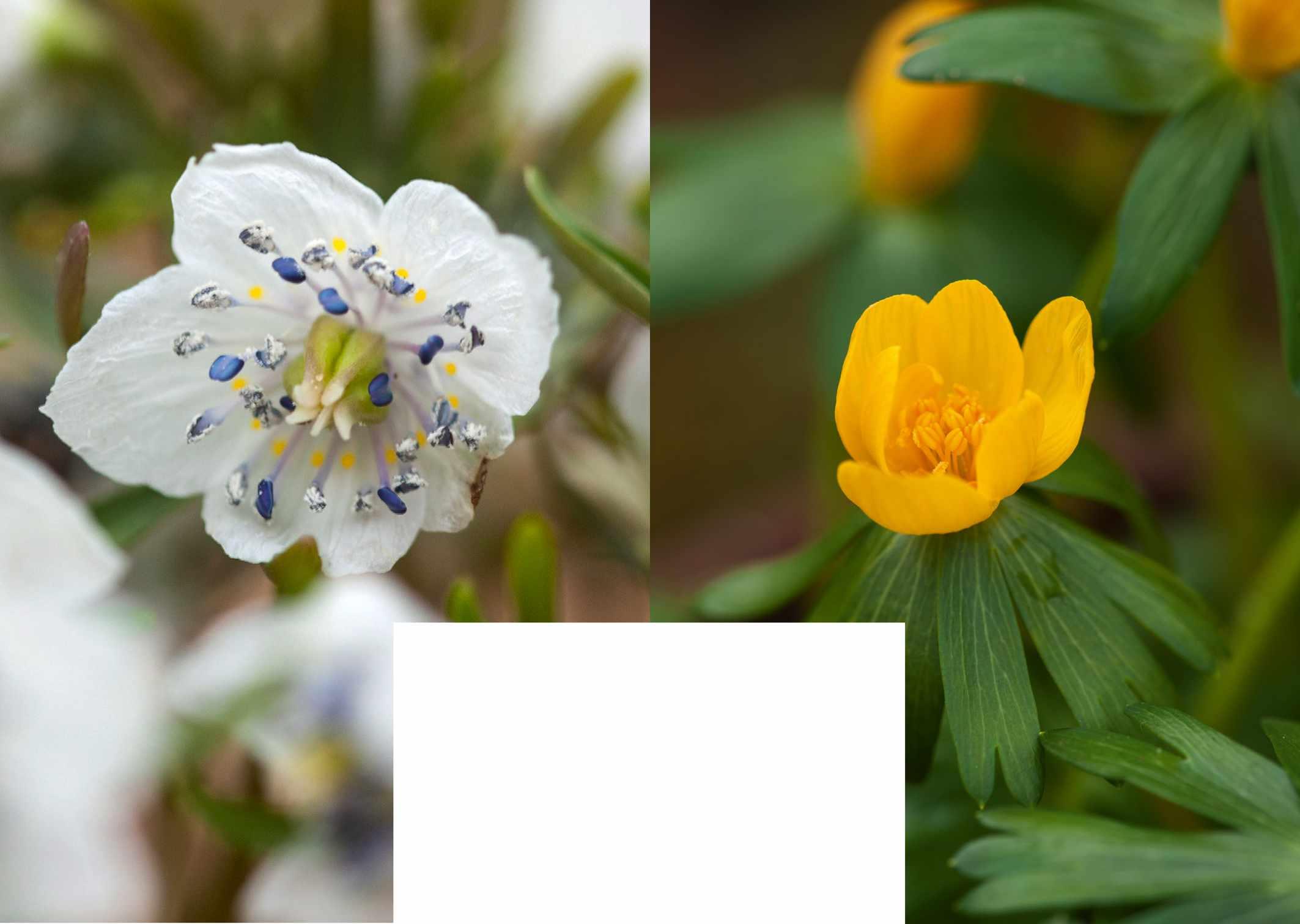
Eranthis pinnatifida
One of a handful of whiteflowered species from the Far East, in this case Japan. Challenging to grow, they are usually the preserve of alpine specialists. The blue anthers give it a very refined appearance. 10cm x 7cm.
Eranthis hyemalis ‘Orange Glow’
With flowers that are a richer egg-yolk yellow than average, the ‘orange’ winter aconites, such as this Danish cultivar, are a valuable addition to the palette. Grow it away from others to keep it true to type. 10cm x 10cm.
• Eranthis that are sold as dry tubers by bulb merchants tend to be E. cilicica They don’t like becoming desiccated, so get them as early as possible and soak in water for 24 hours before planting. Even so, success may be low. It’s preferable to source growing plants in spring.
• Ideal conditions seem to be light well-drained loam that’s alkaline to neutral, without too much competition from dense vegetation. Sparse grass under deciduous trees is an ideal growing location, so long as there’s plenty of light in spring – winter aconites go dormant as the canopy develops, and the next you’ll see of them is their stems heaving out of the ground in January. Where winter aconites thrive they can spread over wide areas and form golden carpets.
• To propagate from seed, look for a ring of capsules ripening above the bracts,
usually in early May. Watch for the capsules opening at their tips and move fast. Sow the seed immediately as it doesn’t stand desiccation. Cultivars can be sown in gritty compost in pots left to stand outside, or seed can be broadcast to new areas by hand – or just cut plants down with a strimmer. In the first year, the only growth is a pair of green cotyledons, followed in subsequent years by single leaves, until flowering size is reached in about the fourth year. Plant in the garden once they’re large enough to handle.
• You can also divide tubers of established plants. As they increase in size, they produce a mix of flowering stems and leaves. The tuber elongates and branches and is easy to divide, simply snapping pieces apart and carefully replanting the divisions. It’s easiest to do it ‘in the green’ while the plants are visible, and unlike snowdrops they take no harm
from this, but division in dormancy is fine too, if you can find the tubers. If it’s dry at the time, keep them well-watered. The tubers should be about 3-5cm deep.
• The most dangerous disease for Eranthis is Urocystis eranthidis, also known as Eranthis smut, a fungal disease that forms open pustules of black spores on the stems and ultimately weakens the plants. If symptoms appear, it is best to remove these plants. Other fungal diseases can occur but are less damaging.
• Snowdrops are the obvious plants to associate with Eranthis. They consistently appear from early January (this winter I spotted some on 27 December) and the white and gold combination is a classic of the winter garden. For a really glorious effect plant them with richest pink Cyclamen coum –February needs all the bling it can get.
Eranthis hyemalis
‘Euan Bunclark’
Found by nurseryman Joe Sharman, who named it after a friend’s late son, this has deeply cut sepals that make it rather distinctive. Select for the most deeply cut sepals when growing it from seed. 10cm x 10cm.
Eranthis hyemalis
‘Lady Lamortagne’
This large, vigorous double has wide, open, greenishyellow flowers that make it quite showy and it is my first choice for a double Eranthis. It will quickly develop into a nice clump. 10cm x 10cm.
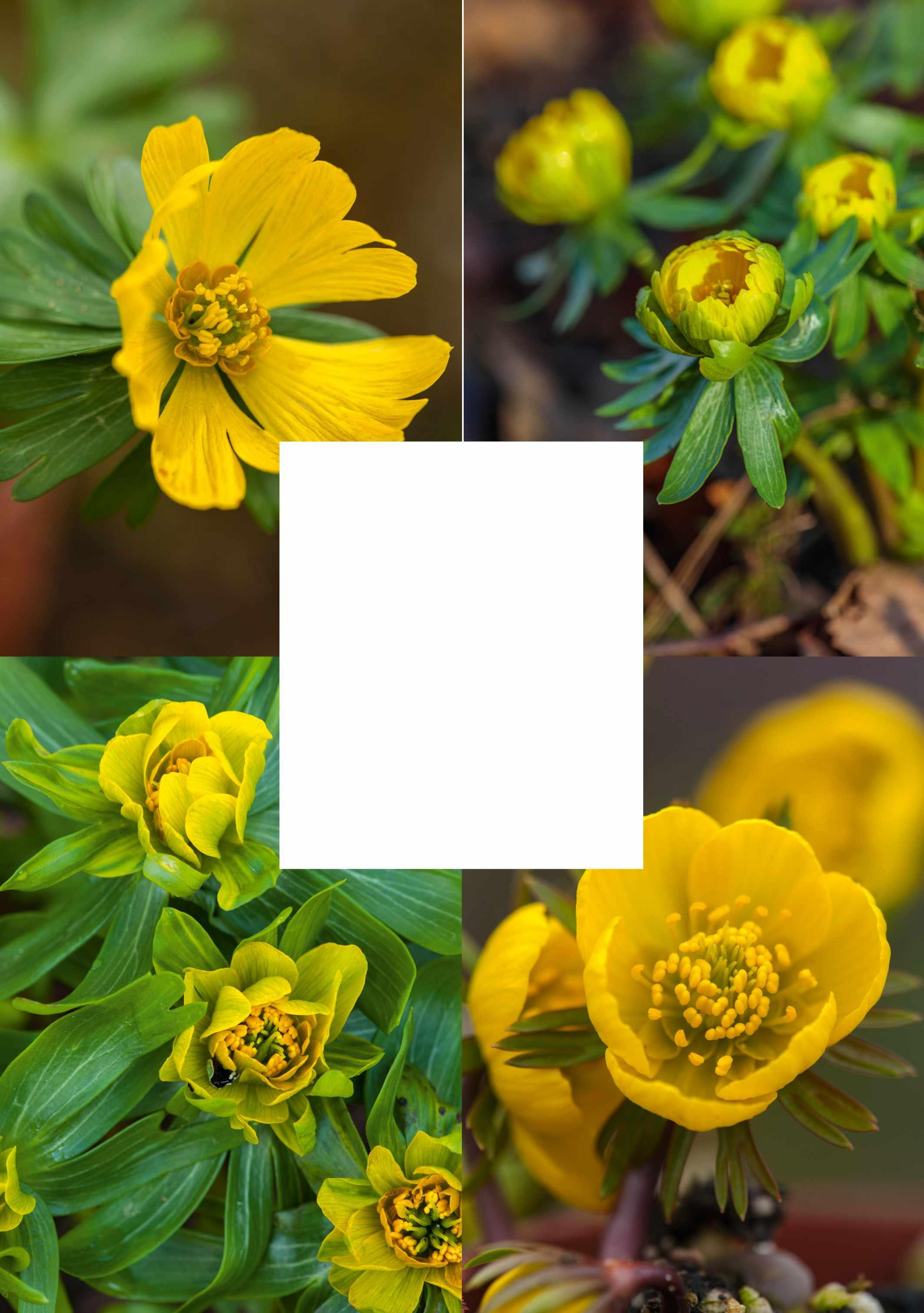
Eranthis hyemalis ‘Doozie’
A semi-double cultivar with strongly incurved sepals that are green externally. It tends to be a fraction taller than most Eranthis and opens earlier than other doubles. 12cm x 10cm.
Eranthis cilicica
This distinct species from Turkey has more finely dissected foliage, narrower bracts and richer colours than E hyemalis. It appreciates a sunny spot that becomes dry in summer. 10cm x 10cm.

Eranthis ‘Grünling’
Its name is the German for a greenfinch, as well as a type of mushroom; it’s single and fertile, with variable green stripes on the sepals adding a dash of interest. Perhaps pair it with Galanthus ‘Greenfinch’ for fun. 10cm x 10cm.
Eranthis hyemalis ‘Andenken an Johannes Raschke’
A very rare mutation transforms the anthers of this German cultivar into green petaloids, producing a fascinating flower with a crested green centre. 10cm x 10cm.
snowdrops, with which they associate so well. They can be roughly divided into those selected for colour (paler or darker towards orange), flower form (semidouble to fully double) or, to some extent, seasonality. Many of these cultivars remain scarce and available only in small numbers at high prices. Among these are ‘Andenken an Johannes Raschke’ and ‘Eleanor Lonsdale’. In both, the reproductive parts are transformed into crest-like green structures, a remarkable mutation that has occurred in Germany and in Pennsylvania, USA, respectively. More abundant cultivars, such as the double ‘Noël Ayres’, lemon-yellow ‘Zitronenfalter’ (German for brimstone butterfly), butter-yellow ‘Schwefelglanz’ (sulphur shine) or the richer ‘Orange Glow’ are available for a few pounds. If the flowers are fertile, they will set abundant seed, and if isolated this will give very similar seedlings – if not, the normal yellow is dominant. A little later than most comes Eranthis cilicica. It is from Turkey and has much redder stems. The leaves and bracts are often bronzed and more narrowly cut, while the flowers are a richer yellow. It looks different, grows differently (liking full sun) and seldom forms clumps. Genetic analysis has now proven its distinctness from E hyemalis, but for a while it was thought to be part of that species and was known as E hyemalis Cilicica Group. It is what is usually sold as dry tubers in autumn, and most pots
For a really glorious effect, plant them with pink cyclamen. February needs all the bling it can get
of aconites in garden centres will be this. It doesn’t seem to persist and spread as E hyemalis does, but will occasionally hybridise with it, to give the usually sterile E. x tubergenii. Of these, ‘Guinea Gold’ is to my mind the finest of all winter aconites. A vigorous plant, it bears large, richly yellow flowers surrounded by pointed bracts – a magnificent sight. As a sterile clone, it can only be propagated by division, so it remains scarce – but you should seek it out as a true ornament to the early spring garden. ■
John Grimshaw is director of the Yorkshire Arboretum.
Where to see and buy
• Anglesey Abbey Quy Road, Lode, Cambridge CB25 9EJ. Tel 01223 810080, nationaltrust.org.uk
• Avon Bulbs Burnt House Farm, Mid Lambrook, South Petherton, Somerset TA13 5HE. Tel 01460 242177, avonbulbs.co.uk
• Cambo Estate Kingsbarns, St Andrews, Fife KY16 8QD. Tel 01333 450054, camboestate.com
• Colesbourne Gardens Colesbourne, nr Cheltenham, Gloucestershire GL53 9NP. Tel 01242 870567, colesbournegardens.org.uk
• Monksilver Nursery Oakington Road, Cottenham, Cambridge CB24 8TW. Tel 01954 251555, monksilvernursery.co.uk
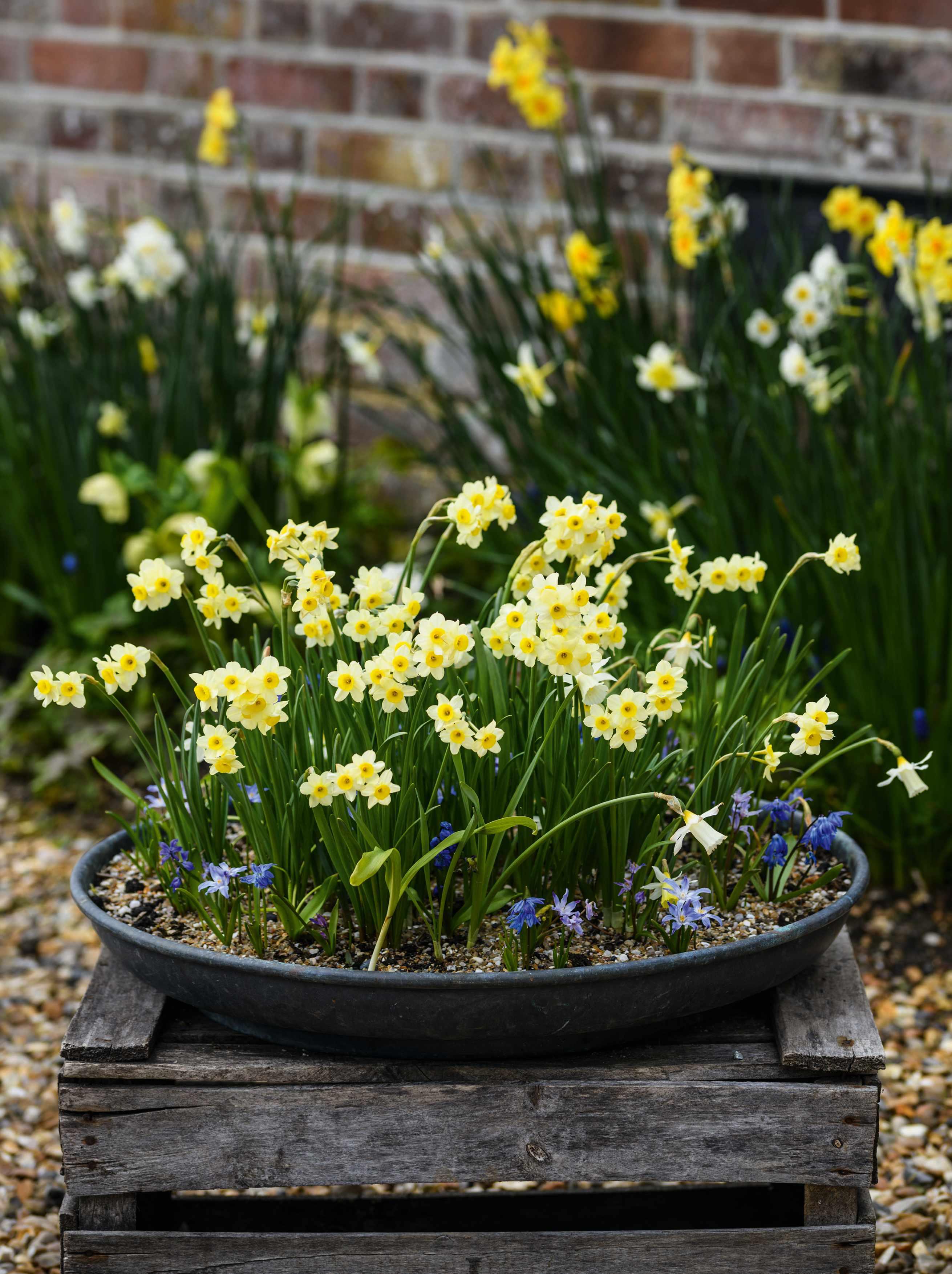
Award-winning designer Jo Thompson kicks off a new container-planting series with three enchanting early spring flower combinations
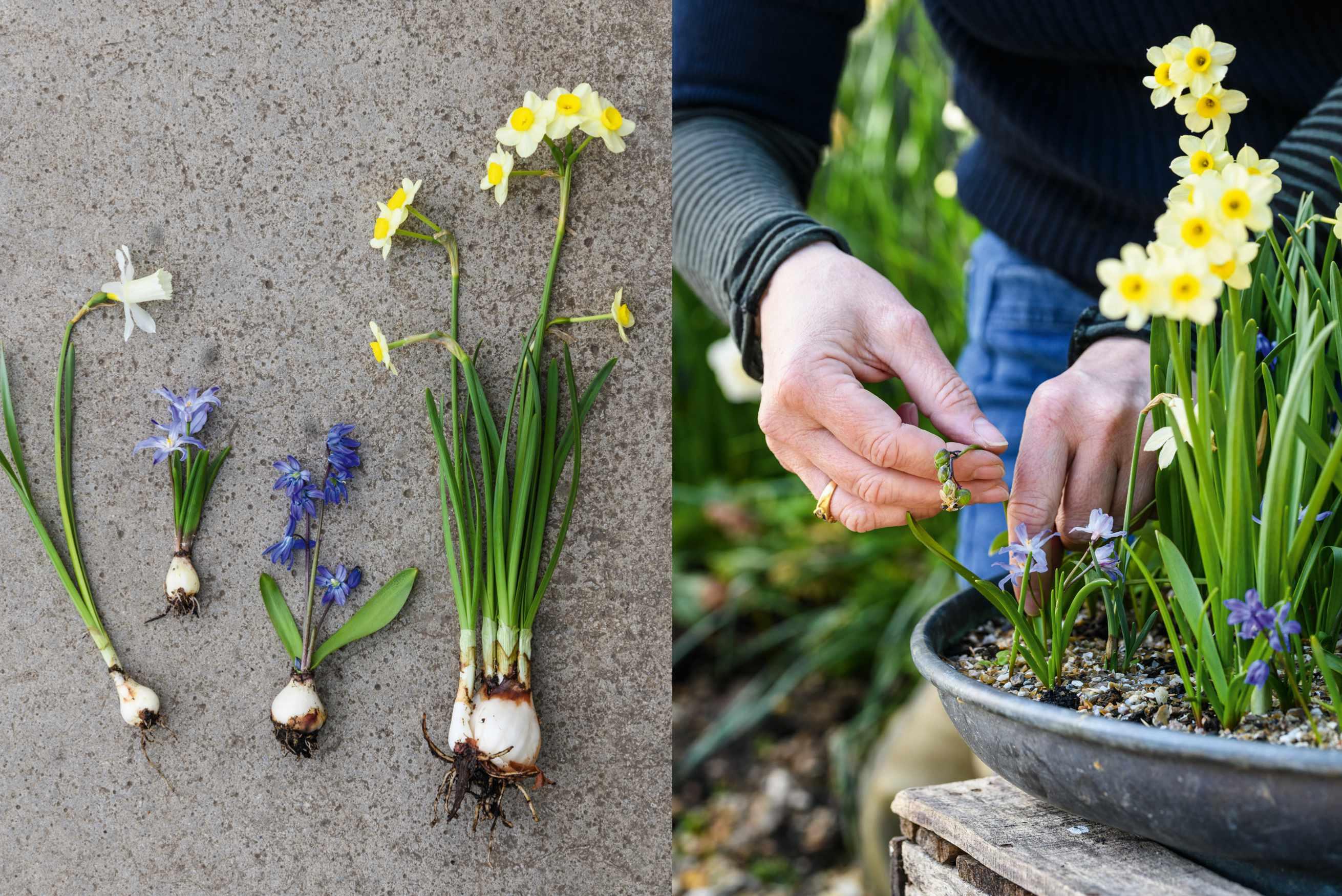
The breathtaking beauty in the tiniest of spring bulbs never fails to enchant. Here, Narcissus ‘Minnow’ and N. ‘Elka’ sprinkle palest yellow cheer across a shallow bronze bowl, creating the perfect, classic, spring colour combination with the blues of Scilla luciliae and S. siberica. This planting is designed to be placed on a table or raised wall so that these small spring jewels can be admired in all their beauty in this little mini-meadow.
Container and composition
Small spring bulbs are so beautiful, but their diminutive size means they can be easily overlooked in the garden, so it’s a really good idea to place them in containers, which can be positioned at a higher level. This bronze ’charger’ is a wide, shallow dish that looks smart placed anywhere that’s raised, for example in the middle of a garden table, and its simple lines allow these miniature bulb beauties to take centre stage.
I set out to create the feeling of a tiny spring meadow full of these softly coloured gems of flowers: the clear and bright blues of the different scillas really are excellent partners, harmonising with the gentlest of lemony-creamy yellows and challenging anyone who says they don’t like yellow to
think again. The dwarf narcissi bulbs are mixed up together and placed around 2cm apart. With simplicity very much in mind, the scillas are then planted at larger intervals at the edges of the dish. I planted these bulbs in autumn, in compost produced on site at Water Lane Walled Garden, the wonderful new garden I am helping to design in Kent. I topped it off with a layer of horticultural grit.
Cultivation and care
Water the container freely as the leaves emerge, and later on deadhead the flowers as they go over in order to ensure next year’s display. This is a container that looks as good empty as it does planted, so you can leave it for the rest of the year as a feature in itself.
1 Narcissus ‘Elka’
A dwarf daffodil with creamy-white petals and the palest of lemon trumpets, which fade to cream. March – April. Height and spread: 15-20cm x 10cm. AGM*. RHS H6†
2 Scilla luciliae
A bulbous perennial with starry, white-centred, bright-blue flowers. February – April. 15cm x 15cm. AGM. RHS H6. USDA 3a-8b.
3 Scilla siberica
A bulbous perennial with purple stems and bright-blue, bowl-shaped flowers. March –April. 10cm x 5cm. AGM. RHS H6. USDA 2a-8b.
4 Narcissus ‘Minnow’
A dwarf daffodil with dainty cream and yellow flowers. March – April. 15cm x 20cm. AGM. RHS H6.
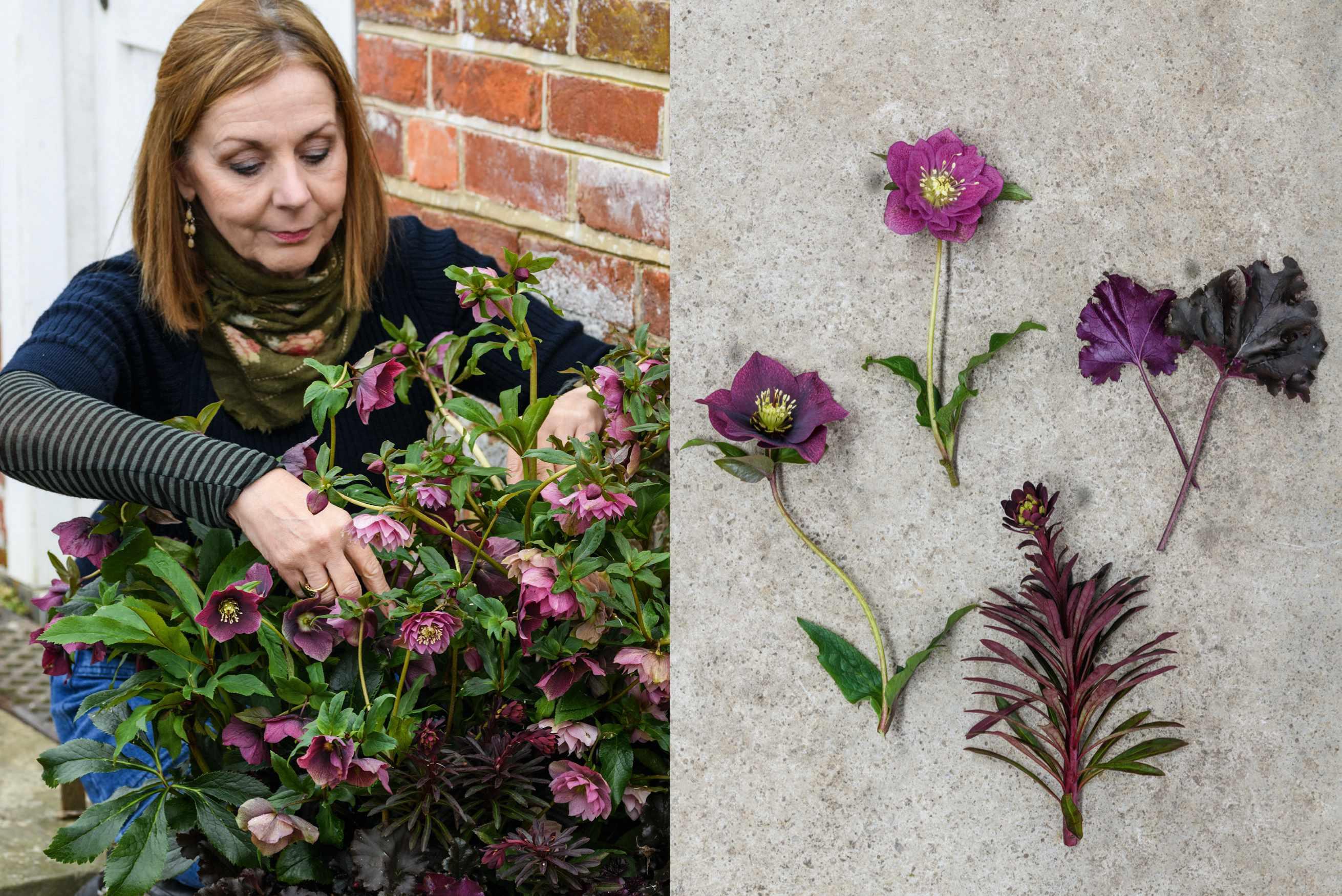
This collection of moody colours brings much-needed depth of interest to the late-winter garden. The palette of Fortuny purples and deep garnets and pinks is effective against a backdrop of grey, looking rich even on the gloomiest of days as the hellebores glow in the low light. Foliage and flowers are equally important: the ruffled leaves of the heuchera create a satisfying contrast with the euphorbia as they emerge out of the aged zinc planter.
Container and composition
This combination benefits from being in a grey planter that harmonises with the colours of the foliage and flowers. An aged zinc container provides the required bulk for the hellebores, while its uncomplicated form allows the plants to take centre stage, creating a dramatic yet elegant statement by a threshold – or anywhere where you can get up close to admire the nodding flowerheads.
Helleborus x hybridus Harvington double pink and H. x hybridus Harvington red form the main eye-catching component of this planting, and it’s their flowers and foliage that we want to celebrate here. The stems aren’t particularly exciting, which is why the foundation of Heuchera ‘Dark Secret’ and Euphorbia Miner’s Merlot (= ‘Km-mm024’)
works so well. Their leaves are in the same wine-purple tones, creating a solid colour base from which hellebore stems emerge.
The hellebores, as the bulkiest plant, go in first and, as this is a pot that can be seen from all sides, it’s a good idea to check there’s an even distribution of blooms as you look around the pot. Place the euphorbias next, remembering to wear gloves to avoid any skin irritation. Last of all, pop in the heuchera to form the base of the design.
Cultivation and care
Deadhead hellebores as the flowers go over, making way for the euphorbia and heuchera. Watering is weather-dependent at this time of year – if a drier period comes along, make sure the soil feels a little moist.
1 Helleborus x hybridus Harvington red
A semi-evergreen perennial bearing large, deep-red, bowl-shaped flowers. 30cm x 45cm. RHS H7.
2 Helleborus x hybridus Harvington double pink
A semi-evergreen perennial producing nodding, pink double flowers from late winter to early spring. 30cm x 45cm. RHS H7.
3 Euphorbia Miner’s Merlot (= ‘Km-mm024’)
Dark-green foliage that emerges a dark burgundy. Bright, lime-yellow flowers April – June. 60cm x 60cm. RHS H6.
4 Heuchera ‘Dark Secret’
Perennial forming a mound of dark-purple, almost black, leaves and sprays of small, white flowers emerging from pink buds in summer. 50cm x 30cm. RHS H6.
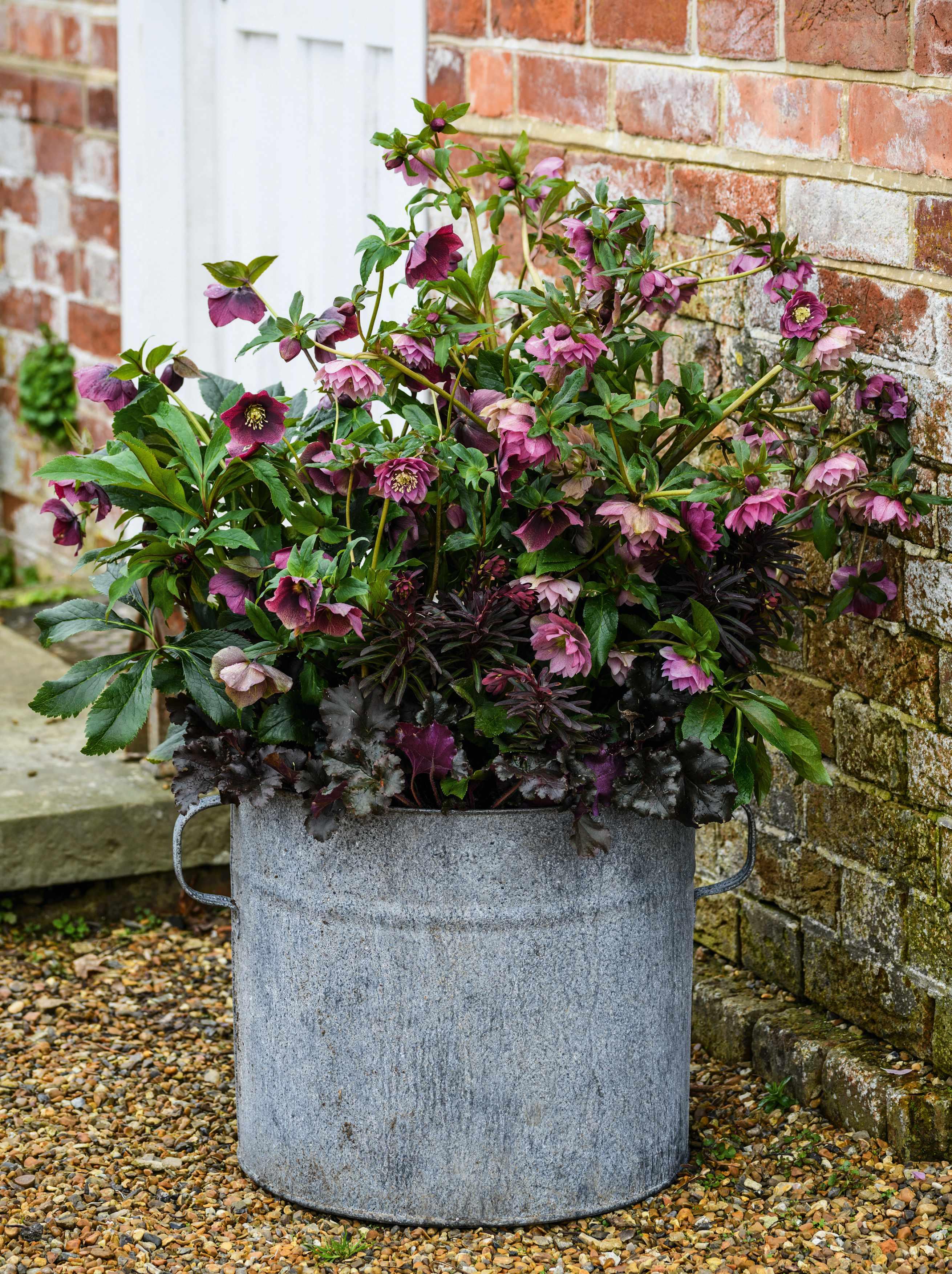
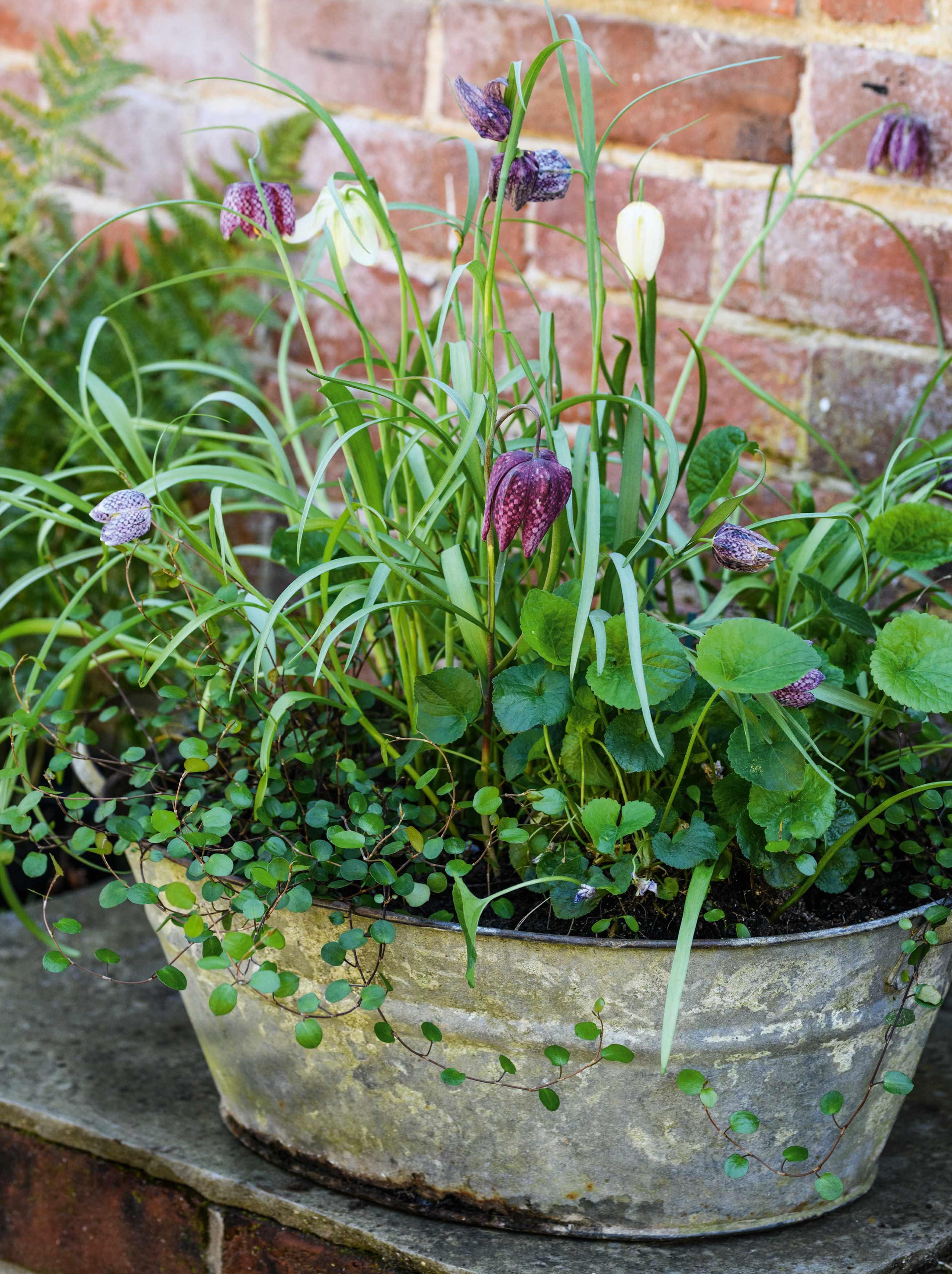

An old bowl was calling out to be planted up with a delicate grouping that provides both flower and foliage interest. It can be moved around to be enjoyed in different locations as the flowers bloom: the elegance of the purple and white forms of Fritillaria meleagris sit easily with the tiny, round leaves of Muehlenbeckia complexa, which in turn create a satisfying link to the larger, heart-shaped leaves of Viola ‘Königin Charlotte’.
Container and composition
This tired, old container was found in a pile outside a junk shop; its handles enable it to be lifted and moved to different spots, so it’s perfect for delicate flowers that benefit from close-up inspection.
Look closely and you’ll see that much of the foliage is in very similar shades of green: it’s actually the difference in the leaf shapes that provides the interest at the base of this planting.
The muehlenbeckia is dotted around the edges of the container, with the viola placed inbetween to create that all-important foundation for the showstopping fritillary, the delicate, tall stems and long, thin, grey-green leaves of which bring height and form to the composition.
The bulbs are planted in autumn; a few months later, their purple and white flowers provide eye-catching focal points in this simplest of arrangements.
Cultivation and care
This container is happy in a little bit of shade. Even after the flowers fade, this collection will carry on giving simple foliage interest all year round, as the muehlenbeckia grows and spills out and over the pot. This is another easily maintained planting; it is growing in peat-free compost, which is just lightly watered so that the soil never dries out. Deadhead the fritillaries once they have flowered to conserve the plant’s energies.
1 Fritillaria meleagris
A bulbous perennial producing nodding purple heads in an exquisite checkered pattern on tall, thin stems and grey-green leaves. April – May. 30cm x 5cm. AGM. RHS H5, USDA 3a-8b.
2 Fritillaria meleagris var. unicolor subvar. alba
This is the pure-white form of the snake’s head fritillary. Its flowers also have a checkered pattern, albeit much fainter. April – May. 30cm x 5cm. AGM. RHS H5.
3 Viola ‘Königin Charlotte’
An evergreen perennial producing sweetly scented, purple-blue flowers. February –March. 20cm x 30cm. RHS H6.
4 Muehlenbeckia complexa
A fast-growing deciduous climber/ groundcover plant with small, green leaves. Works well when contained in a pot. June –November. 2.5m x 2m. RHS H3.
Name Luisenpark. What Redesigned planting for beds and borders at the entrance of a large public park. Where Mannheim, Germany. Size 1,700 square metres of planting within a 103-acre park. Soil Heavy clay soil, improved with light mineral substrate in places. Climate Continental. Hardiness zone USDA 7.
The large, meadow-style perennial beds feature repeated shrubs, including Cotinus ‘Grace’, with perennials such as Aster x frikartii ‘Mönch’ and tall, transparent plants such as Silphium terebinthinaceum
The planting has a stunning backdrop from the existing Albizia julibrissin and A. julibrissin Ombrella (= ‘Boubri’) in blossom.

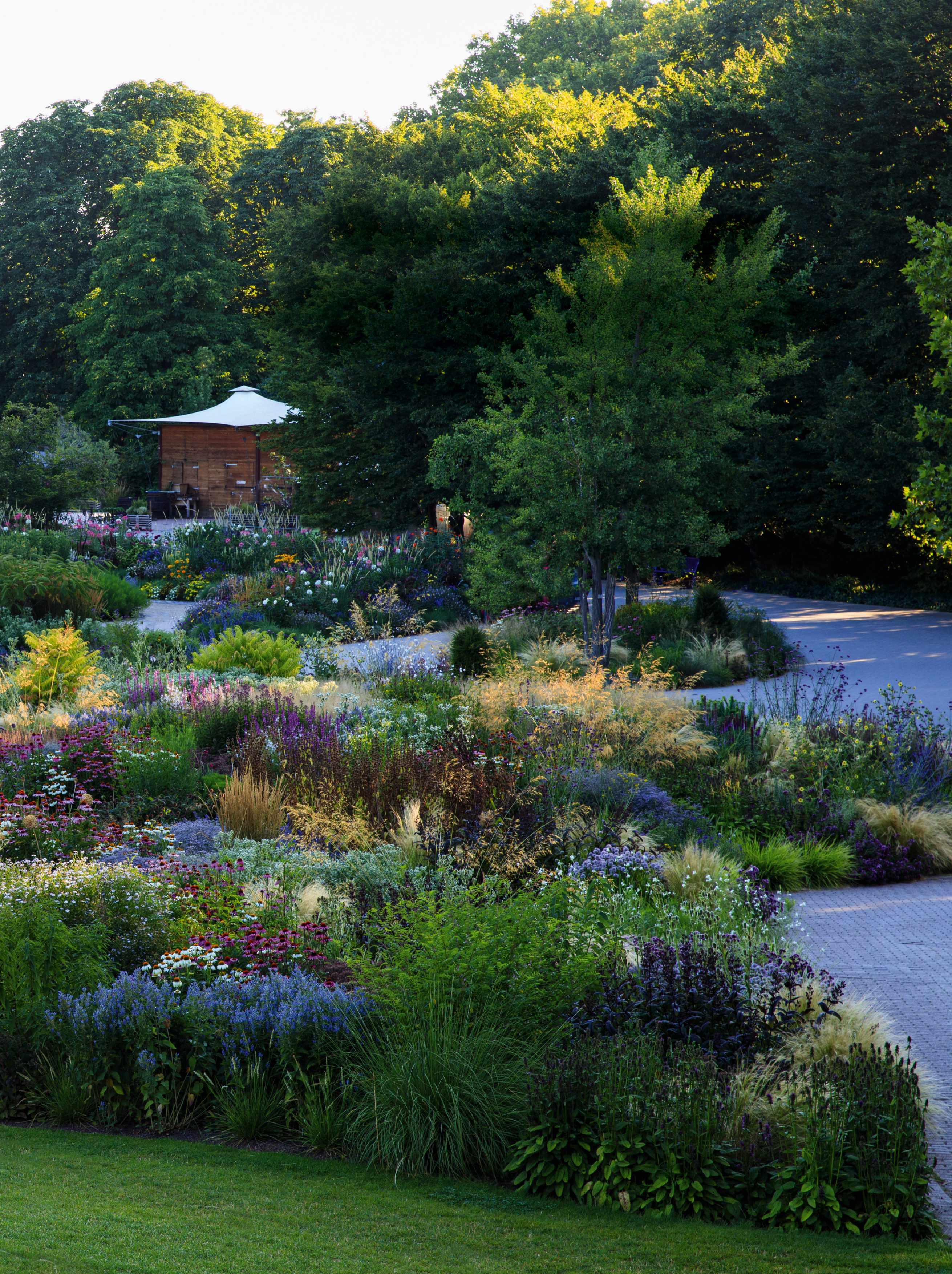
Maverick plantsperson Harald Sauer has burst on to the international horticultural scene with his bold, norm-breaking approach to planting in public parks in Germany
Harald Sauer is the most interesting plantsperson you probably haven’t heard of. A master gardener, he leads the team at Ebertpark in Ludwigshafen, southwest Germany – a public park he has put on the horticultural map with his creative and daring, habitatbased planting designs, including his interesting solutions to the thorny question of maintenance. They range from borders where ground elder is purposely left to mingle prettily with tough perennials, to unusual, eye-popping displays of annuals and tender plants – bedding, yes, but not as you know it.
Those who have already visited marvel at his unorthodox approach, but, owing to a simple language barrier, the rest of us in the English-speaking gardening world have been missing out. That’s likely to change now that Harald has been launched on to the international stage with his new designs for Luisenpark in

the nearby city of Mannheim. It was the venue for the national garden show, BUGA23, and the much talked-about Dynamic Vision Symposium last summer, where the top dogs of planting design came from all over the globe to talk shop. The park was first created back in 1975, as the site for that year’s BUGA, and went on to function – as most public parks do – as a place for leisure activities and often questionable horticulture.
Fast forward to mid-pandemic, in August 2020, when Luisenpark’s horticultural director Ellen Oswald approached Harald about helping to change the park’s entrance area in time for the 2023 show, to add a bit of Ebertpark-style zhuzh. “The plantings were all annuals, very colourful – very old fashioned,” Harald explains. “We went around together and Ellen pointed out several areas she thought we could change.”
Ellen asked him to redo a strip where people come into the park, but he wasn’t convinced it would have any impact. “All the places we looked at added up to about 300 square metres, but they were in single pieces that were just too small to
Rules are good, but it’s also good to break them. It’s always worth provoking conversation, to get people thinking about planting and having discussions
HARALD SAUER, PLANTING DESIGNER, LUISENPARK
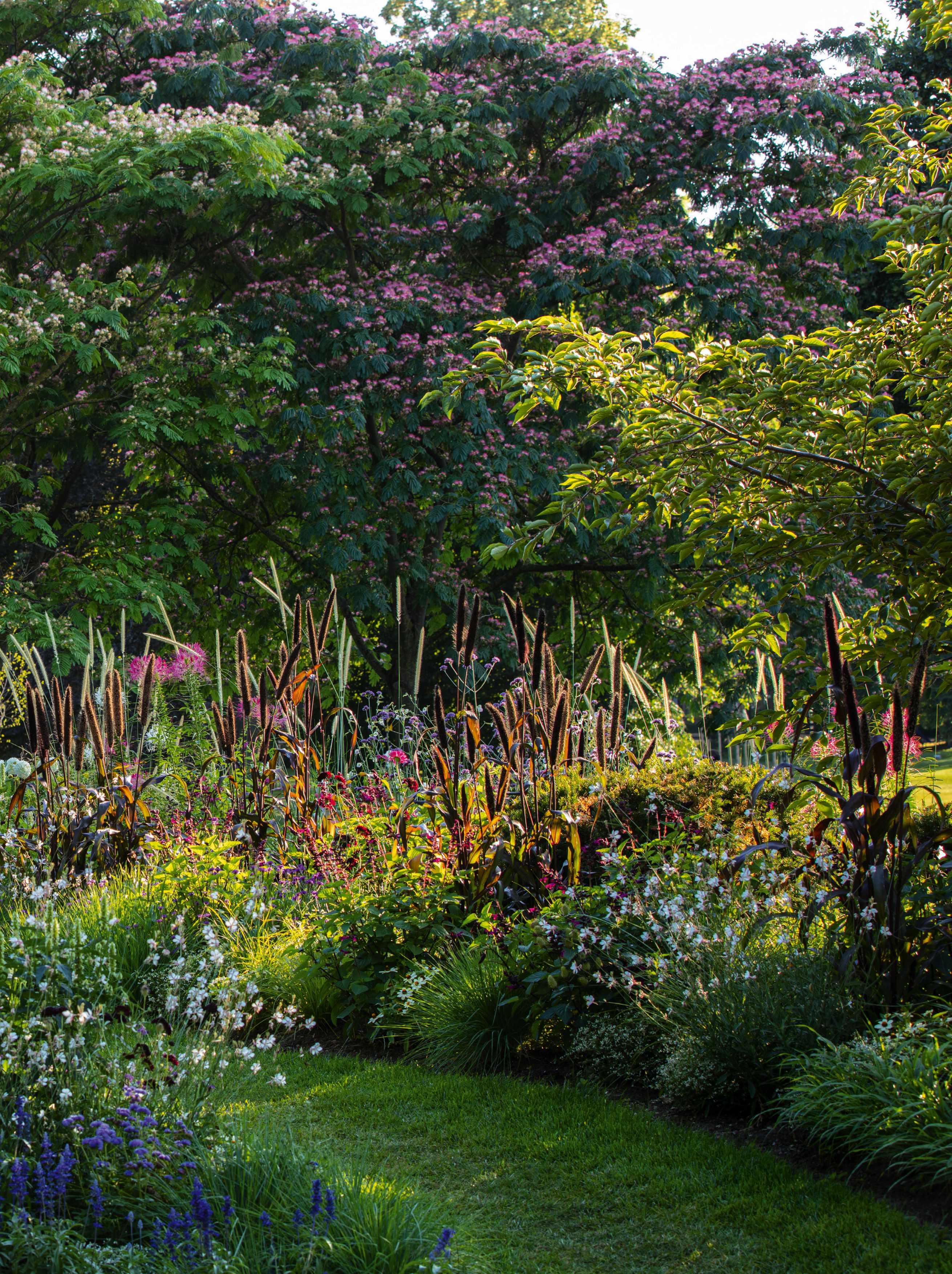
Harald’s new planting design for the seasonal display bed includes rusty-orange Amaranthus paniculatus ‘Hot Bisquit’, short, purple Ageratum houstonianum ‘Blue Horizon’ and dark-blue Salvia Mystic Spires Blue (= ‘Balsalmisp’), spikes of Agastache rugosa f. albiflora ‘Liquorice White’, pale Oenothera lindheimeri ‘Elfenspiegel’ and the striking, brown-red plumes of Pennisetum glaucum ‘Jester’.
create good perennial planting. So I said, ‘If you want me to do it my way, I’ll need a little more space… or a lot more.’” So, Ellen gave him free rein, which was pretty brave, Harald says, because BUGA is a big, months-long show, where everyone expects lots of colourful blooms in bedding displays.
He was more interested in introducing a perennial planting scheme for year-round interest, with lots of structure, not just for the show but for afterwards too – for the long term. In the end, Ellen was so impressed with what he came up with that when he finished, she got him to redo the seasonal display beds too – all told, he redesigned a whopping 1,700 square metres of planting, including a long shady border with a sculpted yew hedge.
The beds are all different shapes and sizes, with lots of variety in style and plant choice. The larger beds in the more open areas are in a meadow style, and the perennial beds beyond offer a more typical border feel, with taller plants.

Harald mixes block planting here with a drift there, and matrix planting with little Easter eggs of special things to surprise the eye. The effect is dynamic. “It creates tension, mixing elements of this and elements of that,” he says. “It’s more exciting when you don’t stick to one style.”
Part of his success here is down to gently altering the layout, just a touch. He introduced grass paths through the scheme so people could walk between and into the beds and feel immersed in the planting; and he modelled and mounded up some beds to better control the views across the park. The other key element is his magical blending of plants, which is all down to the underlying structure, both on the ground plan and in the three-dimensional bulk of the scheme. The base of each section is built upon a matrix of grasses such as Sesleria autumnalis or Sporobolus heterolepis ‘Cloud’ (now so popular that using it in this way is known as ‘sporobolising’
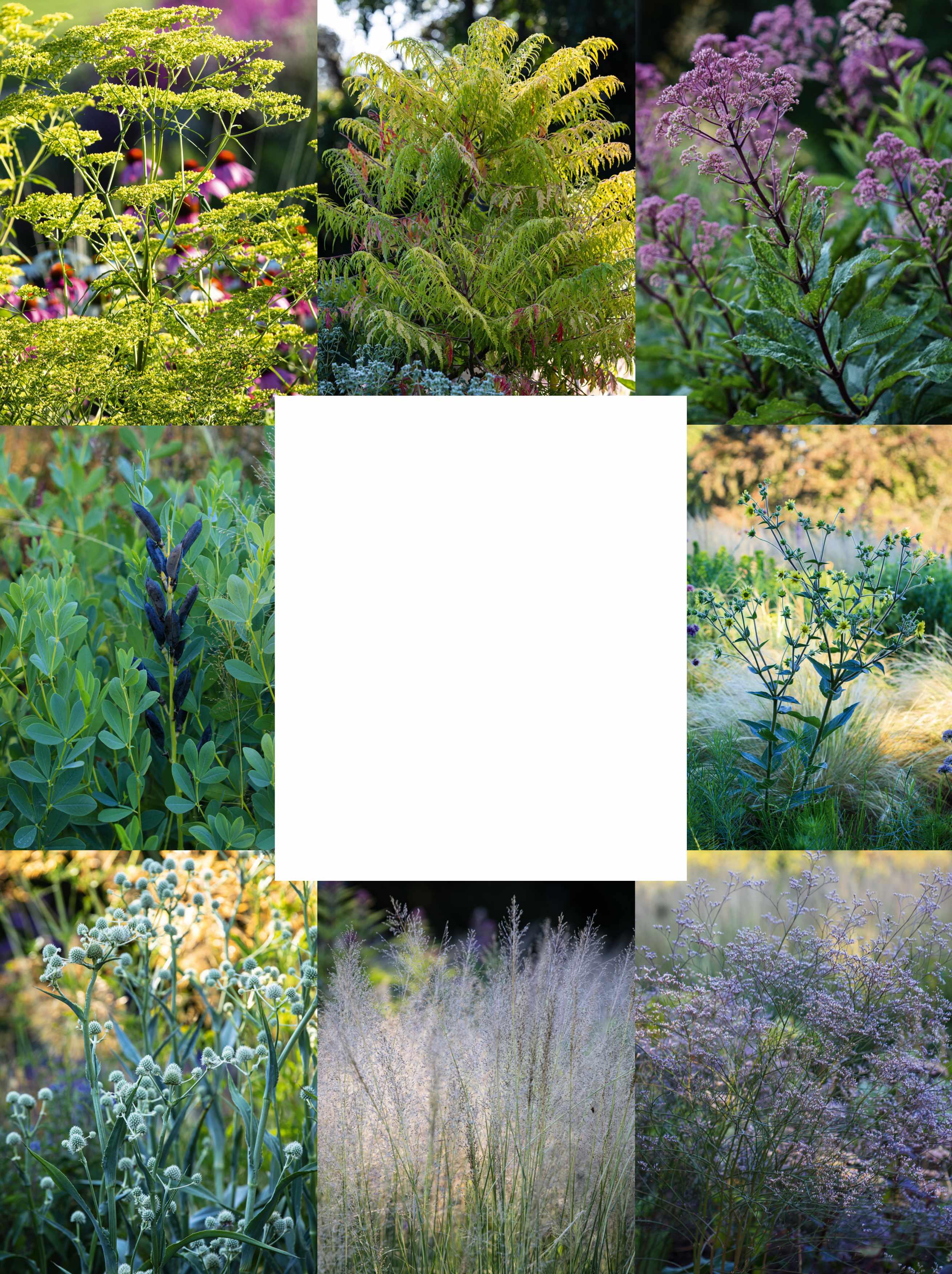
1 Patrinia scabiosifolia Airy, clump-forming perennial with attractive sprays of small, yellow flowers on tall, branching stems in late summer and early autumn. Height and spread: 1m x 50cm. RHS H6, USDA 5a-8b†
2 Rhus typhina Tiger Eyes (= ‘Bailtiger’) Compact tree whose new foliage emerges green, turning to golden yellow then a spectacular fiery orange or scarlet in autumn. 2.5m x 4m. AGM*. RHS H6, USDA 4a-8b.
3 Eupatorium maculatum ‘JS Humble’ Large, dark-pink flowers from July to September. Much loved by pollinators. 80cm x 30cm.
4 Baptisia alba var macrophylla Tall spikes of white, lupin-like flowers in summer followed by bean-like seedpods that turn from green to black as autumn progresses. 1.5m x 1m. RHS H7, USDA 3a-9b.
5 Silphium mohrii Abundant, nectar-rich, light-yellow flowers in late summer on fuzzy, branching stems. Tolerates hot, dry weather. 1.5m x 60cm.
6 Eryngium yuccifolium Dramatic perennial with spiny, sword-shaped, blue-grey leaves. Stiff, branched stems bear small, cone-shaped, whitishgreen flowers, surrounded by spiny, grey-green bracts. Great for adding an upright accent to a border. 1m x 50cm. RHS H4, USDA 3a-8b.
7 Sporobolus airoides ‘JS Delicatesse’ Graceful, tufted grass with slender stems bearing delicate, silvery-pink flower spikes in summer, turning yellow in autumn. 60cm x 60cm.
8 Limonium platyphyllum The sea lavender produces a cloud-like mass of tiny, papery, lavender-blue flowers in summer. Good for hot, windy and coastal locations. 1m x 50cm. RHS H7, USDA 3a-9b.
*Holds an Award of Garden Merit from the Royal Horticultural Society. †Hardiness ratings given where available.
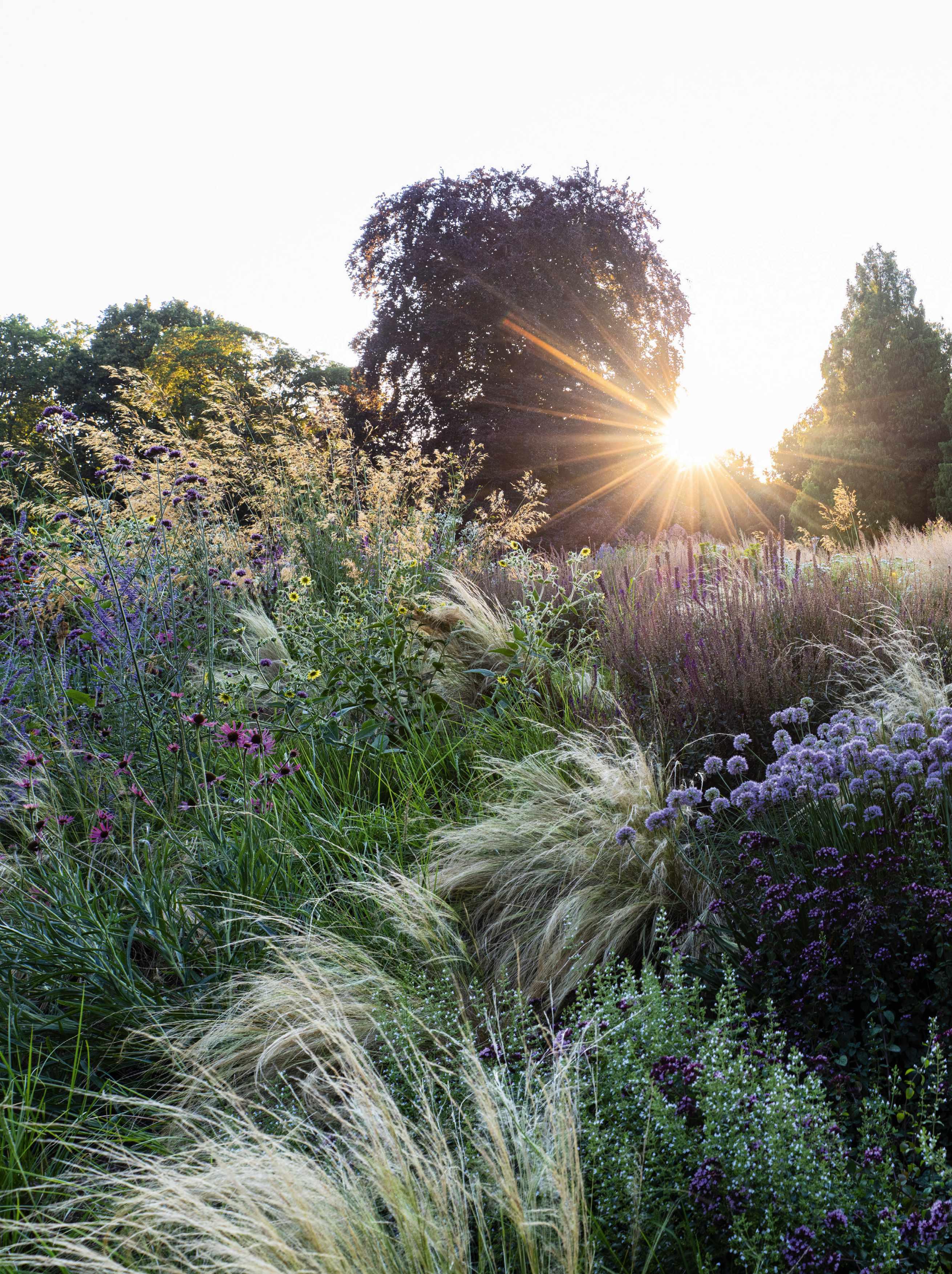
It’s more exciting when you don’t stick to one style. The effect is dynamic. It creates tension, mixing elements of this and that
a planting). Shrubs such as Cotinus ‘Grace’ and Rhus typhina Tiger Eyes (= ‘Bailtiger’) are dotted throughout, while the mass of the planting is taken up with perennials such as Echinacea pallida ‘Hula Dancer’, Liatris spicata, Helenium ‘Little Orange’, Nepeta racemosa ‘Walker’s Low’ and Rudbeckia subtomentosa ‘Henry Eilers’. Vertical accents from tall, airy perennials such as Harald’s beloved Patrinia scabiosifolia and Silphium mohrii anchor the scheme, and their repetition ties all the disparate parts of the planting together.
The scheme is also much more sustainable than what was here previously – longer-lasting, better for biodiversity and more resource-efficient. Many people who design planting for public spaces work to a formula or percentages, so they know how much maintenance it will take to look after each area, but Harald simply picks plants that he wants to use. His choices are a mix of ubiquitous garden plants, such as Verbena bonariensis, and rare, wonderful things you won’t find at the local garden centre, such asVernonia ‘Elephant’. Harald admits that he’s not all that bothered about colour, though he couldn’t resist adding

some clashes and crashes with orange, hot pink or acid yellow. For him, it’s more about the structure, the texture and the movement in the planting and in single plants.
The most confronting element of this is brown seedheads in a summer display, with allium and phlomis skeletons that would have been deadheaded in any other park left standing intentionally, for structure. We may have embraced Piet Oudolf’s mantra of ‘plants that die well’ in our winter gardens, but are we ready to accept them in our summer schemes too? “Rules are good, but it’s also good to break them,” Harald says. “It’s always worth provoking conversation, to get people thinking about planting and having discussions.” ■
With special thanks to Antje Birner for continuous translation
USEFUL INFORMATION
Address Luisenpark, Theodor-Heuss-Anlage 2, 68165 Mannheim, Germany. Web luisenpark.de Open Daily; check website for times.
The world-renowned botanist on his sideline in crime fighting, getting a doctorate in his thirties and the potential of mushrooms to tackle climate change
WORDS PAULA McWATERS PORTRAIT LISA LINDER
Dr Mark Spencer reckons that plants are woven into the fibre of his being. “I’ve been obsessed with them since I was a toddler growing up in rural Warwickshire,” he says. “I dream about them and I navigate my way around towns and cities by remembering something that’s growing on a street corner.” Certainly, his every waking hour is spent working with plant material, whether he is advising on invasive species, teaching a class on plant identification, looking after the unique herbarium samples at London’s renowned natural history institute, the Linnean Society, or studying flora to help piece together what has happened at a crime scene.
This latter endeavour – forensic botany – has become one of Mark’s specialities over the past 15 years, ever since he received a chance call from a detective when he was working as botany curator at the Natural History Museum in London. “I’d never been involved in forensics before, but a man’s body had been found in a ditch and the police asked me whether I could tell them how long it had lain there.” Plants, it seems, can provide vital evidence in serious crime scenes. The growth patterns of brambles, for example, are surprisingly ordered and can help establish a timeline. “By studying the number of stems and their rates of degradation, you can unpick the chronology. Establishing that a body has been there for, say, eight or nine years is so useful to the police in narrowing down records of missing people.”
fun – being in my little scientific bubble staring down a microscope looking at fungi grow.” The Linnean Society of London, where he has been honorary curator for the past decade, played a vital role in his achieving his doctorate. “As a working-class lad, I couldn’t have afforded to do a PhD, but the Society, together with my supervisor, helped find the funding from a private donor.”
Caring for the Society’s precious resources has helped Mark develop a strong affinity for historic botany. “The vault contains the personal collections of Carl Linnaeus, the father of modern taxonomy. These are globally important foundational materials for understanding plant diversity.” At the Natural History Museum, where he worked for 12 years, until 2016, first as a research assistant on Carl Linnaeus and then as the curator of the British and Irish Herbarium, he and fellow scientists used the collections to research the impacts of climate change on biodiversity, another subject he is passionate about.
Trace evidence can help unlock a mystery too, when fragments of plant material – a single leaf stuck to a shoe or a car tyre, for example, or pollen attached to clothing – can help pin a suspect to a crime scene. It is painstaking, meticulous work and Mark’s accrued knowledge of British plant life and years of rigorous scientific study make him ideally suited to it. Even so, it has taught him to look at plants in a different way. “You need to take in the whole scene, not derive a hypothesis from the first thing you see. The accuracy of my report is vital and I feel I am doing something really valuable that can help give hope and some closure after tragedy.” Now aged 55, he feels it is one of the things he is most proud of in his life.
Early on, it was always assumed that Mark would go into gardening, but two years into the Kew Diploma in Horticulture he had “the creeping realisation that this was the wrong path” and left. After a few years of dithering, the pull of plants came back, and, at 27, he signed up for a botany degree at Reading University, closely followed by a doctorate in mycology. “That was the most
Mark is also the London Natural History Society’s vascular plant recorder, which gives him an overview of Greater London’s flora. “A massive survey, spanning more than 20 years and involving dozens of volunteers, is underway and we know that London’s biodiversity is in serious decline. We are at risk of losing two-thirds of our native flora here and that is tragic.”
Causes include habitat degradation, poor conservation management and the expansion of invasive species such as buddleja, which, says Mark, are causing widespread ecological damage by out-competing other native plants.
“A depleted natural world is a less beautiful and rich world for all of us. Cities are important early warning systems for what is happening on a wider scale. Globally, loss of biodiversity is a risk to agricultural systems as well as to human wellbeing.”
These losses, together with the threats from climate change, give Mark serious cause for concern, but one area of plant science that he sees as a ray of hope is mycology. “There were no jobs in mycology when I completed my PhD, but now this is one of the great areas of exploration for our biodiversity. Fungi, along with bacteria, are biochemical wonderlands,” he explains. “They are the future, offering so many possibilities in new materials, new science and our understanding of the natural world.” ■
USEFUL INFORMATION
Find out more at markspencerbotanist.com. For details of guided tours and upcoming events at the Linnean Society of London, see linnean.org



Designer Sam Taylor-Hunt shares his design for a vibrant, perennial, meadow-style scheme you can sow direct from seed, with advice on how to create this exciting new type of planting
ILLUSTRATIONS HANNAH McVICAR
As a garden designer and soft landscaper, I’ve put together my fair share of beautiful borders, planting countless spring bulbs, small pots and bareroot roses. But recently my imagination has been set alight by a completely new way of creating riotously colourful beds of herbaceous plants, with a planting style and process known as a seeded perennial meadow (SPM).
You may have seen SPMs used to amazing effect by Professors James Hitchmough and Nigel Dunnett at the Queen Elizabeth Olympic Park, created for the 2012 London Olympics. Since then, SPMs have started popping up in botanical gardens, such as Oxford and RHS Garden Wisley, and large charity-held estates, including Chatsworth House.
An SPM is, in short, an area of dense planting that returns every year, composed of herbaceous perennials and grasses, grown predominantly from seed sown directly on to a prepared substrate.
SPMs are markedly different from our UK native meadows. Most keen gardeners will be familiar with grass-dominant native UK meadows and can recognise wildflowers like knapweed, ragged robin and (sometimes) rare wild orchids. We mark the seasons with their arrival in May, and their mowing at the end of the summer.
SPMs are designed to stay standing for the whole growing season, with flower colour starting in April, and running right through to autumn, providing more beauty and cover for wildlife than any standard native meadow.
When designing an SPM, I’m looking to create a high degree of density within the planting, as well as variety in leaf textures, and distinctions between different height layers. Regular UK meadows typically grow to a single height – imagine walking through thigh-high pasture. SPMs, on the other hand, usually have around 80-120 plants per square metre, with clear layers of planting and much more diversity in height, with some of the flowers reaching above head height.
When putting together a seed list for an SPM, I draw on plants from around the globe, taking inspiration from landscapes ranging from the North American prairies to the South African Drakensberg. Each of these plants has evolved to exploit different niches, to grow and flower at different times of the year. By combining them in the right proportions, it’s possible to create an exotic and unique display that flourishes throughout the growing season.
This is no easy task, considering we must whittle down the thousands of species available to create a seed list of around 20-25. First, it’s important to remember that we shall be broadcasting this seed directly on to open ground, so plants must be able to germinate in our specific climate and hardiness area – in this case, the UK. James Hitchmough’s book Sowing Beauty is full of data on this aspect and is the first port of call for anyone looking to create their own SPM. Second, we want stronggrowing plants, able to seed and reproduce successfully. Because of this, I have avoided fussy cultivars and any species with double flowers. Consider how the border will develop over time. It’s no use creating a beautiful mix of slowTo continue turn to page 80
This exclusive seeded perennial meadow scheme for Gardens Illustrated readers is intended for a border or bed of about ten square metres, but can be adapted to a larger area. I designed it to peak in July and August with sizeable perennials and hot-coloured flowers, but it will provide interest throughout the growing season.
The mix kicks off in mid-spring with low hummocks of colour coming from primulas, Euphorbia and polemoniums. These latter two stress-tolerators, along with geums and heucheras, will go on to form the groundcover through the rest of the season. In May, the crowns, grasses and perennials all knit together, creating a carpet through which will dance some familiar meadow ruderals, such as fox-and-cubs (Pilosella aurantiaca), honesty (Lunaria) and lady’s bedstraw (Galium verum).
In summer, the competitors really start to take off, with the textures of warm-season grasses, the structures of Berkheya and Knifophia leaves and the filigree of fennel foliage. These plants create a gauzy framework through which the towering coneflowers of Rudbeckia and Ratibida can grow and shine out in late summer.
1 Primula vulgaris The pale-yellow flowers of the wild primrose provide welcome colour very early in the year. Height and spread: 20cm x 10cm.
AGM*. RHS H7, USDA 4a-8b†
2 Euphorbia epithymoides Perennial that forms a mounded shape. Masses of acid-yellow flowers in spring. 40cm x 40cm. RHS H6, USDA 4a-8b.
3 Lunaria annua Honesty. Purple flowers in late spring and early summer, followed by silvery seedpods. 75cm x 50cm. RHS H6, USDA 5a-9b.
4 Polemonium caeruleum A tall perennial bearing sprays of sky-blue, bell-shaped flowers in early summer; self-seeds freely. 80cm x 50cm. RHS H7, USDA 4a-8b.
5 Hippocrepis comosa Low-growing perennial with yellow, pea-like flowers from May to July. Also known as horseshoe vetch. 10cm x 10cm.
6 Galium verum Perennial wildflower that bears a froth of sweetly scented flowers in summer. 50cm x 50cm. RHS H7, USDA 4a-8b.
7 Pilosella aurantiaca Bears small, dandelion-like flowers in shades of russet in summer. Also known as fox-and-cubs. 30cm x 1m. RHS H5.
8 Dianthus carthusianorum Magenta flowers with fringed petals from summer to autumn, above grassy foliage. 40cm x 40cm. RHS H7.
9 Melica altissima ‘Atropurpurea’ Deciduous grass that forms clumps of soft-green foliage topped in midsummer by pinky-purple flowers. 80cm x 50cm. RHS H6.
10 Geum triflorum Attractive, hairy, ferny foliage. The nodding red flowers are followed by feathery seedheads. Also known as prairie smoke. 45cm x 45cm. RHS H7, USDA 3a-7b.
11 Kniphofia ‘Grandiflora’ Large, eye-catching flower spikes in brilliant red and yellow, produced from early summer to early autumn. 90cm x 50cm. RHS H5.
12 Echinacea pallida ‘Hula Dancer’ A hardy evergreen perennial with pink-flushed, reflexed flowers that have a light scent. 75cm x 50cm. RHS H5, USDA 3a-8b.
13 Berkheya purpurea ‘Zulu Warrior’ Thistle-like perennial that bears silver-blue flowers with dark-purple centres in summer. 90cm x 50cm. RHS H4.
14 Rudbeckia occidentalis ‘Green Wizard’ Unusual, statuesque perennial. The central chocolate-brown cone is surrounded by green phyllaries, giving the impression of a green flower. 1.8m x 1.8m. RHS H7, USDA 3a-9b.
15 Foeniculum vulgare ‘Purpureum’ Upright perennial with finely divided foliage that is tinged purple when young. Flat, yellow flowerheads in summer. 1.8m x 1m. RHS H5, USDA 4a-9b.
16 Hymenoxis hoopesii Golden-yellow petals around a darker cone. Flowers May to September. 90cm x 50cm. RHS H5.
17 Ratibida pinnata Flower petals droop attractively around a central dark cone in high summer. 1.2m x 50cm. RHS H6, USDA 3a-8b.
18 Silphium laciniatum Very tall perennial with large, deeply cut leaves and yellow, daisy-like flowers in summer. 3m x 1m. RHS H7, USDA 3a-8b.
19 Heuchera villosa ‘Autumn Bride’ Large, freshgreen leaves and panicles of white flowers in late summer and autumn. 50cm x 50cm. RHS H6, USDA 3a-8b.
20 Coreopsis ‘Sterntaler’ Masses of brightyellow flowers with a central brown-red circle in summer. 60cm x 50cm. RHS H5.
21 Sanguisorba officinalis An upright perennial with grey-green leaves. Bears clouds of small red-brown flowers from early summer to mid-autumn. 1.2m x 50cm. RHS H7, USDA 4a-8b.
22 Oenothera biennis The pale-yellow flowers of the evening primrose open in the evening in summer and autumn. Biennial. 1.5m x 50cm. RHS H7, USDA 4a-9b.
23 Bouteloua gracilis Unusual deciduous grass with brush-like flowers. Also known as mosquito grass. 60cm x 50cm. RHS H6, USDA 3a-10b.
24 Calamagrostis brachytricha Clump-forming grass with purple-tinged, silver-grey flower plumes. 1.5m x 1m. AGM. RHS H6, USDA 4a-9b.
25 Symphyotrichum novae-angliae Vigorous aster with abundant sprays of large flowers well into autumn. 1.7m x 90cm. RHS H7, USDA 4a-8b.
*Holds an Award of Garden Merit from the Royal Horticultural Society.
†Hardiness ratings given where available.
Head to gardensillustrated.com/SPM to download the plant list and seed quantities guide.
21 16 1 11 6 1 MAAYKE DE RIDDER; 2, 6 & 19 RICHARD BLOOM; 3 SHARON PEARSON; 4 SHAPENCOLOUR, 5 FRANK TEIGLER/HIPPOCAMPUS BILDARCHIV, 7 SALLY ANDERSON, 9 & 13 P TOMLINS, 10 PETER JACOBSON, 11 OREST LYZHECHKA, 14 TIM GAINEY, 18 DAVID SAUNDERS; 21 MARTIN HUGHES-JONES, 22 IMAGEBROKER.COM GMBH & CO. KG, 23 FLORAPIX, 25 PAVEL CHEIKO / ALL ALAMY STOCK PHOTO; 8, 12, 15, 17 & 24 JASON INGRAM; 16 NOVA PHOTO GRAPHIK / GAP PHOTOS; 20 INGESCHE / GETTY IMAGES.

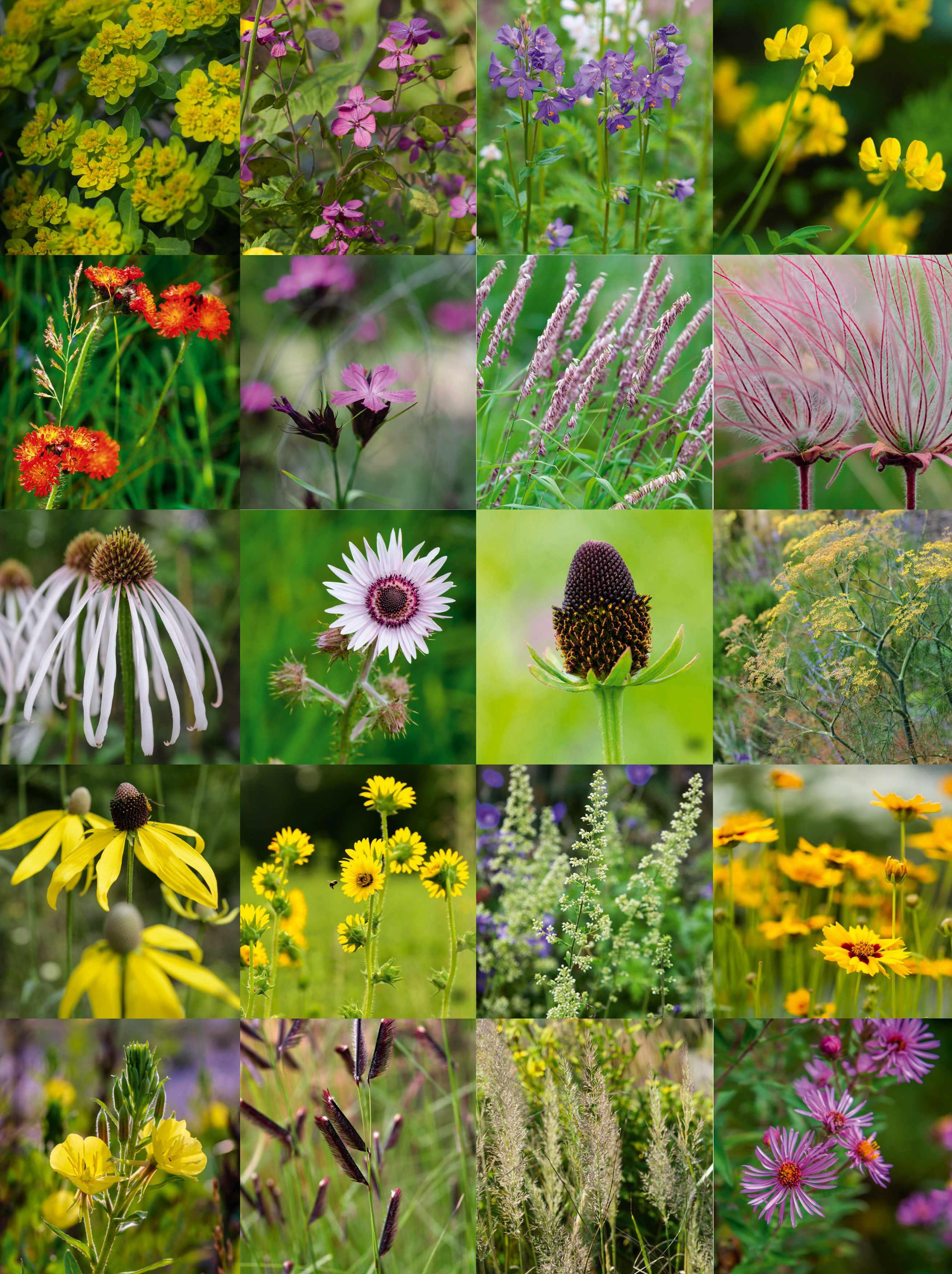
A successful border that is stable yet can delight comes from a mix of plant groups. It’s like putting together a dinner party; you need a mix of people to have the best conversation
growing perennials, only to add in a handful of quick, bulky annuals. The border would soon be overrun by one or two species. We need balance, so it helps to organise potential plant choices into one of three groups based on their growth strategies: competitors, ruderals and stress-tolerators.
Competitors grow big and bulky, physically dominating space and monopolising water and light – think of Echinops. Ruderals have short life cycles but seed prolifically, so jump around with ease – poppies, for instance. Stress-tolerators grow low and slow and are adapted to extreme conditions. When frost, fire or floods sweep through the land, these are the last plants standing – many Carex species show these attributes.
A successful border that is stable yet can surprise and delight each year comes from a mix of these three plant groups. It’s like putting together the perfect dinner party. You wouldn’t just invite all your quiet friends; you need a mix of talkative and thoughtful people to have the best conversation. With an SPM, you should think of plants less as individuals and more as a plant community, considering how the plants interact and relate to one another. Each growing season you’ll see something different.
I was inspired to see plants in this way after learning about the National Vegetation Classification system at college. Each UK habitat can be categorised as belonging to one of 286 communities, with each community containing 15-20 species commonly found together in that habitat. SPMs capitalise on the fact that plants across the globe have evolved to grow in groups.
Once you’ve created your mix, it’s then time to prepare the area for seeding. As with any seeded area, the largest threat to your mix will be from weeds. It’s for this reason that I start by spreading a 12cm layer of seeding mulch, a sterile material such
as PAS100 composted green waste or sharp sand, to help suppress weed seeds. I recommend sowing in spring, mixing the seeds with dampened sawdust to help sow them evenly, and then lightly raking over the area afterwards.
Water the area every three days without rain from late March to late May and stay vigilant for slugs in year one. Slugs love nothing more than fresh, young, leafy growth, so your SPM will be like a buffet for them. To keep numbers low, I recommend a multi-pronged approach. Along with monthly nematode drenches and picking slugs off by hand, I suggest that every now and then you leave a damp sheet of cardboard laid down overnight. This seems to be an irresistible sheltering spot, particularly for herbivorous slugs – in the morning it’s simply a case of shaking them off into the garden bin. Also, be watchful for weeds that are blown in or arrive in bird droppings.
You can look forward to a small amount of flower in year one, but most plants will be establishing roots, so it’s really from year two that the show starts to kick off.
We cut our SPMs down to the ground with a hedge trimmer just before the frost catches them in late autumn. Other than that, my advice for aftercare is to maintain a balance between your plant types using common sense. If your competitors are taking off, give them a Chelsea chop. If your ruderals aren’t moving about, shake the seedheads across the border.
You can also underplant the scheme with bulbs for interest early in the year – anything that flowers from late February to late March, especially crocuses, as well as Iris reticulata, species tulips and early daffodils. Your SPM border will be delightfully dynamic, and it’s up to you how much you allow it to develop and change over time. ■
USEFUL INFORMATION
Find out more about Sam Taylor-Hunt’s work at modicagardens.com


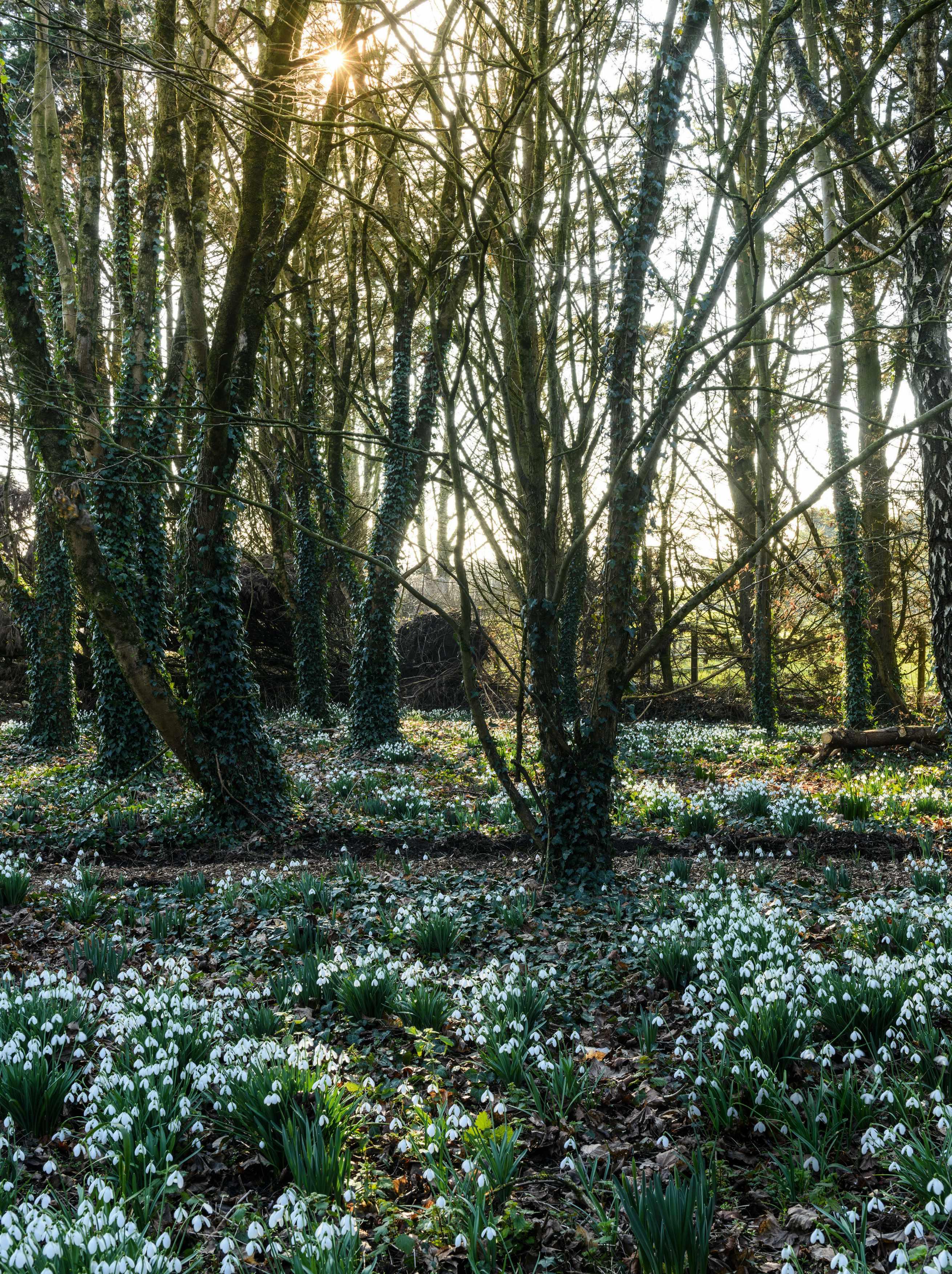
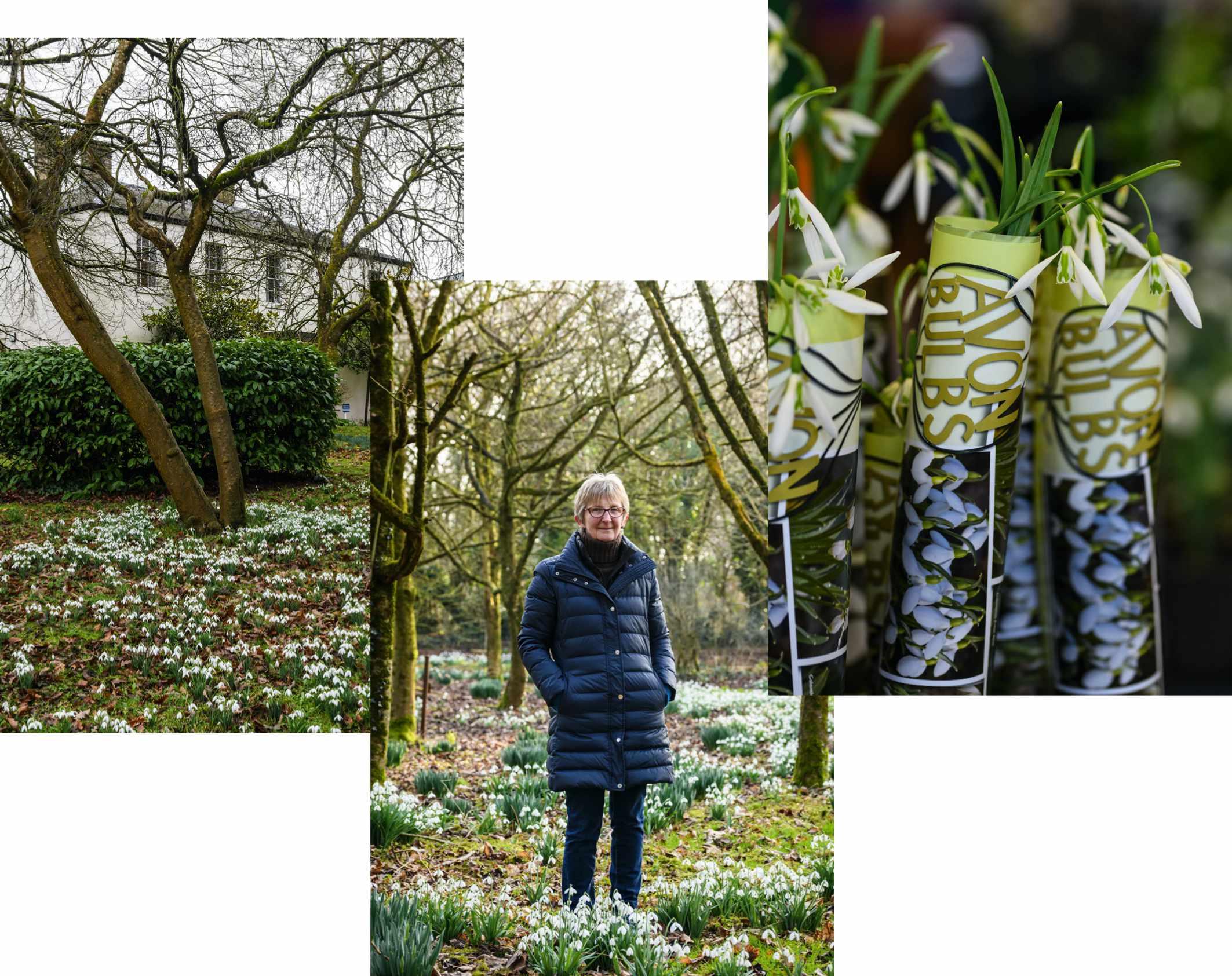
The annual Shepton Mallet Snowdrop Festival in Somerset is the place to be for galanthophiles this month
WORDS
Each October, volunteers in the market town of Shepton Mallet in Somerset plant thousands of snowdrop bulbs on roadsides, roundabouts, in schools and in other public places. In February, the opening of those flowers coincides with the Shepton Mallet Snowdrop Festival, which takes over the market town. The festival draws an international crowd of snowdrop devotees and many dress up for the occasion. Chalkboard signs, beautifully illustrated with snowdrops, draw visitors through the streets and direct them to the various venues that host the event. Garden designer Dan Pearson is patron, and there are snowdrop-related tours, talks, activities and competitions, as well as open gardens, including nearby Yeo Valley Organic Garden, featuring swathes of white flowers. In the hall of a local junior school, an assembly of specialist snowdrop nurseries offer a wealth of plants for sale,
Left Galanthus ‘Magnet’ in the garden of Highfield House, where ‘Snowdrop King’ James Allen lived his final years. This garden and that of nearby Park House, where Allen bred his snowdrops, form part of the James Allen Heritage Walk, which this year takes place on Friday 16 February.
Centre Amanda Hirst, co-director of the Shepton Mallet Snowdrop Festival, recognised the importance of James Allen’s legacy after moving to the Somerset town from London.
Above Specialist nurseries such as Avon Bulbs offer festival visitors choice Galanthus cultivars, freshly lifted and wrapped in newspaper, ready to be planted ‘in the green’.
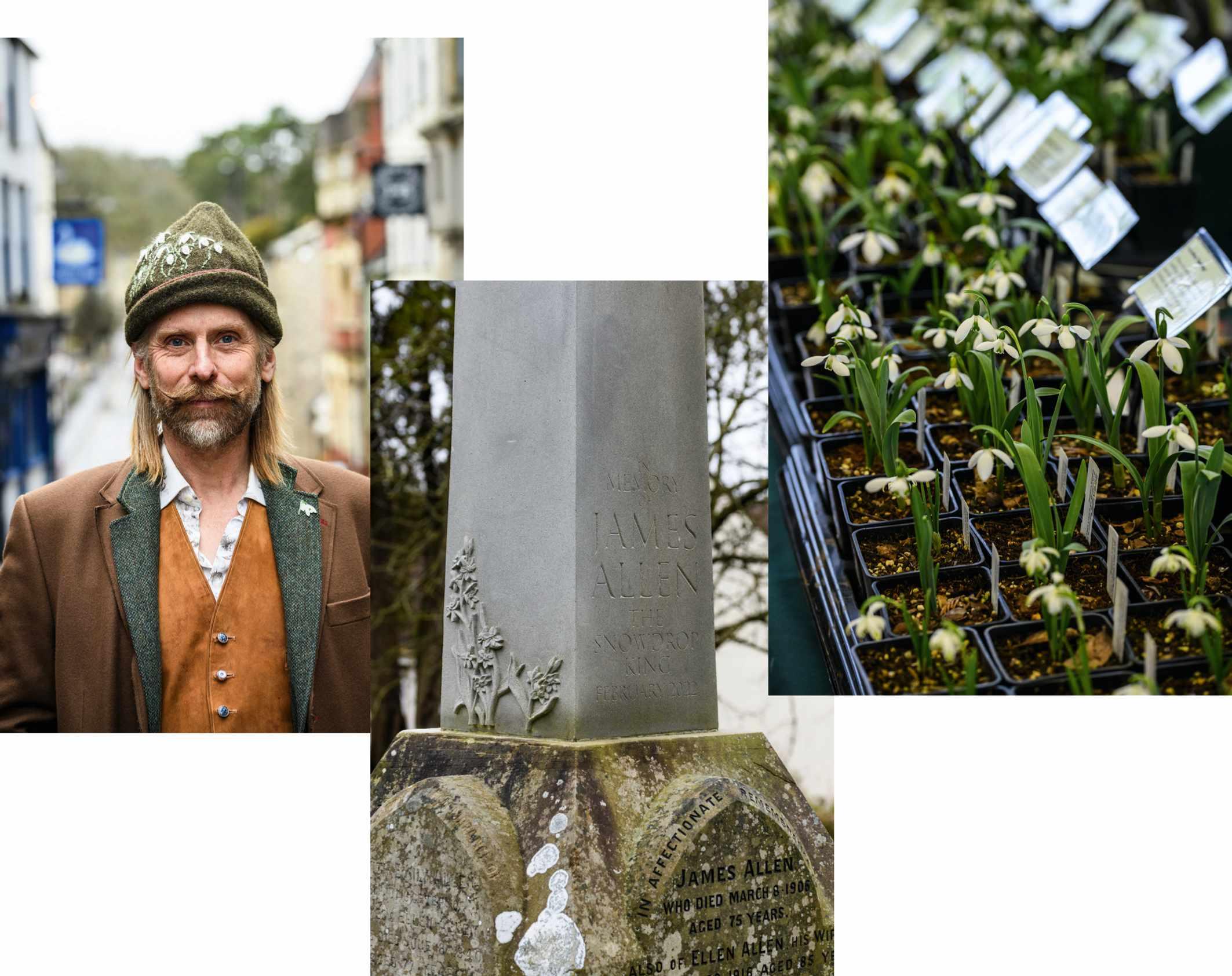
Left Poet and festival co-director Dominic Weston is judge of the poetry competition, which attracts entries from around the world. This year’s theme is ‘Nature Unbound’. The festival also organises a photography competition on the same theme.
Centre A new obelisk, beautifully carved with some of the flowers James Allen bred, was raised on his grave in Shepton Mallet Cemetery in 2022, after the original memorial had fallen into disrepair.
growing in pots and in the green. Alongside well-established favourites are bunches of, as yet, unnamed snowdrops, appealingly wrapped in brown paper, for those gardeners willing to take a chance on finding the next big (small) thing. On the high street, every shop front, from the café serving organic food to the hair salon and hardware shop, has a glorious, snowdrop-themed window display.
Shepton Mallet is a former cloth- and wool-milling town that, until recently, was most famed as the site of England’s oldest prison. After going AWOL from National Service, the notorious gangsters the Kray twins were briefly held there, and it was a place of safety for the Domesday Book during the Second World War. It now has a new reason to be known –as the place to go in February for all things snowdrop.
“Whether you’re a galanthophile, a gardener or someone who appreciates art, poetry and beautiful things, there’s something for everyone,” says Amanda Hirst, one of the festival’s three directors. “It’s also a great base for visiting our festival partner gardens and other notable snowdrop gardens in Somerset.”
Breeder extraordinaire
The festival, now in its fifth year, celebrates the legacy of James Allen (1830-1906), a local man who came to be known as the ‘Snowdrop King’. An amateur horticulturist, Allen was born in Windsor Hill, on the outskirts of the town, and lived and worked in Shepton Mallet throughout his life. He is one of Britain’s most recognised snowdrop breeders, and was likely the first person to breed snowdrops from wild species, by deliberately crossing and raising new hybrids. He was so famous in his day that in 1891 the Kew botanist George Baker named the hybrid Galanthus x allenii (G alpinus x G woronowii) in his honour.
“James Allen’s legacy was extraordinary and his title of Snowdrop King very well deserved,” explains festival co-director Dominic Weston. “It’s thought there were
Above Potted snowdrops for sale in the hall of St Paul’s school. Enthusiasts come from far and wide to browse the selections, some of which are still unnamed.
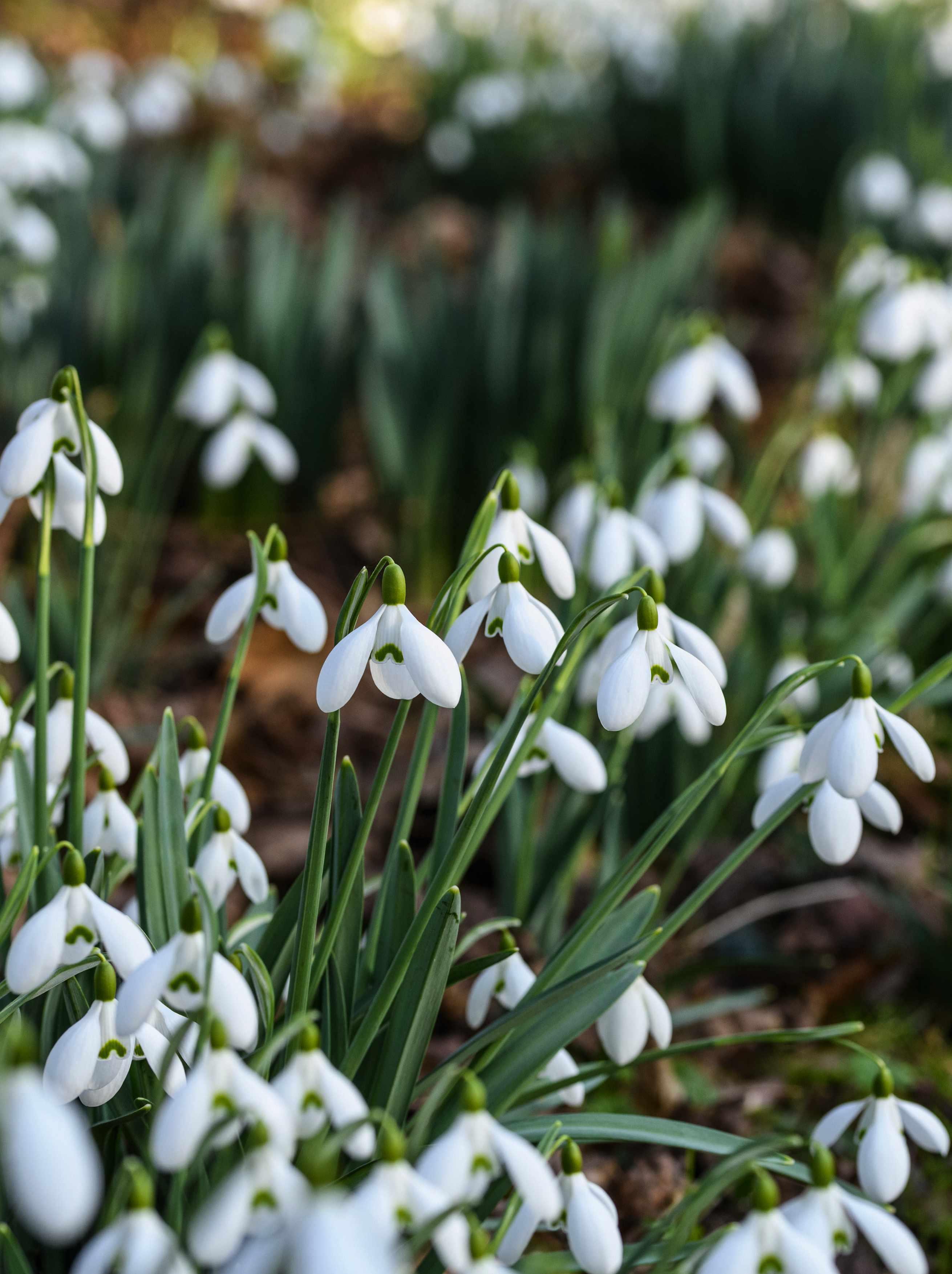
The town was famed as the site of England’s oldest prison, but it now has a new reason to be known – as the place to go in February for all things snowdrop
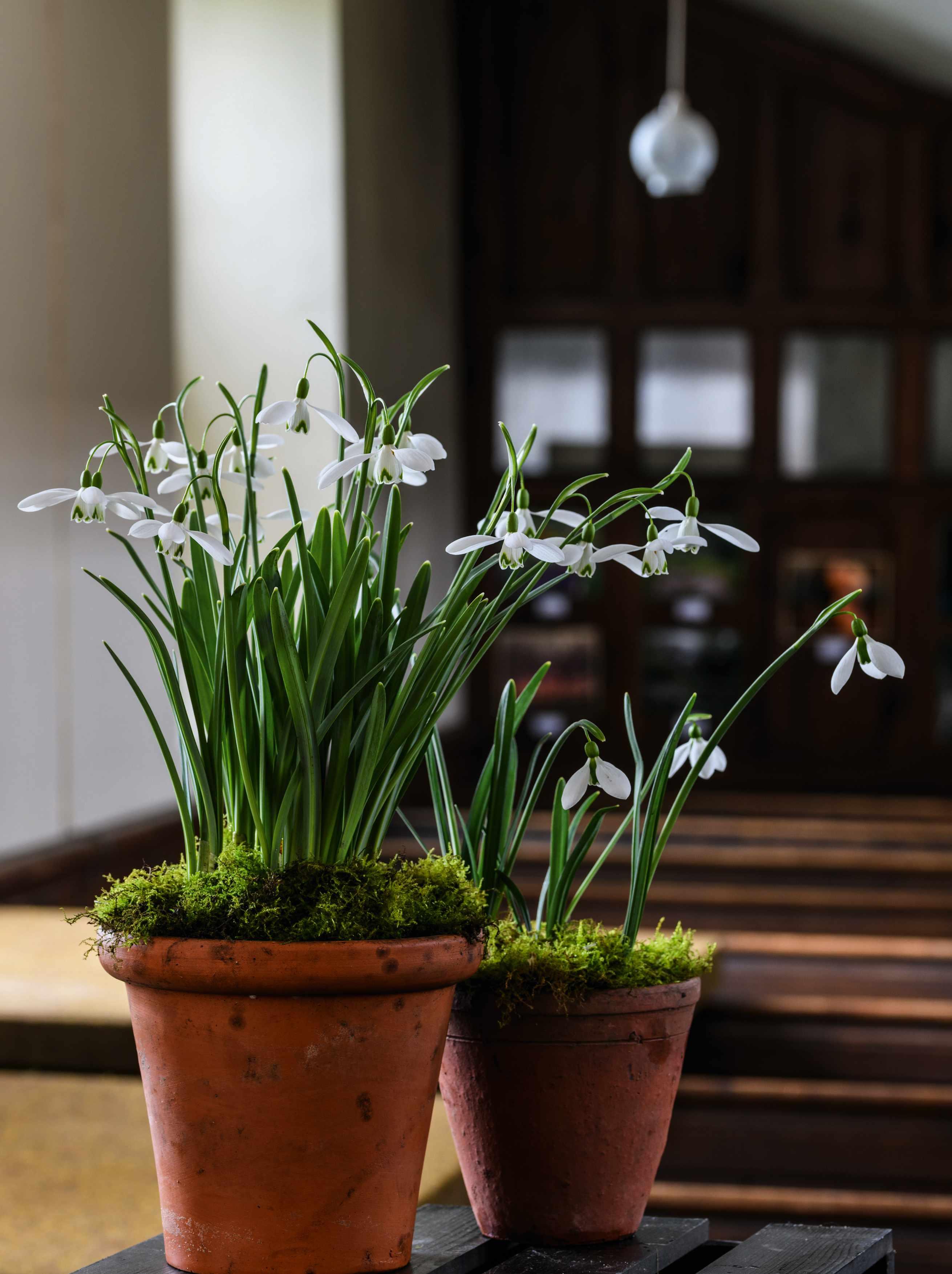
An amateur horticulturist, Allen is one of Britain’s most recognised snowdrop breeders, and was likely the first person to breed snowdrops from wild species

Left Ziva Patel, who won the under-11s category of the festival’s popular poetry competition last year with her poem Dandelions
Centre A range of artisan crafts are on display to admire and buy in the church of St Peter and St Paul.
Above Willow weaving is one of the local crafts on offer in bookable activity sessions. This mossy hanging snowdrop display is inspired by the Japanese kokedama tradition, the art of growing plants in moss-covered balls of soil.
hundreds of new snowdrops around at the time he and other Victorian collectors were actively seeking out and breeding new forms. James Allen is credited with breeding many, including at least 29 surviving named cultivars, and it’s for this reason that we celebrate his legacy each year.”
Snowdrop breeding is studied work that involves observing and identifying the most interesting characteristics of the genus, selecting flowers that demonstrate such traits, and crossing the flowers repeatedly before growing on from seed to bulb to flowering size, to see what blooms each February, looking out for anything new and of note. In The Garden magazine in 1886, Allen wrote: ‘I find that in nivalis, plicatus, imperati and elwesii there are many forms, so I am currently purchasing from fresh sources and then making selections for them when they bloom. I am raising seedlings from my best varieties.’
Notable among Allen’s selections are two cultivars still very popular today. Galanthus ‘Magnet’ has well-formed flowers that are subtly marked in green and have an unusually long pedicel so that the flowerhead bobs in the breeze. G. x hybridus ‘Merlin’ is a clear white flower with inner flower segments that are completely green.
With the exception of G. ‘Magnet’ and G. x hybridus ‘Merlin’, many of Allen’s seedlings and hybrids have long since disappeared. His legacy, however, is evident in every gardener who ventures out during the short, dark days of winter to enjoy the subtle detail of these tiny treasures, and in the celebratory spirit of the Shepton Mallet Snowdrop Festival. ■
Shepton Mallet Snowdrop Festival runs from 12-18 February 2024. Festival HQ is the Shepton Library. Web sheptonsnowdrops.org.uk
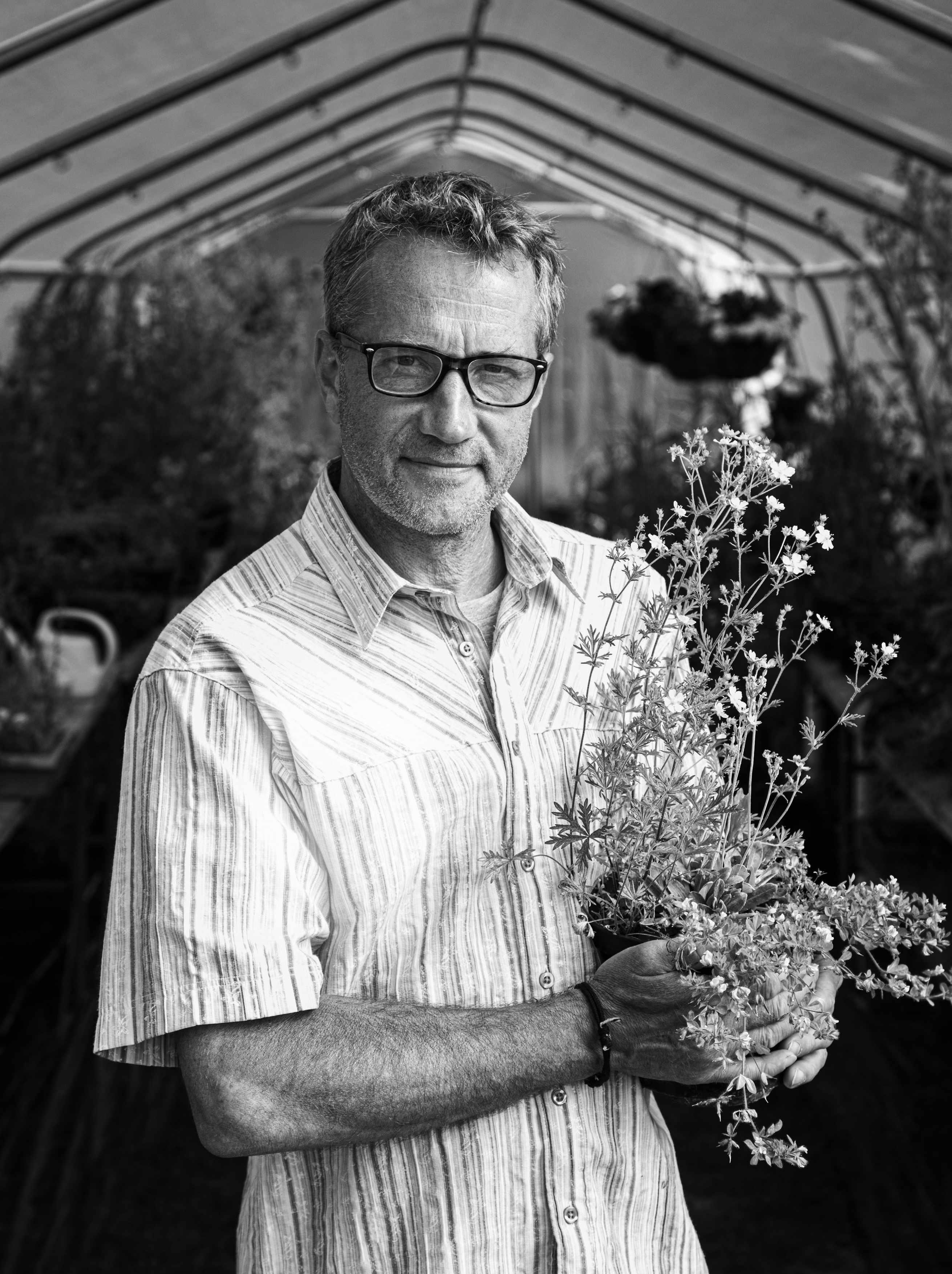
Andrew Shaw has a passion for rare British natives, even bringing things back from the dead
WORDS STEPHANIE MAHON
PHOTOGRAPHS JOHN CAMPBELL
The Brecon dandelion, Taraxacum breconense, is endemic to Wales and found nowhere else on the planet. It is now threatened with extinction. Andrew Shaw is part of a new species recovery project to establish new populations in Bannau Brycheiniog (Brecon Beacons National Park).
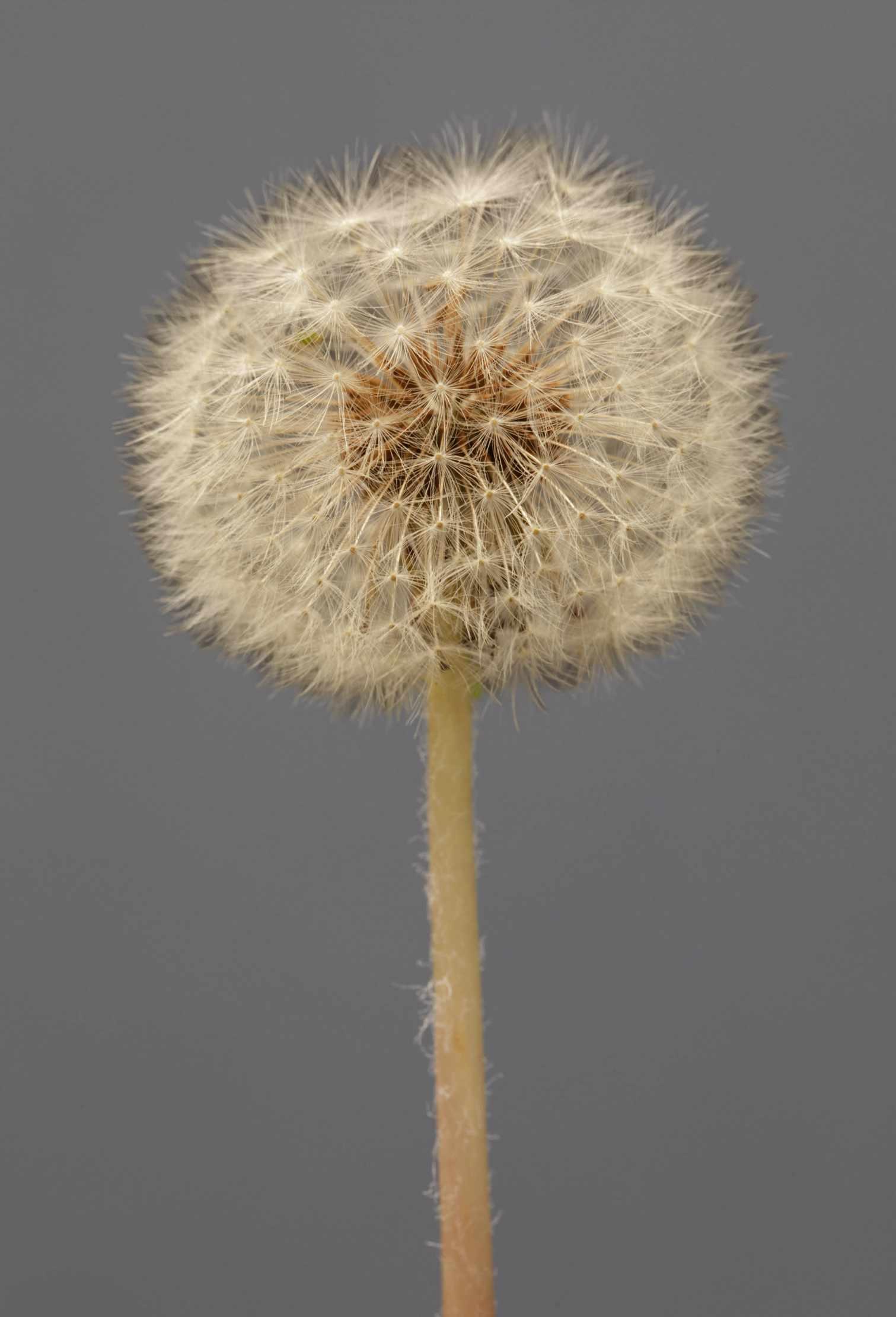
If someone told you they had raised, say, a dodo, or a dinosaur, you’d find it hard to believe, but Andrew Shaw has done just that – resurrected an extinct species. Founder of the Rare British Plants Nursery, he specialises in cultivating endangered native plants, and last year, he brought York groundsel back from the dead. Endemic to England, in fact, to York –meaning it only grew there – York groundsel (Senecio eboracensis) could once be found growing wild on wastelands, train tracks, footpaths and car parks around the city. The last-known plant died in 2003, and there were no examples left in cultivation. But Kew’s Millennium Seed Bank, did have some
20-year-old seeds in cold storage, which they sent to Andrew and which, miraculously, he got to germinate. And so he brought York groundsel back to life.
You might imagine that the setting for this sort of endeavour is clinical and lab-like, all microscopes, Petri dishes and white coats, but the Rare British Plants Nursery looks like any other nursery: pots in a polytunnel. Its exact location, near Builth Wells in Wales, is a loosely guarded secret. Andrew moved here about 25 years ago, to a 40-acre smallholding with a neat farmhouse and wide-ranging views, where he could indulge his love of natural history.
Andrew trained and worked as an ecologist, advising developers on protected species.
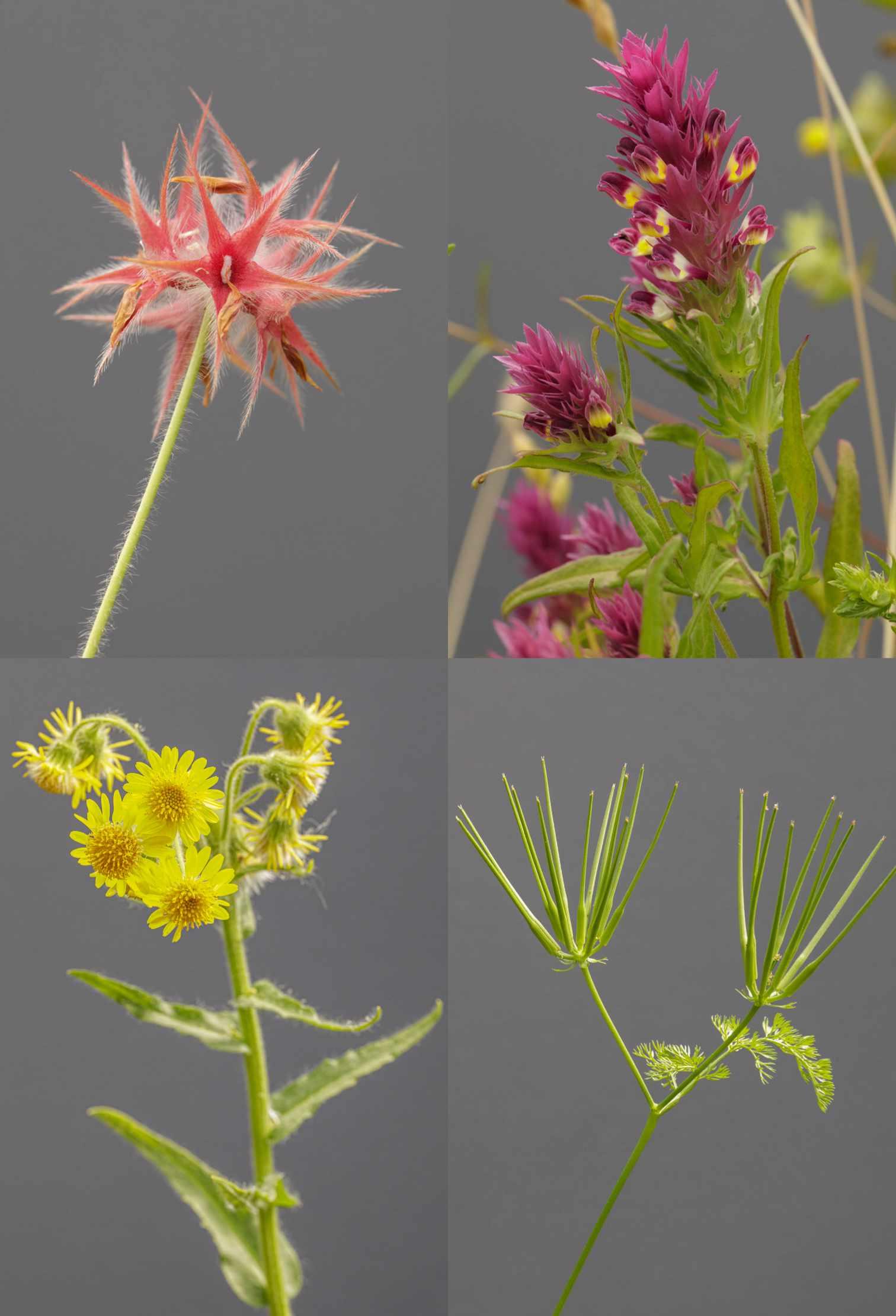
“But botany was my main passion,” he says. “I collected a lot of stuff as I was going about the country, and suddenly people started asking me for a sample of this or that. Before you know it, I’ve got people from Kew and the National Botanic Garden of Wales visiting, and I’m getting asked to do recovery projects. Most botanists don’t grow things – it’s not about cultivation for them, it’s just about identifying plants. Whereas I grow everything I can get my hands on.”
Now his day job involves growing scarce and threatened native plants for habitat restoration schemes, working with wildlife trusts and organisations such as Natural England to restore wild populations.
Another of his recent successes is Beacons hawkweed (Hieracium breconicola), one of the rarest plants on the planet. The entire global population consisted of one lonely plant, hunkered down on a mountain ledge in the Brecon Beacons, before Andrew began a species recovery project in 2021, propagating and growing back-up plants to return to the wild.
Andrew also holds an extraordinary collection of rare British plants, many of which are obscure or no longer exist in the wild. Plants that naturally occur at opposite ends of Britain – on the Lizard Peninsula in Cornwall and a windswept, rocky outcrop in the
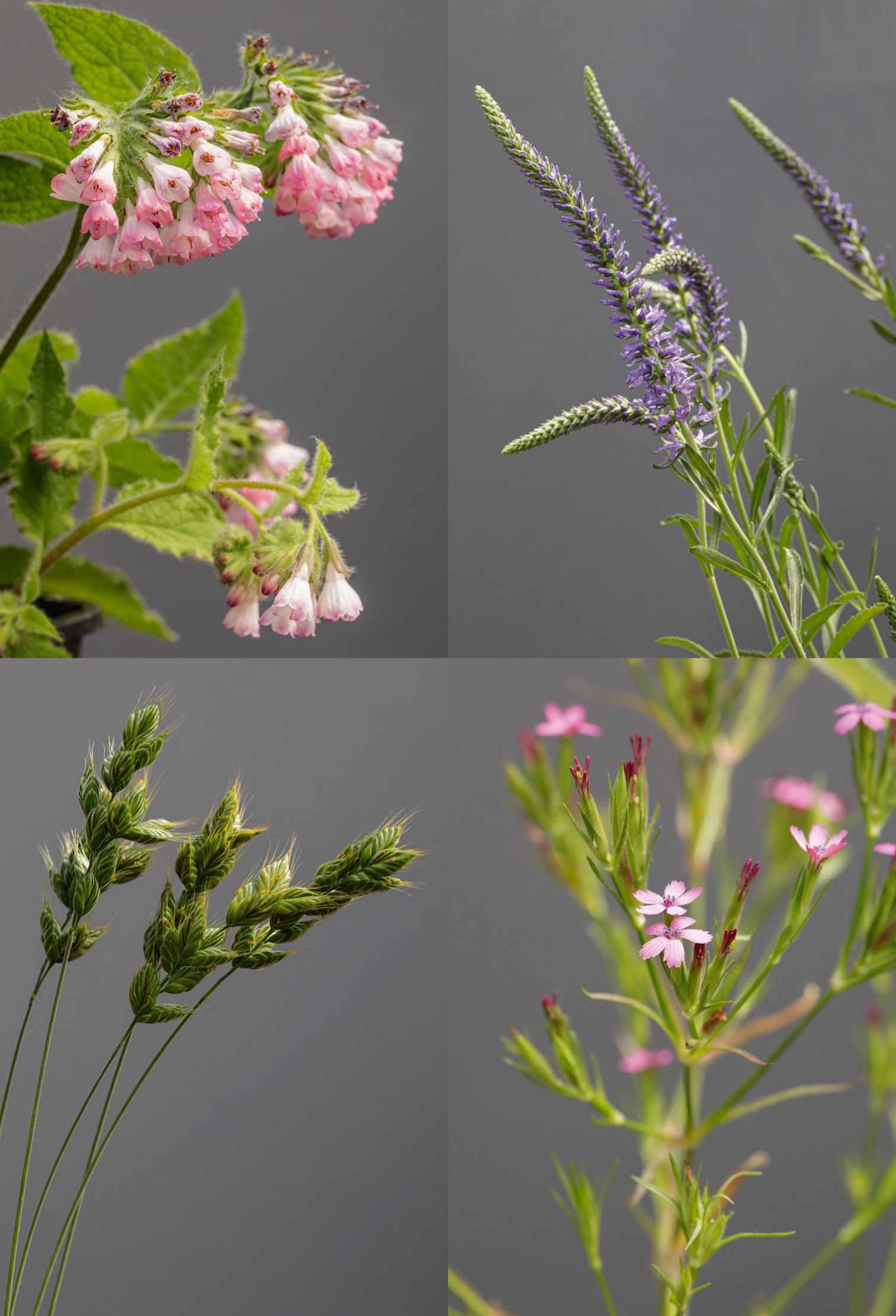
1 The fabulous foreigner Starry clover (Trifolium stellatum) is a rare introduction, which turned up at the seaside in West Sussex in 1804. Its striking red calyxes appear after small clover flowers.
2 The ‘I can’t believe that’s a native’ one Field cow-wheat (Melampyrum arvense) is a hemiparasitic annual found on the roots of grasses at a very small number of sites.
3 The rescued one Marsh fleawort (Tephroseris palustris) was widespread in eastern England but drainage of its habitats led to a rapid decline. Andrew has just returned it to Norfolk after an absence of 125 years.
4 The striking one Shepherd’s needle (Scandix pecten-veneris) was once so abundant that it impeded mechanical harvesters, but is now a nationally scarce species.
5 The lonely one Barton Road comfrey (Symphytum x perringianum) has only ever been known from a handful of locations around the city of Cambridge. It is not fertile and may soon be extinct.
6 The blue beauty Spiked speedwell (Veronica spicata) is a rare perennial herb of well-drained, nutrientpoor soils, with distinct populations in two areas.
7 The one that was saved Interrupted brome (Bromus interruptus) went extinct in the wild in 1973. It was saved by a botany lecturer who had been growing plants from previously collected seed in his garden.
8 The one with the curious name The Deptford pink (Dianthus armeria) is found in southern England but has never been recorded in Deptford.

Scottish Highlands, for example, which would never meet in the wild – rub shoulders here, and only here. “There’s nobody else anywhere with a collection of native plants like this,” he says.
Every pot has a story, lovingly told. There’s Breckland perennial knawel (Scleranthus perennis subsp. prostratus), a British endemic which is rarely seen by anyone, explains Andrew, as its largest population is within the perimeter of RAF Lakenheath in Suffolk, and the US military stationed there don’t take kindly to people turning up to botanise over a clump of leaves.
He also holds examples of Lundy Island cabbage (Coincya wrightii), which only grows on Lundy Island in the Bristol Channel and has its own endemic beetle; and the Arctic alpine
9 The one in decline Tuberous thistle (Cirsium tuberosum) is a European endemic now only known from a few sites in Glamorgan, Wiltshire and Dorset.
10 The resurrected one York groundsel (Senecio eboracensis), a progeny of Oxford ragwort and common groundsel, was the first new species to be named in Britain for 50 years when it was found in a car park in 1979. It was
extinct but is back blooming in the city.
11 The comeback kid Beacons hawksweed (Hieracium breconicola) was down to one plant in the wild, but now Andrew’s introduced plants have established.
12 The wonderful weed Pheasant’s eye (Adonis annua) was once a widespread arable weed but is now rare due to intensive farming.
drooping saxifrage (Saxifraga cernua), known from just a few places in Scotland. “It has to be a contender for one of the most threatened plants in Britain, because it’s at the southernmost edge of its range,” he says, “and with climate change, it’s basically stuffed.”
Then there’s floating water-plantain (Luronium natans), a rare aquatic plant from the Montgomery Canal, which a local fisherman posted to Andrew to identify after it kept snagging his fishing line; and limestone woundwort (Stachys alpina), a pretty perennial herb that was restricted to just two sites in the British Isles, but has now been introduced to a churchyard in Gloucestershire.
Many of Andrew’s treasures have evocative common names such as stinking goosefoot, starfruit, moon carrot and viper’s grass, and he can, and does, wax lyrical about these plants for hours; each one just as fascinating to him as the last. Where most people see weeds, he sees important native plants threatened by habitat degradation, typically from development or overgrazing and other modern land management practices. “We are the intelligent species on the planet, so I think we’ve got a responsibility and a moral obligation to look
after stuff, especially if we caused its demise in the first place. And I can do my little bit on the native plants that I know about.”
Native plants are currently a hot topic in horticultural circles, with pressure on gardeners to grow more; but the oft-cited argument against filling our plots with them is that there simply aren’t that many British natives, and the ones we do have aren’t really garden-worthy. “We are relatively speciespoor here because of geographical location and climate,” says Andrew, “but there are some beautiful things that are native, if rare, because they’re not cultivated commercially. We’ve still got plenty of species that don’t grow anywhere else in the world, and we should be looking after them. It’s shocking that there’s not more interest in them.”
Andrew is particularly interested in the genetic variations that occur in the same species in different locations, and in new types of plant that spontaneously pop up.
One example is Barton Road comfrey (Symphytum x perringianum), a hybrid now found on just one Cambridge street. “This is why gardens are so interesting – because of the stuff we unwittingly release into the wild.
Things mix with each other that would never normally meet. You may not realise that the clump of something outside your house that you take for granted may actually be the only one of its kind in the world. Evolution is happening on the streets of our cities.”
There’s no special trick as to how Andrew propagates these plants – for annuals, he simply sows the seeds in a few different ways based on conditions the plants would like in the wild. Once he has produced a back-up population and enough seed, he broadcasts it at a suitable site for repopulation and sees what happens.
Perennials are trickier to establish, so instead of broadcasting seed, he will grow on and then introduce plants. The key to success, he says, is picking the right location. “I’ve been known to take one hour to plant a single plant, just to find the spot that I think is right. It is nerve-racking when you only have a very small amount of a plant, and you know that you can never get any more. But I don’t think I have failed with anything in all the years that I’ve been doing this.” He grins. “Nothing’s beaten me yet.” ■
USEFUL INFORMATION
Find out more at rarebritishplants.com
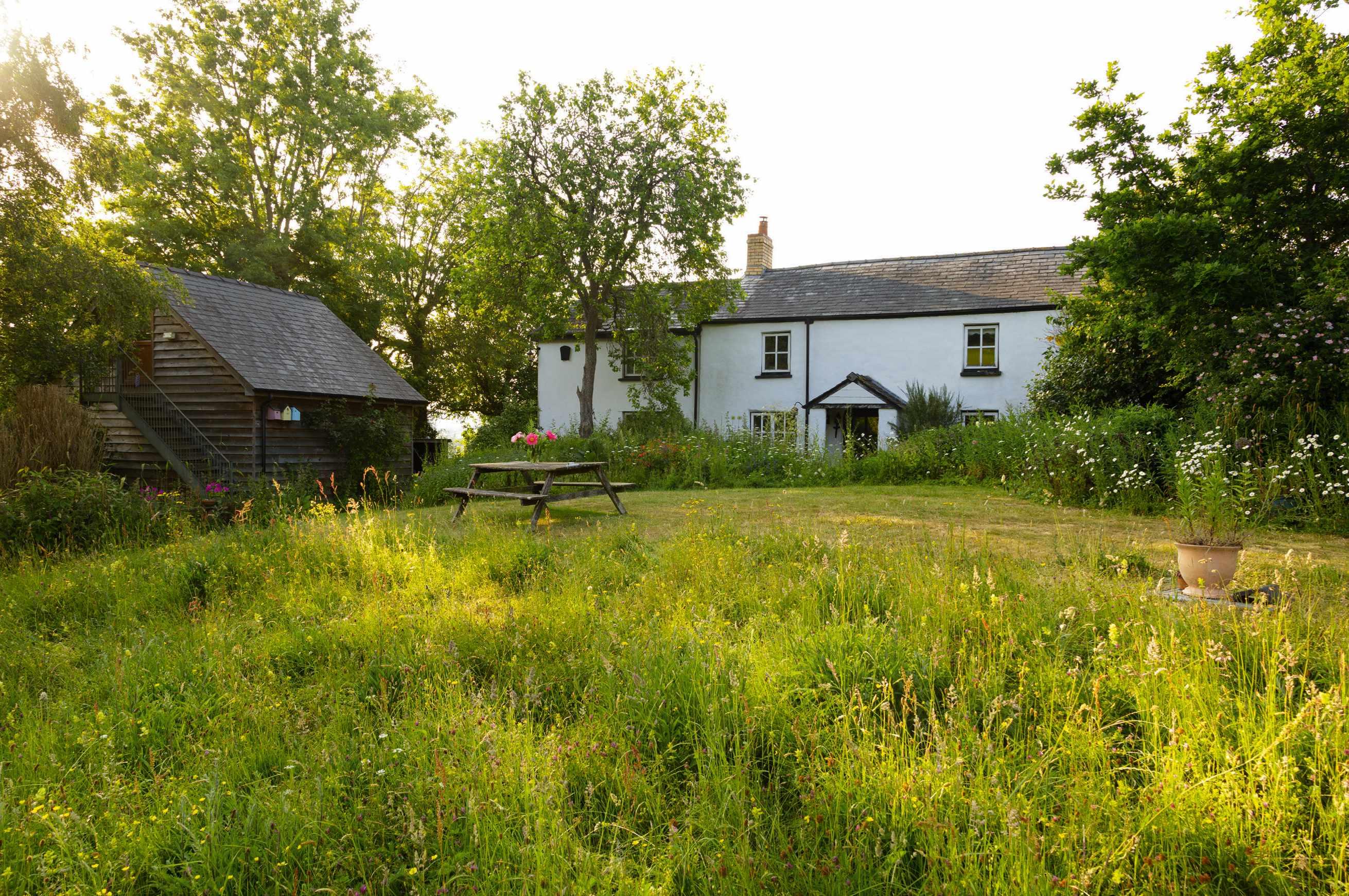



Hurtigruten Expeditions are leaders in expedition cruising, taking you to those places that lure the curious traveller. Whether it’s spotting polar bears in the pristine landscapes of the Arctic, watching marine iguanas bask on the Galápagos Islands, or getting up close to Antarctica’s penguins in stylish, purpose-built expedition ships, an HX expedition brings you closer to a world of wonder.

GardensIllustrated readers receive a 5% discount on all Hurtigruten Expedition cruises. Your 5% discount can be combined with all current offers. To redeem your discount, enter the discount code HRG-GIL when booking online at hxexpeditions.com/uk, or call 020 3811 3816 quoting HRG-GIL.


Known as ‘the world’s most beautiful voyage’, a Hurtigruten sailing along the Norwegian coast rightly earns its place in the hall of fame of iconic traveller routes. Discover the original coastal route with 34 ports of call, sailing past more than 100 fjords and 1,000 mountains.

TO CLAIM YOUR OFFER
GardensIllustrated readers receive a 5% discount on all Hurtigruten voyages. Your 5% discount can be combined with all current offers. To redeem your discount, enter the discount code HRG-GIL when booking online at hurtigruten.co.uk, or call 020 3553 1644 quoting HRG-GIL.





Bring some romance to your garden with our selection of garden seats for two
COMPILED BY MOLLY BLAIR
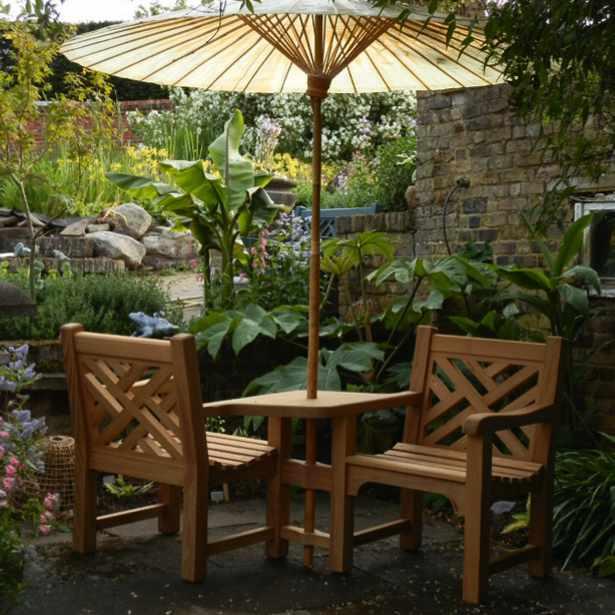
HANDCRAFTED
Chinoiserie Heavy Back Love Seat, From £3,750, Andrew Crace, 01279 842685, andrewcrace.com
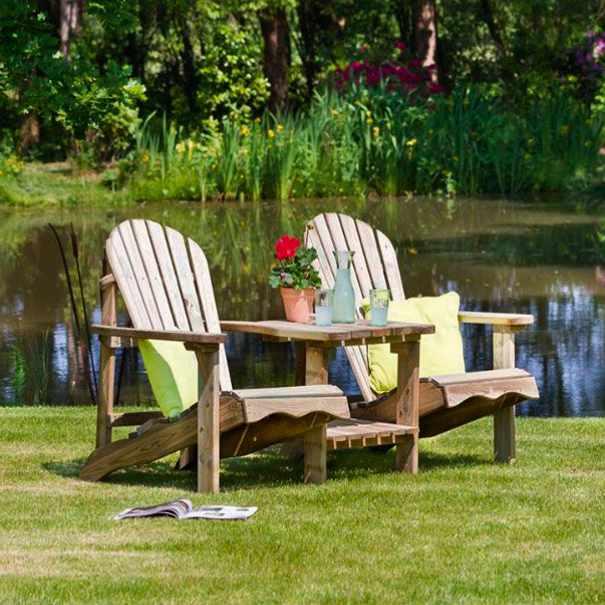
REST AND RELAXATION
Zest Outdoor Living Lily Relax Seat, £229.99, Charlies, 0345 077 0708, charlies.co.uk
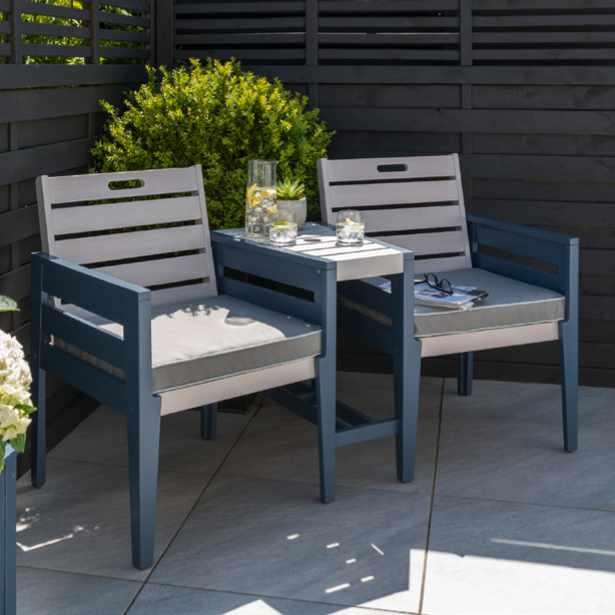
MODERN DESIGN
Florenity Galaxy Tete a Tete Bench Set, £359, Patio Life, 029 2236 2398, patio-life.co.uk
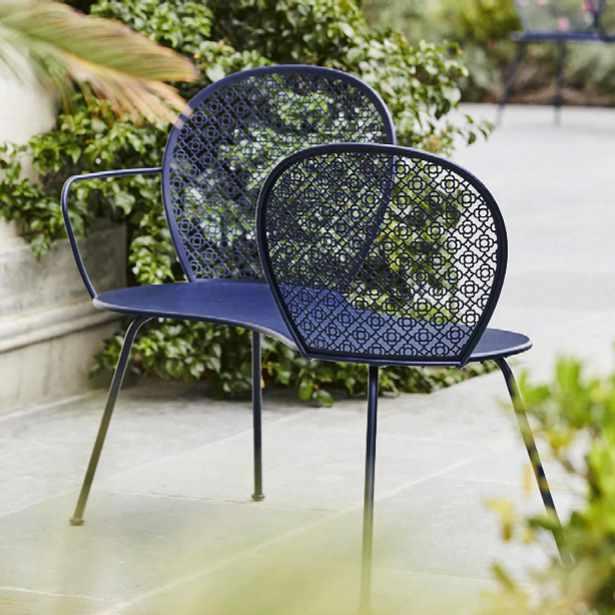
CLASSIC
Lorette Conversation Bench, £1,229, The Worm That Turned, 0345 605 2505, worm.co.uk

RUSTIC FINISH
Parkers Bronze Duo Bench, £229.99, Coopers of Stortford, 0844 482 4409, coopersofstortford.co.uk

COLOURFUL SET
2-Seater Convertible Garden Sofa Set, £529.99, Beliani, 020 3318 8222, beliani.co.uk
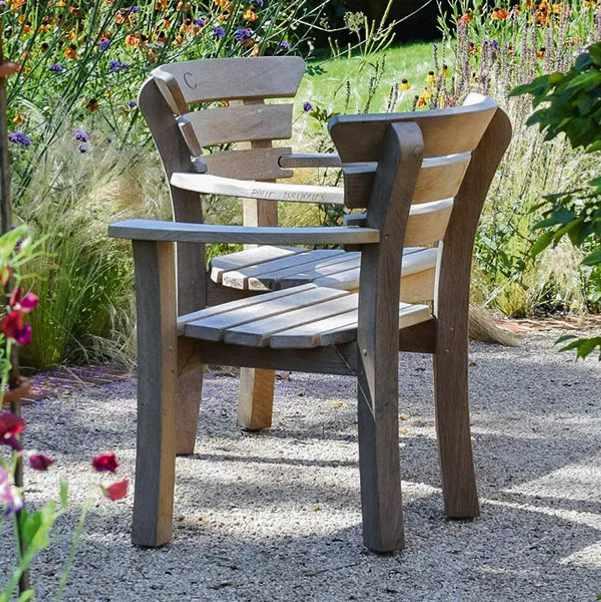
SCULPTURAL
Meander Love Seat, £6,420, Gaze Burvill, 01420 588444, gazeburvill.com

GOTHIC INSPIRED
Large Cream Arched Companion Seat, £250, Dibor, 0800 408 0660, dibor.co.uk
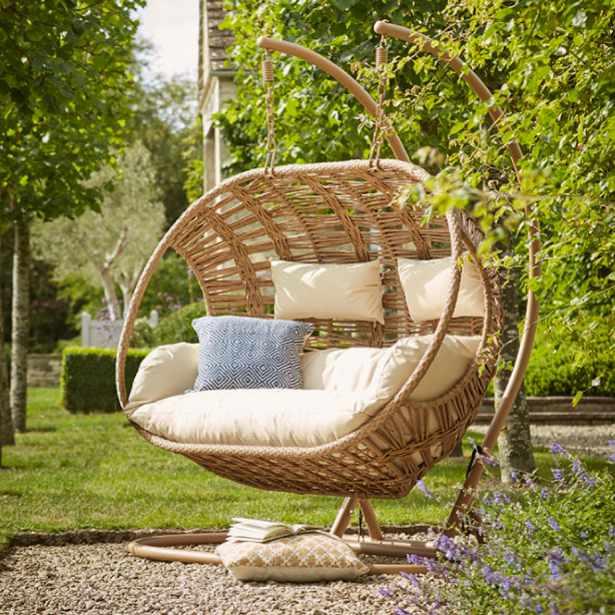
WARM TONES
Icaria Double Hanging Chair, £875, Cox & Cox, 0330 333 2123, coxandcox.co.uk
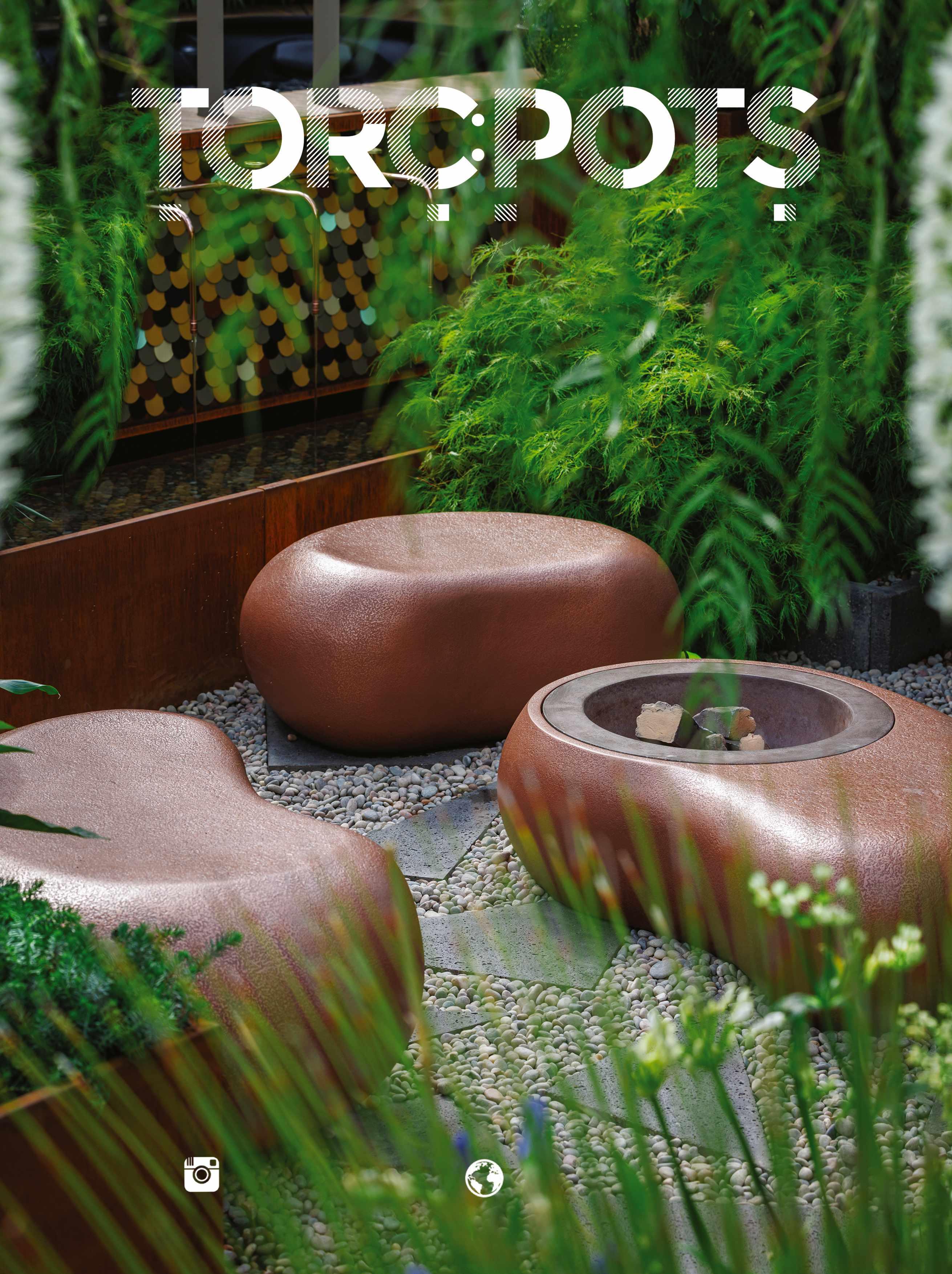
Katy Merrington’s top plant books, competition, the crossword and Alice Vincent

Katy Merrington, cultural gardener at The Hepworth Wakefield, rummages through her bookshelves to choose her ultimate list of titles for planting inspiration and plant identification as well as mind-opening essays, explorations and missives on plants
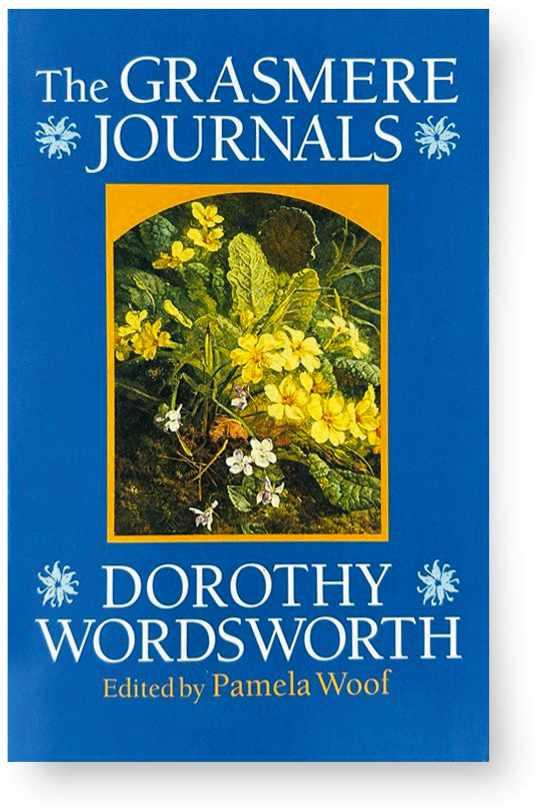
HE RASMER J RNA S
THE GRASMERE JOURNALS by Dorothy Wordsworth
Oxford Paperbacks (1993)
ISBN 978-0192831309
The plants that fill our favourite landscapes can embody the season for us and make a place and moment special. Dorothy Wordsworth captured her love for the plants around her in the journal that she began in May 1800, while sharing Dove Cottage in Grasmere in the Lake District with her brother, the poet William Wordsworth.
The diary was written solely for her brother to enjoy, and it inspired some of his poems. It is made up of snippet sentences that immediately pull you back to the particularity of her day over 200 years ago. She notes down her walks, the weather, the dire poverty of people she meets and the dreary reality of headaches – in a time before paracetamol.
Nevertheless, her spirits are often lifted by the daily observation of plants – the joy at seeing a cherished tree come into leaf, the precise phase of a foxglove flower opening, or the very last primrose to bloom in the orchard in spring.
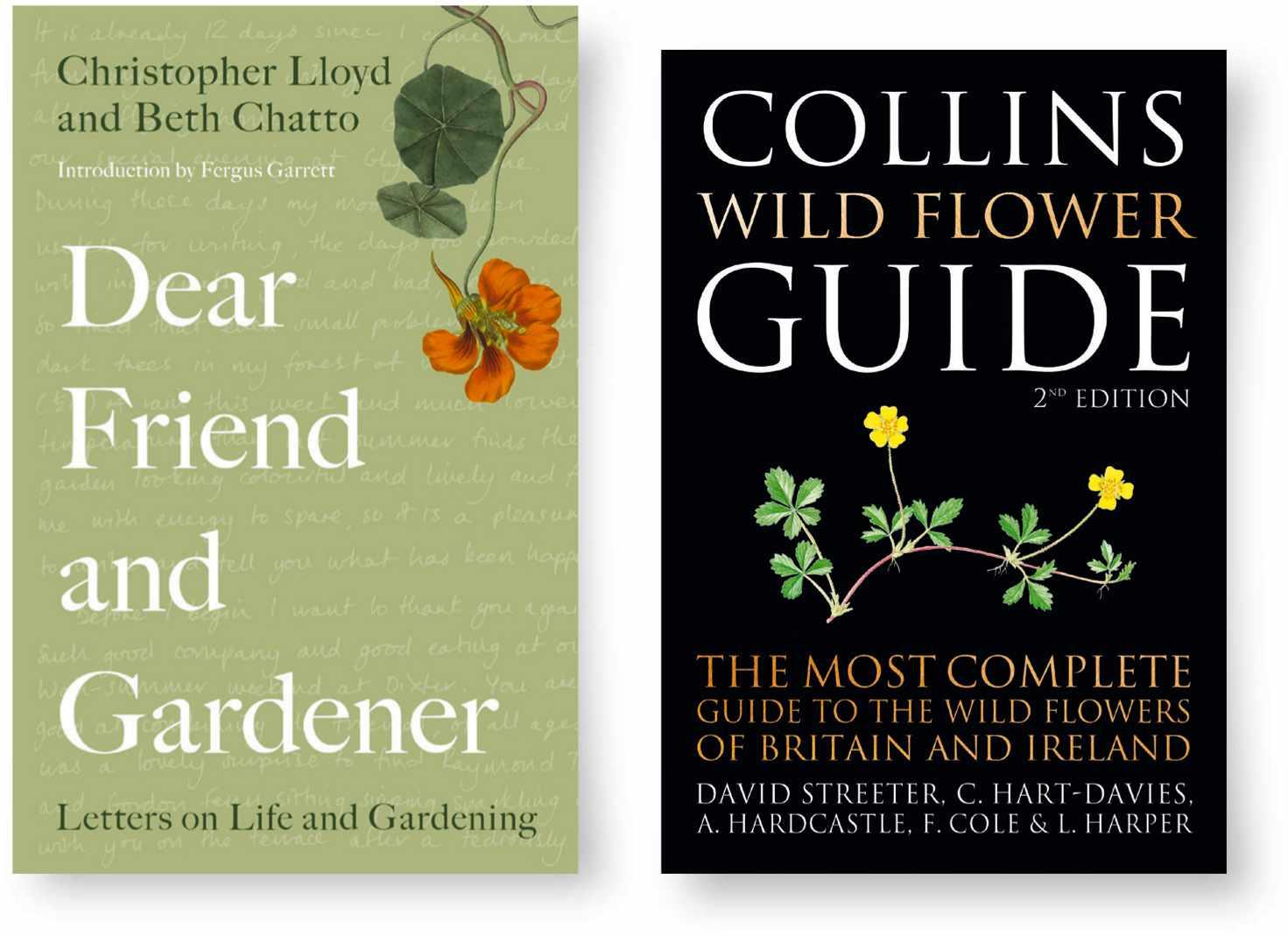
by Beth Chatto and Christopher Lloyd
Frances Lincoln (2021)
ISBN 978-0711255807
I could have chosen many books by the gardening greats Beth Chatto and Christopher Lloyd, but this volume of letters they wrote to one another in the late 1990s gives a unique opportunity to listen in on their conversation, as they share gardening highs and lows across two years.
They are writing here in later life, with their gardens open to the public. They are very different in character but close friends, not afraid to counter each other’s opinions. You can sense the twinkle in their eyes, as they needle each other cheekily, on questions such as irrigation, or who has produced the best carrots.
You feel as if you are privy to the emotional journey that plant growing takes you on throughout the year – as you start with a strategy and then see how each move plays out. The letter format works well for capturing this seasonal rhythm of work and reflection. It is also reassuring to know that like all gardeners, they are totally obsessed with the weather.
William Collins (2016)
ISBN 978-0008156756
If a book being dog-eared is a sign that it is loved, then one of the most cherished books on my shelf must be the little chunk that is the Collins Wild Flower Guide
For me, it comes into its own after a weeding session, or after a good long walk (on holiday if you’re lucky), when a frustration nags at you that you can’t name a plant that you have seen. This is the time to sit down with a nice cup of tea, get out the field guide and look it up.
It’s handy to refer to a photo you’ve taken of the flower – and, of course, there are apps now available to help identify plants – but one of the benefits of putting a bit of work into placing a name using a book is that you must go on a journey through the pages to find it, meaning that you inadvertently learn other things along the way.
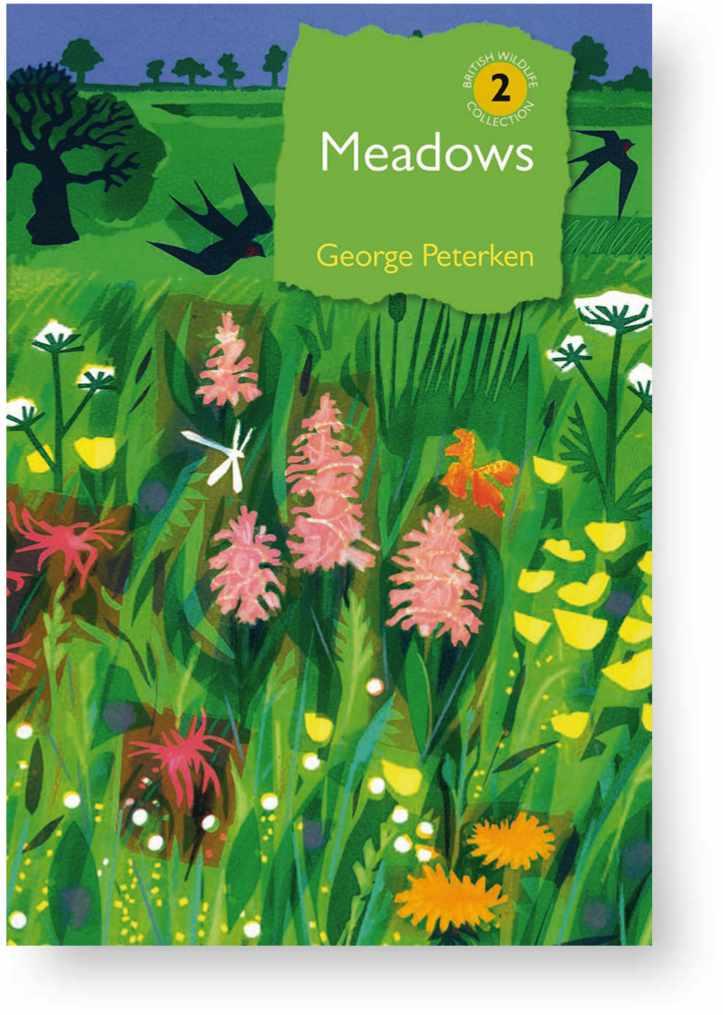
by George Peterken
Bloomsbury Wildlife (2018)
ISBN 978-1472960344
We can all probably picture a meadow, but lucky is the person who gets to walk through one nowadays, because here in the UK they are a near-vanished habitat. Plants don’t grow in isolation but have evolved to hold their own in the hustle and bustle of an ecosystem. This book is part of the excellent British Wildlife Collection, which explores natural history across titles such as rivers, hedges, mountain flowers and more. Each topic is covered by an expert in that field, in a scientific yet readable way.
I have chosen this one because meadows can be a bit confusing – partly due to the word, which we use so broadly as a dreamy name for any flower-rich mixture, as well as a technical term, describing a grassland mown for hay.
George Peterken unpicks all elements of meadows here. What is a meadow? Is it man-made? How does it differ from a pasture? What lives in a meadow? And how do we nurture this kind of habitat for the future?
You can sense the twinkle in their eyes, as they needle each other cheekily on who has produced the best carrots

THE GARDENER’S GUIDE TO PRAIRIE PLANTS
by Neil Diboll and Hilary Cox
University of Chicago Press (2023)
ISBN 978-0226805931
So many gardening books illustrate herbaceous perennials in their reproductive prime and tell us little about the rest of their lives. This book is the opposite, treating plants holistically, as living beings across their lifetime – with underground parts, bodies that age and relationships with other creatures.
You may think, “Well, I don’t have a prairie,” but many of the stalwarts of our contemporary naturalistic planting palette, including hard workers such as Echinacea, Rudbeckia and Veronicastrum, originate in the plains of North America.
You can learn a lot from this book about the general care of herbaceous plants. Each plant profile is packed with detail – photos of seedlings, mature seedheads and notes on root type. Tables group information under helpful headings – such as plants for certain soils, or for encouraging specific insects – so you can make the most of this wealth of data easily.
This book raises the bar for plant books going forward with the sheer breadth of information that it generously shares.
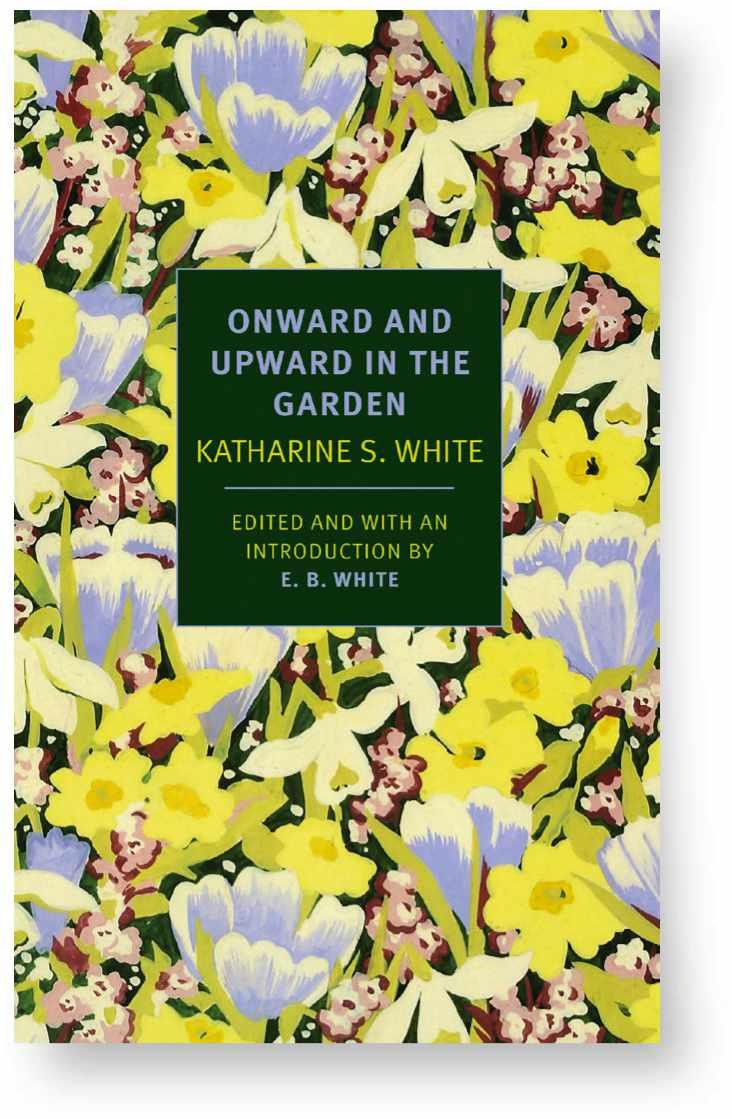
by Katharine S White
NYRB Collections (2015)
ISBN 978-1590178508
There is a lot of joy to be found in reading a nursery catalogue, conjuring a dreamy world of possibility when perused indoors on a cold winter’s day. Katharine White clearly felt this – she was fiction editor for The New Yorker, and a keen gardener. In the 1950s she began to write annual reviews of nursery catalogues, giving them robust critiques, just like she would a novel. This book collates her writing.
Nursery catalogues present a lot of complex information in a condensed format, and she celebrates and reviews the work of these unsung authors across all areas – the new cultivars they’re promoting, their tone of voice, layout, photography, and even the paper they’ve chosen to print on. Ultimately, she’s interested in a catalogue’s ability to bewitch its reader.
Katharine White had a discerning eye, like one of those valued friends you quickly trust when it comes to a recommendation. I wonder what she would have thought of the writing and content that we now find on websites and social media.
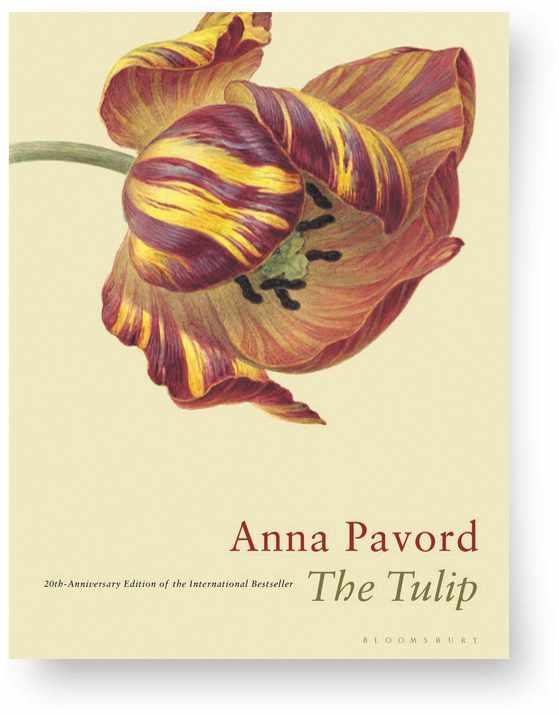
THE TULIP
by Anna Pavord
Bloomsbury (2019)
ISBN 978-1526602688
Plants are so often commodities that weave their way into all aspects of art, culture and economics, but perhaps no flower has wrought such a curious path through human history as the tulip.
These cups of intense colour that live half the year underground, wearing modest brown tunics, have lost none of their potency, though you no longer need to remortgage your house to buy the most sought-after specimens, as at the height of ‘Tulipomania’ in 1630s Holland.
Anna Pavord takes us on this small bulb’s journey from the rocky steppes of Asia, through waves of European obsession – a flower so singular and seductive that its image has been used to adorn textiles, paintings and patterns for centuries.
As much as this book is about the botanical powerhouse that is the tulip, it is also about people and what a curious species we are when something is beautiful and we want to own it – able to turn even living plants into competitive vessels and collectors’ items.
What a curious species we are, able to turn even living plants into competitive vessels and collectors’ items
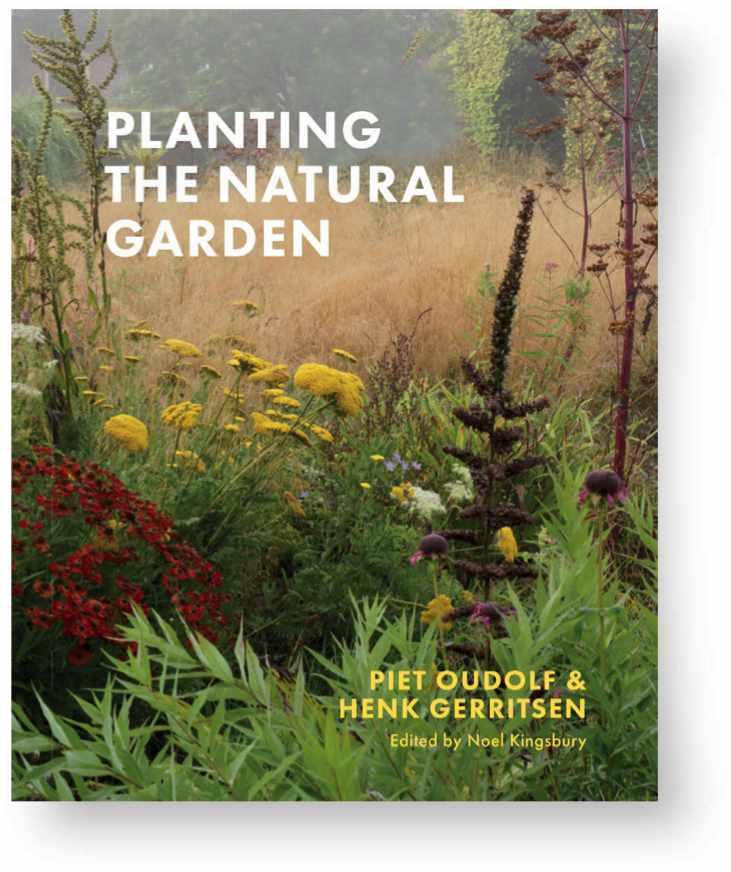
PLANTING THE NATURAL GARDEN
by Piet Oudolf and Henk Gerritsen
Timber Press (2019)
ISBN 978-1604699739

by Olivier Filippi
Filbert Press (2019)
ISBN 978-1999734558

VEGETABLES: THE DEFINITIVE GUIDE FOR GARDENERS
by Roger Phillips and Martyn Rix
Macmillan (2021)
ISBN 978-1529063295
You could choose from many excellent books by the perennial innovators Piet Oudolf, Henk Gerritsen and Noel Kingsbury, but this reissued version of the 1990s classic still has so much to offer. It was a book that opened up a new palette of perennials to the gardening public, with its beautiful photography, plant descriptions and empowering sense that you too could make an artistic combination with the ingredients and wisdom from the pages.
Henk Gerritsen’s dry sense of humour makes you feel like you are walking around the nursery with him, heeding warnings as to a plant’s seediness and soaking up a lifetime of know-how about what works well together.
This edition includes additions to the plant list reflecting new cultivars on the market and the development of Piet Oudolf’s designs. It is a generous book: there are planting plans and the ever-handy list of how many perennials to use per square metre.
As our climate changes, plants are going to face either too much water or too little.
Olivier Filippi has been a trusted voice on dry gardening for many years, inspired by the beauty of Mediterranean landscapes and working with his wife Clara to run their nursery in the South of France.
This handbook explores the mechanisms that have evolved in plants from Mediterranean climate zones to survive drought. It explains the relationship between soil type and moisture availability and provides informative profiles on recommended species.
A strong root system is vital for a plant living in tough conditions and useful diagrams illustrate the effect of pot cultivation on a root system, or how roots develop in accordance with the kind of watering they are given during their first summer.
Olivier Filippi encourages us to work sustainably within the natural conditions of our gardens, to be open to experimentation and willing to let a struggling plant go.
Roger Phillips’ and Martyn Rix’s books have been favourites on the potting-shed shelves of nearly every garden I have worked in. Their bright style with clear, colour photos, often isolated against a white background, gives them a trusted format that you can turn to reliably.
This reissued book on vegetables isn’t so much about how to grow them, but presents these edible objects as the offspring of wild plants that humans have bred for thousands of years.
As well as origin and history, this edition celebrates the cultivar, with photos of good varieties next to each other, so that you can see just how pea ‘Hurst Green Shaft’ differs from pea ‘Kelvedon Wonder’, and it makes you want to grow them all.
Their books give me the same feeling that I get when meandering around a good DIY store, with all the separate building components organised in distinct categories. There’s a sense of endless creative possibility in the myriad things that you could grow or cook from these pages.
There’s a sense of endless creative possibility in the myriad things that you could grow or cook from these pages


Head to gardensillustrated.com for more exclusive content on gorgeous gardens and the best seasonal plants. You’ll also find the latest horticultural news and details of upcoming events – plus podcasts, offers and competitions, and a wealth of inspiration
February is the month for galanthophiles to venture out and admire snowdrops. We round up the best displays. 10 exciting new trends in gardening
Stay abreast of this year’s most dynamic new horticultural trends, from open-air sitting rooms to sand gardens.
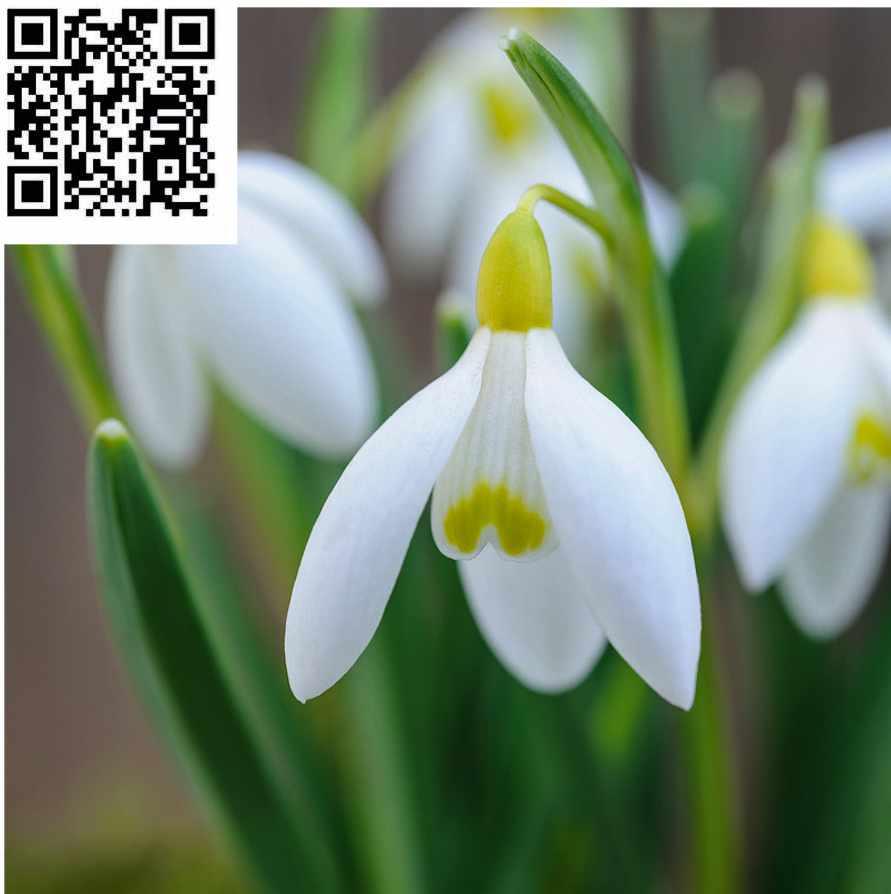




which taste great and are good for you we believe in simple, whole foods


5 S %



The Grade II-listed, four-silverstar Alverton Hotel is a former convent set at the heart of the cathedral city of Truro. Enter our competition and you could win a luxury break for two, including sampling exceptional Cornish cuisine at the hotel’s award-winning restaurant.
The winner plus one guest will enjoy two nights in a stunning Courtyard suite – complete with a copper roll-top bath – plus a hearty breakfast each morning, and an indulgent three-course dinner on one evening.
The competition prize* also includes tickets to visit the Lost Gardens of Heligan, which were rediscovered and restored, and are now one of the most loved gardens in the UK.
Even if you don’t win our competition you can still save on The Alverton’s Cornish Spring Getaway, paying from £149 per couple per night for four-silver-star accommodation and full Cornish breakfast, plus a choice of two house drinks or a mini Cornish cream tea for two. You can also extend your stay for the same room rates.
The Alverton has character and charm, with a bell tower, original flagstone flooring, stained-glass windows, ivy-clad walls and stunning archways uncovering hidden hideaways, making each stay a real experience. The 53 en-suite bedrooms, including garden-view rooms and unique suites complete with luxury furnishings, provide ample space to relax and recharge. Individually designed and full of character, you can expect bespoke touches, king-sized beds, wide screen TVs and original features.
In the evening, dine in the cosy, awardwinning restaurant overlooking verdant lawns and stately trees, with menus created from the finest Cornish ingredients. The Alverton is also perfectly situated for exploring Cornwall’s capital and visiting the region’s many gardens.
For details or to book, call 01872 276633, quoting Gardens Illustrated, or visit thealverton.co.uk/special-offers/cornishspring-getaway/
To enter, scan the QR code above with your phone’s camera or go to: gardensillustrated. com/alvertonhotel
Gardens Illustrated is offering readers the chance to win a two-night stay at The Alverton Hotel.
For one winner and their guest, the prize (worth £1,050) includes:
• Two-night stay in a Courtyard suite at The Alverton Hotel with breakfast
• Three-course dinner for two one evening
• Two tickets to the Lost Gardens of Heligan
For your chance to win, answer the following question correctly:
Which of these well-known gardens is not in Cornwall?
a) The Eden Project
b) Lowther Castle
c) The Lost Gardens of Heligan
Enter online at gardensillustrated.com/alvertonhotel
Closing date 11.59pm, 1 March 2024
Terms and conditions The Promoter is Our Media Limited (company number 05715415). Entrants must be UK residents, aged 18 or over. *Prize, based on two adults sharing a Courtyard suite, is valid for six months from the date of nomination (the date the winner is notified), excluding Easter and Bank Holidays and subject to availability. **Offer (based on two sharing a Classic room) is valid from 1 April until 5 June 2024, subject to availability. Upgrades are available for a supplement. New bookings only and not to be used in conjunction with any other offer.
Make time in the new year to visit this collection of stunning gardens
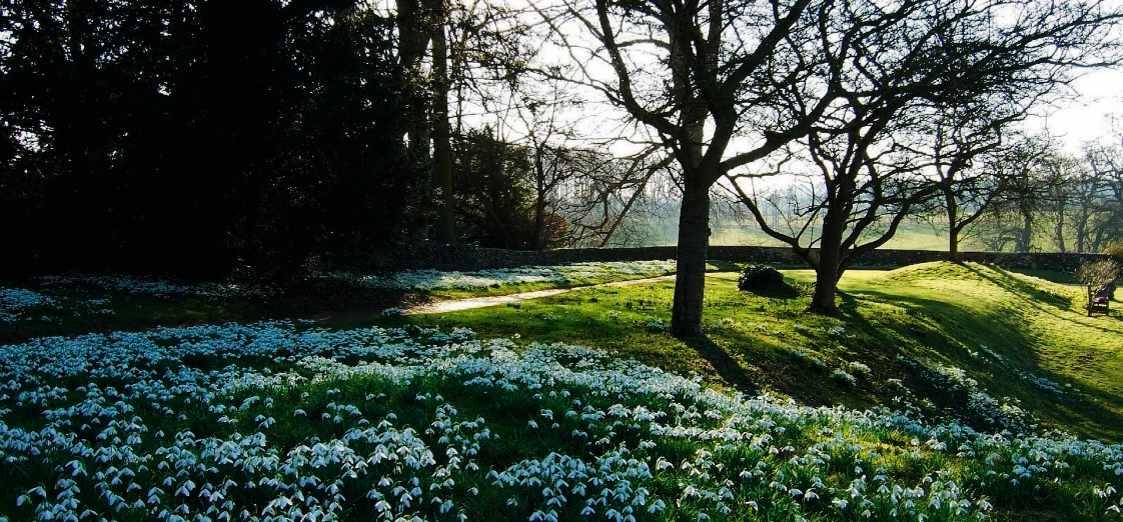
Celebrate the arrival of spring with a walk around the historic ruins that serve as a backdrop to the spectacular display of naturalised snowdrops. A named collection of rarer snowdrops is displayed in borders and the walled garden. Tea room and gift shop. Open daily 3-25 February, 11am-4pm. Nr Stevenage SG2 7BS | beningtonlordship.co.uk

Noted for its vast swathes of snowdrops, hellebores and aconites, a succession of spring bulbs and blossoms, deliciously scented daphnes and viburnums and a crescendo of daffodils. 40-plus acres of formal and woodland gardens. RHS Partner Garden. See website for opening dates and times. Ely, Cambs CB7 5PT | chippenhamparkgardens.co.uk

4THE LASKETT
This remarkable year-round garden brings a biographical celebration of the arts to the Herefordshire countryside. A celebration of tulips proudly proclaims the arrival of spring. Summer makes a grand entrance with fantastic vistas. Theatrical topiary and architecture take centre stage in autumn. Much Birch, Herefordshire HR2 8HZ | 01432 805454 | thelaskett.org.uk

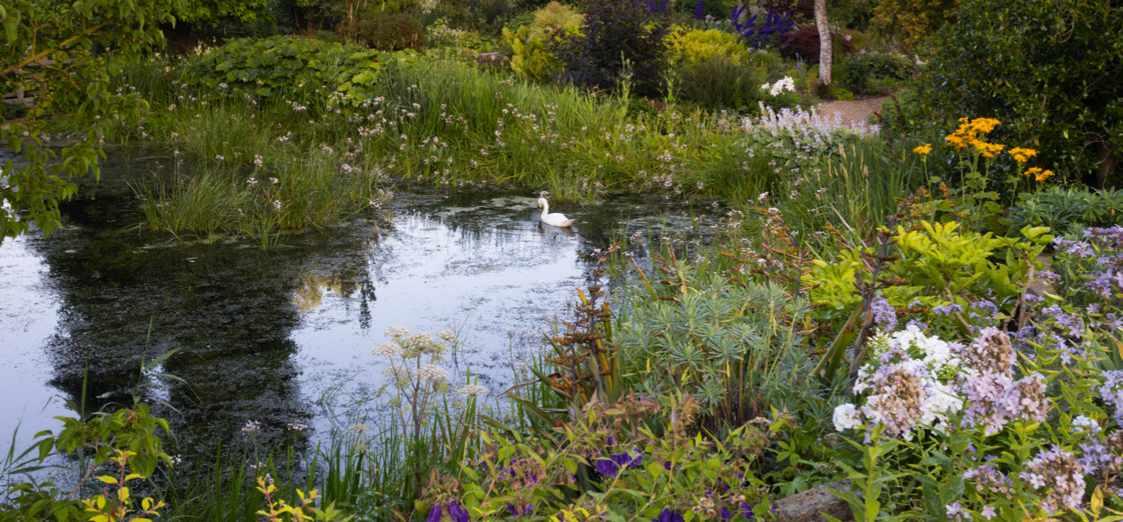
This award-winning garden offers unusual shrubs, perennials, lilies and marginal plants. Fresh with growth in spring, lilies begin a succession of flowering, creating a spectacular show of colour into summer. Golden hues illuminate autumn days and streams sparkle in winter as snowdrops awaken. West Stow, Bury Saint Edmunds IP28 6HD | fullersmill.org.uk

5
KINGSTON BAGPUIZE HOUSE
Explore the garden, parkland and copses surrounding this family home and enjoy the naturalised snowdrops and winter flowering shrubs every Sunday and Wednesday in February 1pm-4pm. Refreshments available. Snowdrop & Plant Fair: Sunday 25 February 11am-2pm. Nr Abingdon OX13 5AX | 01865 820259 |
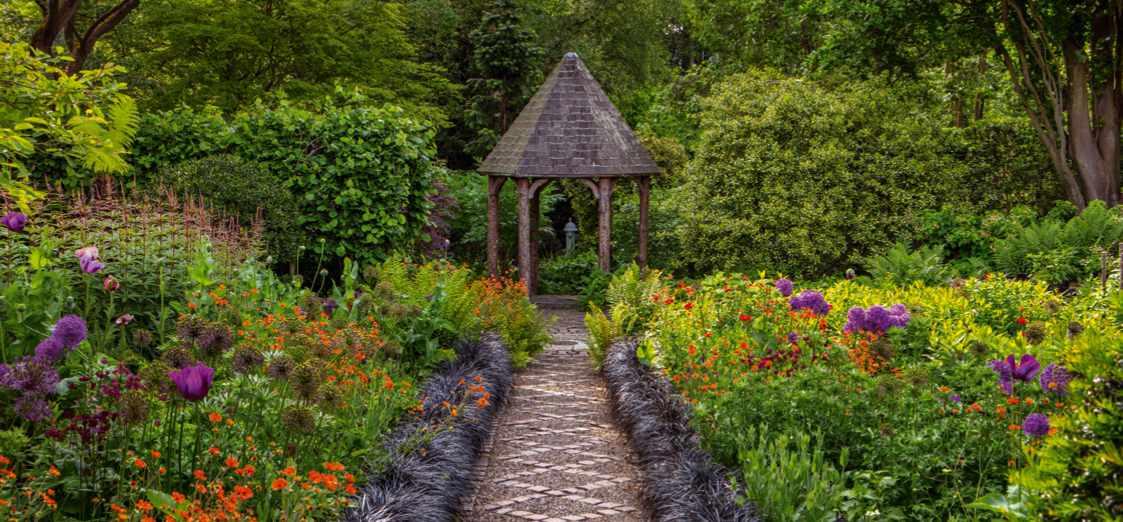
This magical garden is brimming with garden rooms inspired by the arts and crafts movement. Colour bursts to life in spring and summer displaying tulips, tropical plants and wildflowers. Timeless structure draws the eye in autumn and winter with a masterpiece of pattern, topiary, and a finale of snowdrops. Leeds, West Yorkshire LS16 8DW | 0113 2678240 | yorkgate.org.uk
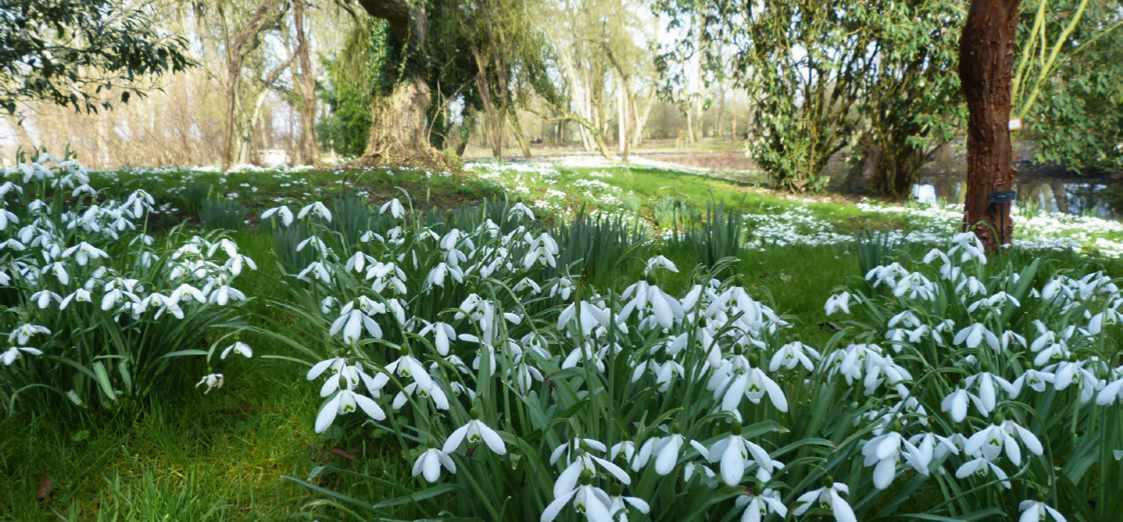
Celebrate Snowdrop Season and the first signs of spring, with over 60 different snowdrop varieties carpeting the ornamental gardens over the season. Come and enjoy a walk around the gardens to see these little heralds of spring in a magical setting. A place to explore, relax, and shop in beautiful surroundings all year round. Nr Wheatley, Oxfordshire OX33 1LA | 01844 339226 | waterperrygardens.co.uk
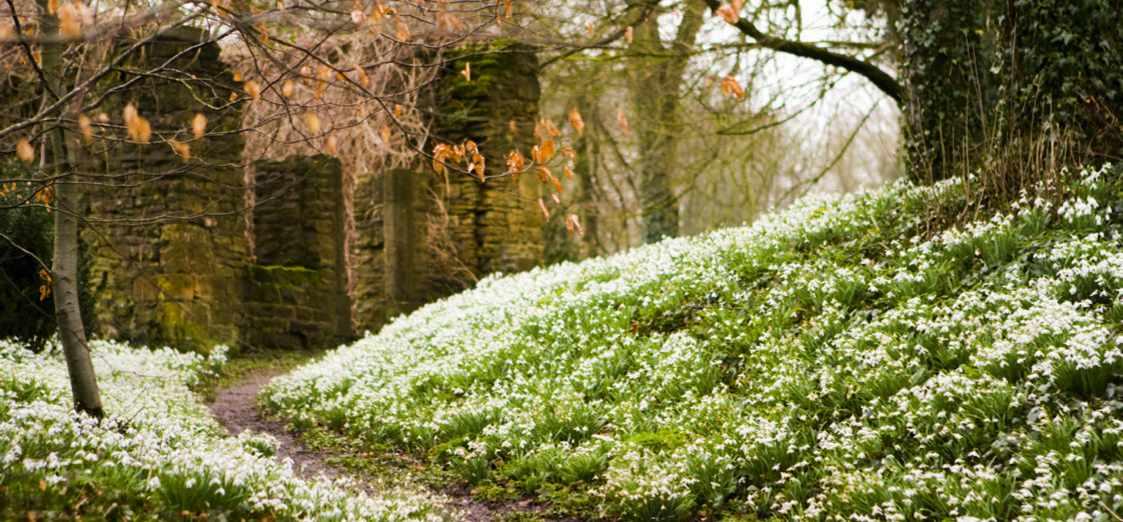
10
CERNEY HOUSE GARDENS
Cerney House gardens is a romantic English garden, with a beautiful secluded, Victorian, walled garden. The late-winter season features snowdrops and hellebores. Enjoy our woodland walk and nature trail, and discover our medicinal herb garden and children’s trail. Dogs welcome. North Cerney Cirencester GL7 7BX | 01285 831300 | cerneygardens.com
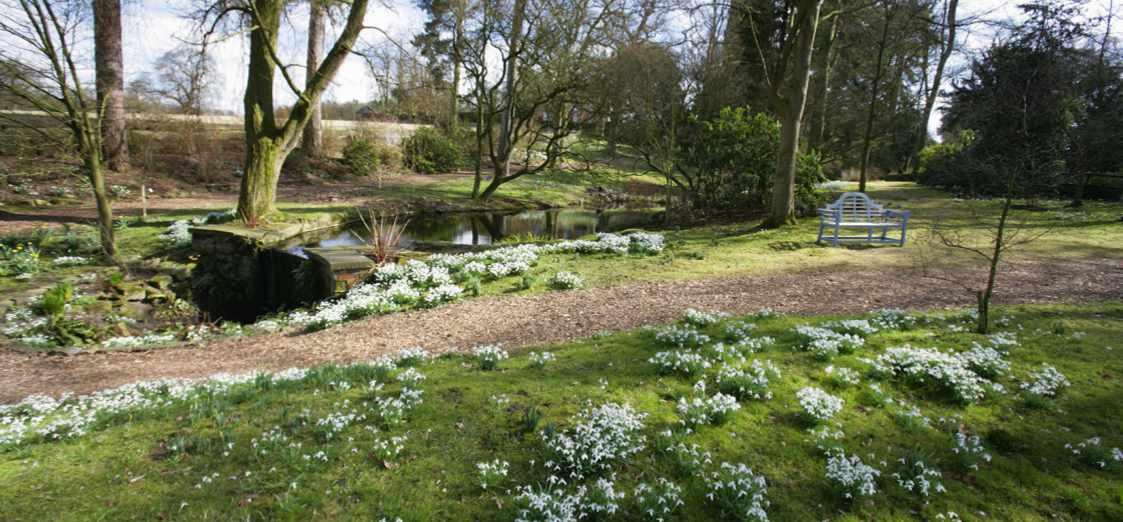
Enjoy one of the UK’s finest Snowdrop Walks at Rode Hall & Gardens in Cheshire to mark the start of spring with over 70 varieties of snowdrops. Homemade soups, cakes and drinks served in the delightful courtyard kitchen. Tickets available online. Saturday 3 February to 2 March, Thursday-Sunday 10am-4pm. Scholar Green, Cheshire ST7 3QP | 01270 873237 | rodehall.co.uk
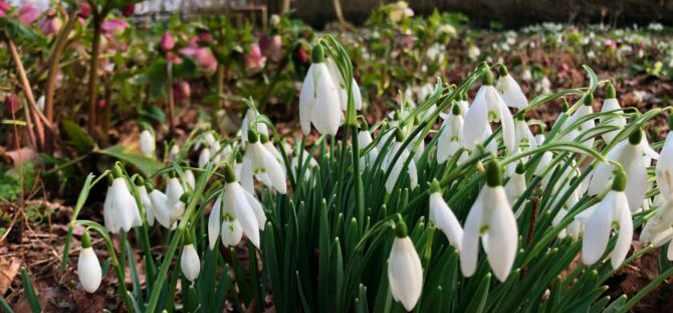
9
SHEPTON SNOWDROPS FESTIVAL 2024
Festival highlights include snowdrop, bulb and plant sales from RHS awardwinning nurseries, seed swap, open gardens, talks, workshops, artisan market, art and poetry installations. Free snowdrop and nature-themed creative activities and drama workshops for children and families.
Shepton Mallet, BA4 5AZ | sheptonsnowdrops.org.uk

11
CAMBRIDGE UNIVERSITY BOTANIC GARDEN
Over 40 different species and cultivars feature in our free Snowdrop Trail which guides you around the Garden. Learn more about the varieties we cultivate, pick up expert tips on how to grow these delicate delights and delve into snowdrop science, history and folklore.
Cambridge CB2 1JE | 01223 336265 | botanic.cam.ac.uk




Are you looking to change career, gain accreditation or simply learn more about your passion? Choose the best option for you from this selection of full-time, part-time and short courses.

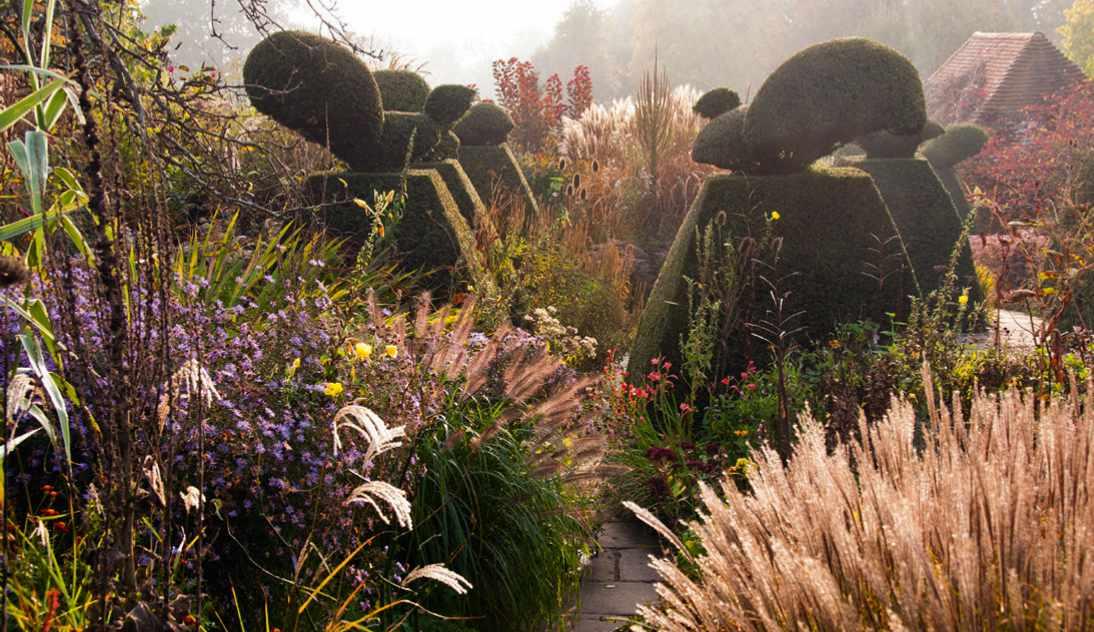

Each study day is made up of a mixture of indoor lectures and demonstrations within the garden. Fergus is an inspiring teacher, always going the extra mile to make sure that you get the most out of your day’s learning. Refreshments and lunch are included with lunch served in the beautiful Great Hall, one of the largest timber framed hall houses left in the country today, a treat in itself. There is a 10 per cent discount for
attendees on plant sales in the nursery and in the shop on the day. Great for all ranges of gardening knowledge. £180 per person.
COMING UP
26 February 2024 – Succession planting in the mixed border. Fergus will illustrate how you can create a long-season border with succession planting. Examining the garden in February gives you an
opportunity to see the gaps and learn how to fill them.
25 March 2024 – Designing with plants study day. This study day will teach you how to combine plants using colour, shape, texture, repetition and balance.
education@greatdixter.co.uk greatdixer.co.uk




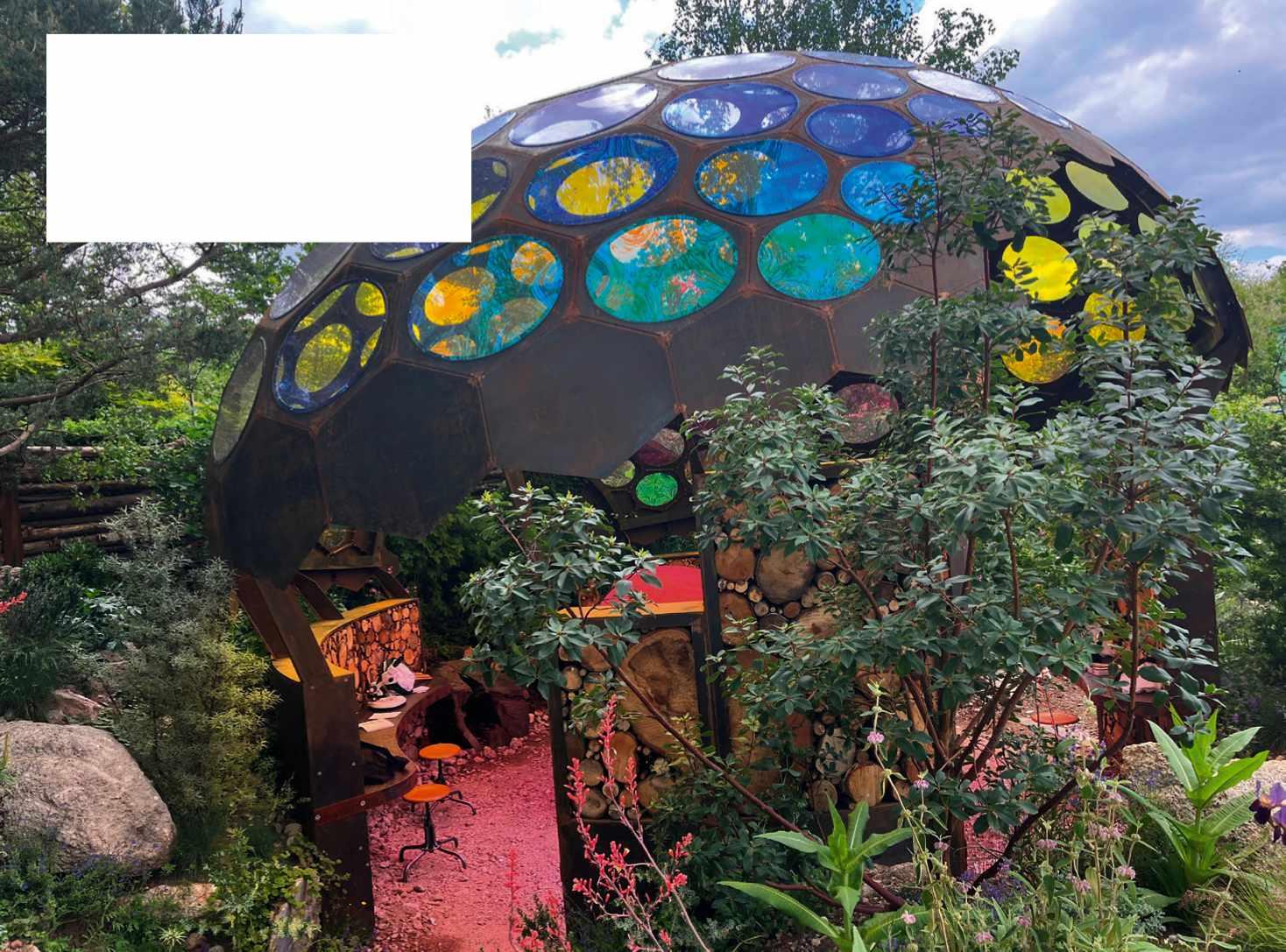
Inspiring courses for the garden professional
Widely regarded as one of the world’s leading garden design colleges, the London College of Garden Design has a wide range of courses for those aiming to start a career in garden design and continuing professional development for experienced designers.
Our one-year Garden Design Diploma led by Andrew Wilson welcomes students both in-person at the Royal Botanic Gardens, Kew, and in real-time online classrooms. We offer an exciting and often demanding environment that teaches not just the fundamentals of design but also develops skills in planting and construction design and running your own successful garden design studio.
Every class is taught by expert tutors who are all practising professionals and we ensure that our students get the opportunity to take part in inspirational visits and free graduate seminars. And if you are in Australia or New Zealand you can join this course with our partner college in Melbourne.
Our students have won the majority of Society of Garden Designers Student Awards since they began and regularly graduate to work for some of the world’s leading designers and win major awards
for themselves. Our free graduate programme gives you extra training opportunities and the chance to design gardens in prestigious locations.
There are a wide range of opportunities to develop your career through our other extended courses. Our six-month intensive Planting Design Diploma is led by Nina Baxter with the involvement of some of the world’s leading planting specialists. We also offer a certificate programme in Construction Design to help you enhance your career prospects. These are also available online in real-time classrooms or in blended learning formats. To find out more download a prospectus from our website.
We also offer short courses at Kew Gardens and in conjunction with the Royal Horticultural Society at RHS Garden Wisley. All of these courses aim to be suitable for both professionals and the garden enthusiast, and include subjects such as design drawing skills, designing your own garden and seasonal planting design.
info@lcgd.org.uk 01483 762955 | lcgd.org.uk



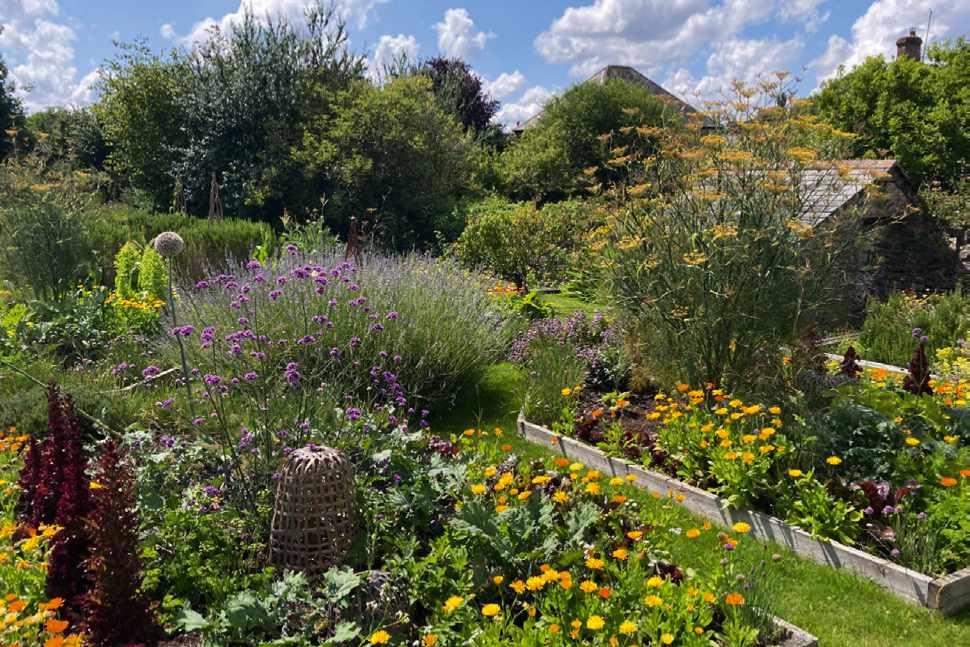

Learn how to make your own beautiful, wildlife-friendly garden and grow food in tune with nature
Located in the peaceful South Devon countryside The Sustainable Garden is bursting with biodiversity, bees and birdsong Oneday courses are taught here by Charlotte Parton, whose careers in garden design and nutrition led to a post grad in Sustainable Food & Natural Resources Students learn on Charlotte’s own
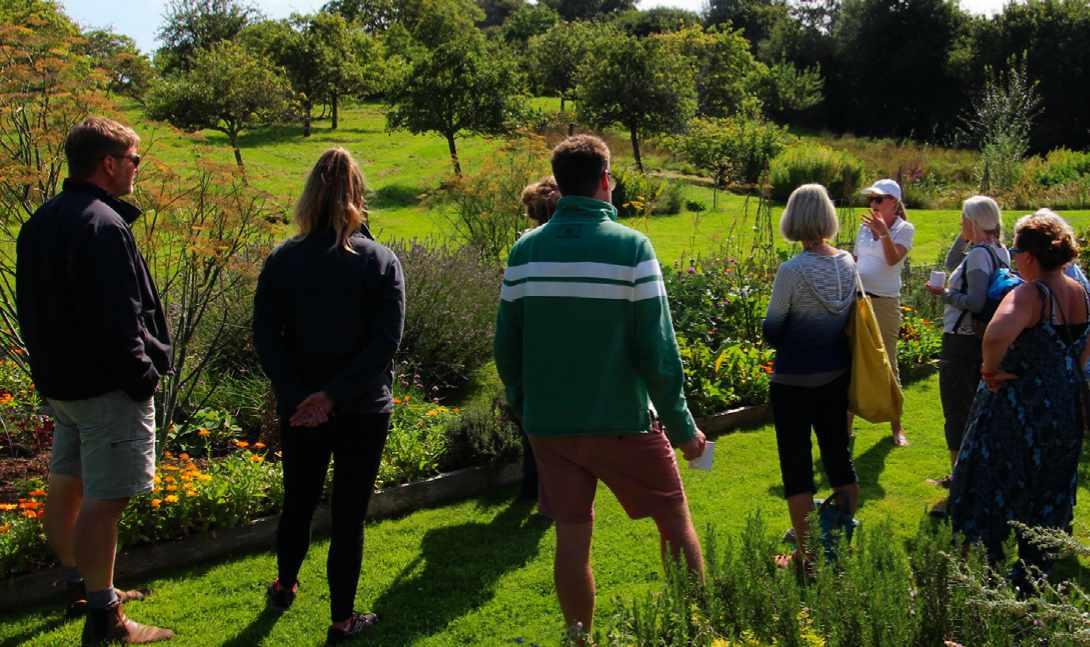
smallholding, which includes a ‘potager’ style vegetable garden, ancient apple orchards, a wildflower meadow and a nature pond
Upcoming courses include: How to Create A Sustainable Garden: Biodiversity for Beginners (May 11)
The English Potager Garden: Growing Sustainable Food with Style (June 1, June 29 and September 7)
“The course inspired me to plant an abundance of annual and perennial crops, flowers & herbs The bee population has exploded and we have been eating from it all summer ”
Info and booking: thesustainablegarden.com

Welcome to the only garden design course in the UK to follow the growing year of January to December
By the time the four seasons pass, you will have a rich grounding in creative, landscaping, gardening, design and business skills –and an excellent entry point into the industry


September 2024 – beginning July 2025
Covers the best in planting design while training in the more serious aspects of horticultural techniques. Practical sessions held at Arundel Castle under the guidance of head gardener Martin Duncan and at Sandhill Farm House, Rogate. Lectures by many leading gardening personalities and regular visits to outstanding private gardens. Students also learn to draw up planting plans.
(1 day a week (Tues), 10.30am–3.15pm, over three terms)
GARDENING FOR BEGINNERS
4 days Wednesday & Thursday 17/18 April & 24/25 April 2024
One of our most popular courses, led by master horticulturist Ben Pope, which aims to take each student through all the practical elements of caring for a garden from soil, tools, maintenance, seed sowing and propagating, weed control and pests and diseases.The first 3 days will be spent with lectures at the Chelsea Physic Garden and the final day will be spent gaining practical experience in Rosemary Alexander’s much praised garden near Petersfield and another private garden nearby, where Ben is in charge. Participants will be given a chance to prune, plant, sow seeds and regular maintenance tasks will be discussed. A light lunch and refreshments will be provided daily.
THE ESSENTIAL GARDEN DESIGN DIPLOMA
January – March 2025
Based at the Chelsea Physic Garden and led by Rosemary Alexander and architect Catriona Rowbotham, the course is an overview of Garden Design, covering all the elements needed to rethink an average garden.Taking students step by step through site surveying, using the grid, horizontal and vertical features, garden layouts and planting plans, costing and specification, plus drawing tuition and homework on design and plant portfolios.Tutors are well respected in the industry and will guide students on how to succeed in this diverse profession. (2 days a week (Wed &Thu), 10.30am–3.15pm, plus 2 days homework)
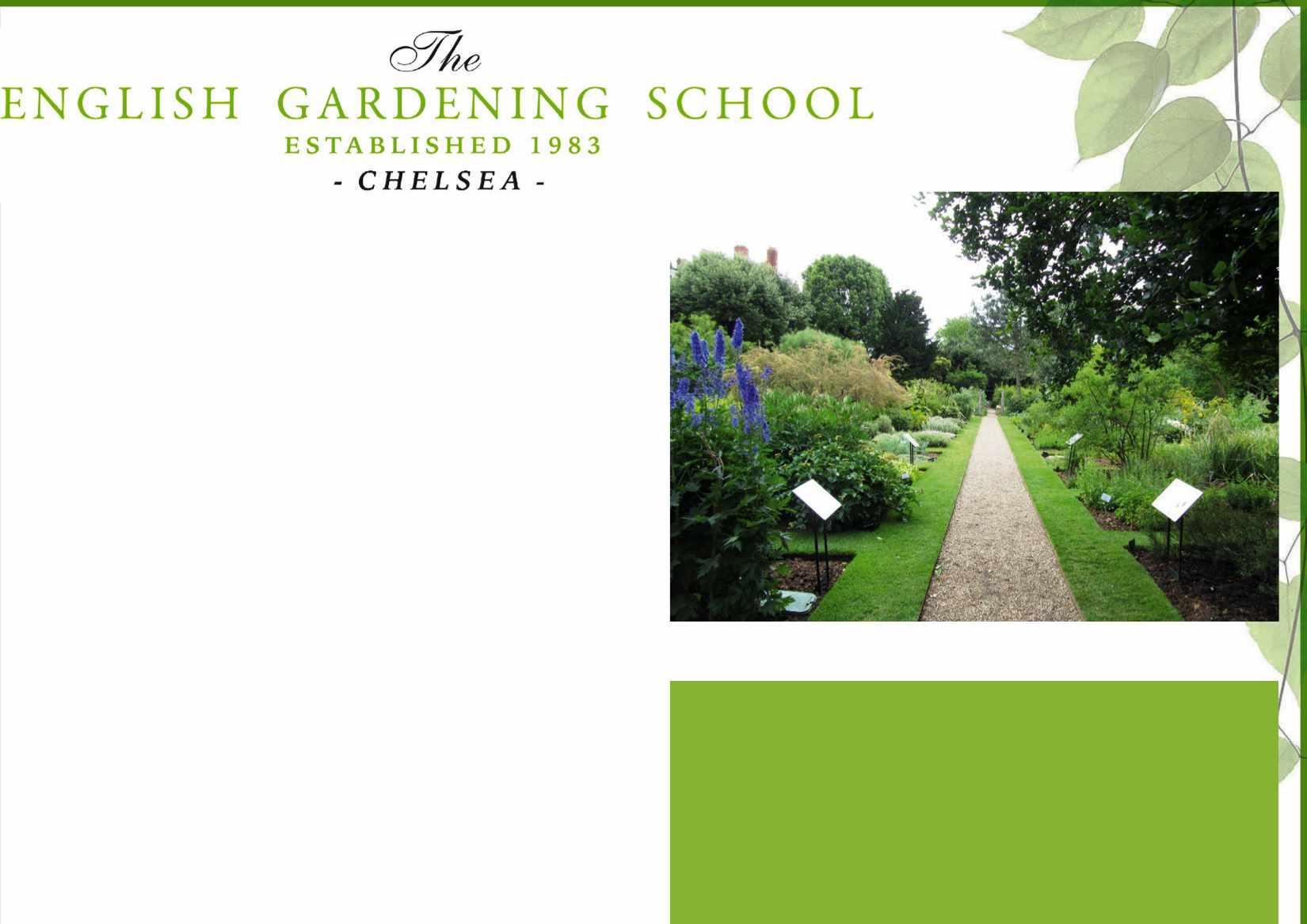
GARDEN DESIGN & CARING FOR YOUR GARDEN
Distance Learning Courses study anytime, anywhere in the world
A stepping stone to a new career.These two correspondence courses are a step by step guide to either designing your own garden or learning how to plant and maintain an existing garden: drawing up plans, hard landscaping, site analysis, planting, month by month tasks etc.Taught through a comprehensive course book, with projects submitted to us. (1-3 years to complete and individual assessment)
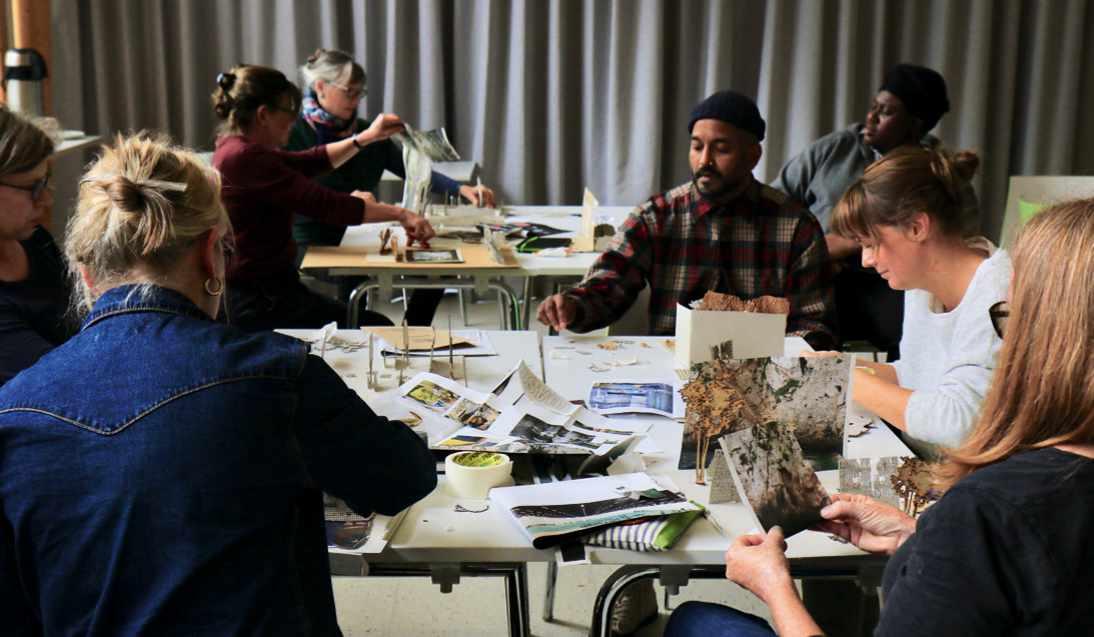
Not sure which Diploma course is for you?
We prefer potential students to attend an Information Session when Rosemary explains the course and you can see our work space.
JUST CONTACT US TO SET UP A DATE & TIME
www.englishgardeningschool.co.uk
Email: info@englishgardeningschool.co.uk Tel: 01730 818373
Long established as the leader in gardening tuition
Based at the unique and historic Chelsea Physic Garden


Garden Masterclass is Annie Guilfoyle and Noel Kingsbury and we offer a unique education portal for garden and landscape people.
• We seek out experts and innovators, whether well-known or waiting to be discovered. We organise live one-day workshops in gardens across the British Isles.
• We have over 80 hours of recorded webinars, 200 hours of free public viewing along with 100 hours viewing exclusively for our members.
• Many of our workshops are recorded, allowing others to share in the experience.
• We produce educational webinars, recordings are available from our website.
• We commission films about exceptional gardens and their creators.
• Our membership scheme (which includes students) offers discounts on webinars and recordings and access to an extensive online library.
• Some of what we do is free! Thursday Garden Chat is our weekly public service broadcast at 6pm London time. All are recorded for YouTube and website viewing.
gardenmasterclass@gmail.com gardenmasterclass.org

A generation ago, a woman named Sylvia made a promise. As a doctor’s secretary, she’d watched stroke destroy the lives of so many people. She was determined to make sure we could all live in a world where we’re far less likely to lose our lives to stroke.
She kept her promise, and a gift to the Stroke Association was included in her Will. Sylvia’s gift helped fund the work that made sure many more of us survive stroke now than did in her lifetime.
Sylvia changed the story for us all. Now it’s our turn to change the story for those who’ll come after us.
Stroke still shatters lives and tears families apart. And for so many survivors the road to recovery is still long and desperately lonely. If you or someone you love has been affected by stroke – you’ll know just what that means.
But it doesn’t have to be like this. You can change the story, just like Sylvia did, with a gift in your Will. All it takes is a promise.
You can promise future generations a world where researchers discover new treatments and surgeries and every single stroke survivor has the best care, rehabilitation and support network possible, to help them rebuild their lives.
Will you make that promise to generations to come? Please, leave a gift in your Will to the Stroke Association.
Find out how by calling 020 7566 1505 or email legacy@stroke.org.uk or visit stroke.org.uk/legacy

ACROSS
8 Primula vialii’s purple flower spikes are ___-shaped, like the red ones of Kniphofia (5)
9 Perennials with attractive foliage and panicles of small flowers –making gorse arid (9)
11 Tin… found in the central part of Calycanthus! (3)
12 RHS seal of approval for a reliable plant (abbrev) (3)
13 Plant in Actaea genus, with bottlebrush-like flowers, or baneberry (7)
14 Citrus trees – some sublime species! (5)
16 Honour awarded Tom StuartSmith in 2023 for services to horticulture (3)
17 The mallow genus – in formal vase (5)
18 Eg black spot or mildew (7)
20 Related to plant study – BBC’s first action broadcast (7)
22 Having a point, like the flavour of lemon? (5)
23/27 down Delicate-flowered, native prickly shrub with ovoid red hips in autumn (3,4)
24 Miscanthus sinensis ‘____’ with reddish inflorescences turning silver; and west African country (5)
25 Organic? It’s intuitive! (7)
26 A decorative yellow dahlia striped with red – unusual one (3)
27 Rosemoor and Harlow Carr are two of its gardens (3)
28 Genus of plants called granny’s bonnets and columbine (9)
29 Leaves of this agave yield a fibre for rope… possibly sails? (5)
DOWN
1 Mottled, like the leaves of the polka dot plant (8)
2 A fruit’s epicarp (4)
3 Sweet ___, common name for eglantine roses – libraries revised (no lie!) (6)
4 Spring flower – after evening it’s of a different genus (8)
5 Parts of day lilies, sunflowers, etc are… as consumers will confirm! (6)
6 Fragrant herb of Monarda genus –Meg to bar production (8)
7 Glossy-leaved shrub with small pink flowers – reinvented as one lilac (10)
10 Care about a… palm, the popular (though incorrect) name for the indoor plant Chrysalidocarpus lutescens (5)
15 Ornamental grass commonly called eulalia grass – isn’t as much sadly! (10)
19 orientalis, with spring-green foliage and small blue flowers – ‘USA pearl’ maybe (8)
20 Flamboyant, profuse-flowering plants – so I began to move (8)
21 Genus of succulent plants aka jade plant – 5/8ths is unrefined! (8)
22 Compact tangerine sunflower with long laterals, bred for cutting – Jason re-arranged (5)
23 Torrential rain… battered guelder, endlessly (6)
24 Complain… it’s a vigorous, groundcover, pale-pink rose (6)
27 See 23 across
• Solutions to this issue’s crossword will be printed in the
You can buy printed issues of the magazine published up to six issues ago at ourmediashop.com or see below for details.
Save money when you subscribe to the digital edition –see page 18


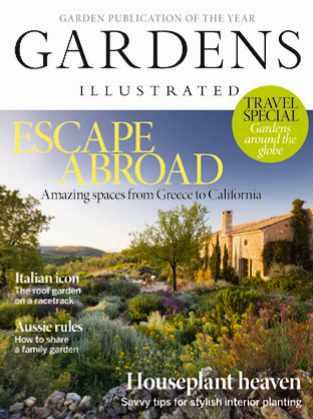

Cost from £9.99 each (inc p&p). Member discounts available – see below for details.

Annual labelling is a thing of the past with Alitags. Simply write on Alitags aluminium labels with HB or Alitag pencil. The pencil will react with our specially made aluminium tags and become permanent.
Alitag labels can also be punched with Alitag character punches & jig.
Copper, Teak, Bamboo labels are also available.
• New ideas for bringing the outside in
• Our new series through the year at Sissinghurst with head gardener Troy Scott Smith
• New plants of the month series from Lowther, plus the new plants experts will be growing this year
maryalice2206-207 tif <No data from link>
• New gardens: Jo Wakelin’s New Zealand plot and Andy Sturgeon’s Battersea Power Station roof garden designs PLUS Nigel Slater’s new monthly column; the best daffodils, bergenias and magnolias to grow

Save money when you subscribe to the digital edition – see page 18. Also in selected Waitrose, Sainsbury’s and Tesco stores, as well as WHSmith, and all good magazine retailers.
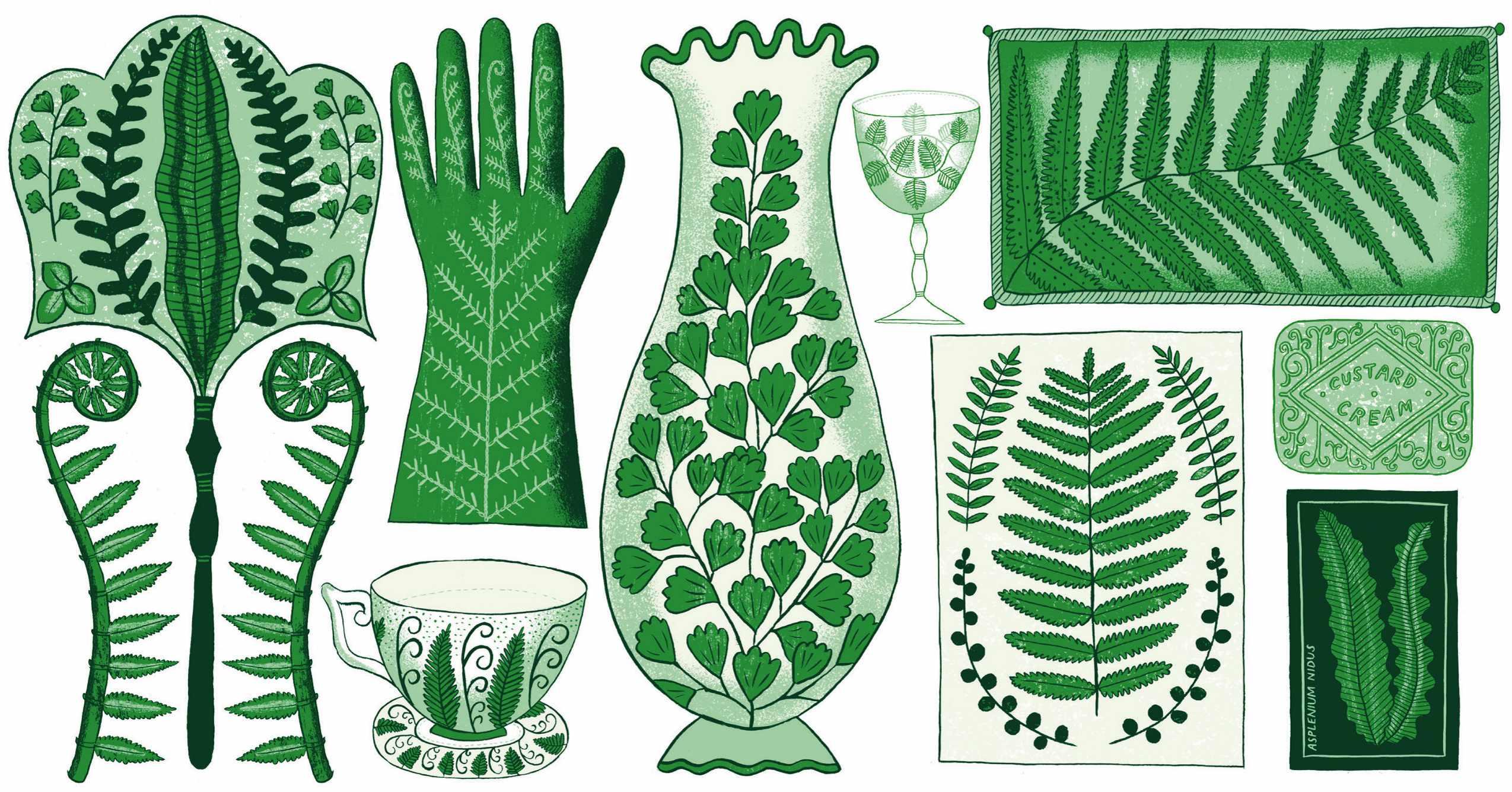
Self-confessed pteridomaniac Alice Vincent has long been fascinated by ferns and has grown to love the serene, green beauty they bring to the garden
ILLUSTRATION ALICE PATTULLO
Iremember the first time I walked into the RHS Lindley Library. It was cold, so it must have been winter, and the trees of London’s Vincent Square were playing with the light through the building’s tall windows. I felt woefully out of place walking over that beautiful mosaic floor, but the librarians just smiled and nodded towards the entrance.
I was there to look for a particular book –Sarah Whittingham’s Fern Fever: The Story of Pteridomania. And there it was on a shelf, neatly filed with its Dewey system sticker. I was researching my own book at the time, looking at how different generations came to find their own way to plants, while exploring my own nascent fascination with them. I was done with Whittingham’s excellent book within a few days, but I returned to Vincent Square to research and then write in the months that followed. Fast-forward a few years and a copy of my own book appeared in the Lindley Library, back where it began.
I wanted to find out – and write – about pteridomania, the Victorian craze for ferns that saw them embroidered on to dresses and printed on to cushions, painted on ceramics and meticulously etched into custard cream biscuits (they’re still there,
those little curlicues). I was undergoing my own ferny fascination. I wasn’t rampaging around the country with a little trowel and a collection box, as did so many middle-class women in the 19th century, destroying swathes of biodiversity in the process, but I did fill my balcony with them. One latesummer day, I even got the delicate leaves of a maidenhair fern (Adiantum raddianum) inked on to the inside of my bicep.
That was seven years ago and I’ve still no regrets – about the tattoo or becoming a pteridophile. The adiantums live in the garden now; A. venustum is a resilient little thing, pushing on through the seasons.
The affectionately named, formerly indoor, Princess Maidenhair Fern V (the numeral should tell you how tricky they are to keep alive in British homes) finally succumbed to life outdoors and its pot now houses foxglove seedlings. Those ferns that filled my balcony now stand by my back door, still in the same containers. They’ve been divided endlessly and scattered around.
It took me a while to accept that happiness lay in simply putting more ferns in the garden. When we moved from our flat to a house, I devoured the plant catalogues, and tried growing dozens of things I hadn’t
previously had the space for, and had coveted on other gardeners’ Instagram accounts. A kind of existential, dahlia-filled crisis ensued. After a dismal, mollusc-filled summer, I realised I’d overlooked the most crucial part of making a garden: growing your favourite plants. So I ordered a luckydip box of five different ferns from peat-free grower Penlan Perennials, and set about planting them. They thrived, filling up and fronding out and helping to create the calming layers of green texture and movement that I cherish most in a garden.
Admittedly, February isn’t the ideal time to do much to ferns. I only grow hardy types, and if they’re deciduous, their nascent beauty is still tucked beneath rusting fronds. We must wait for May, when new fiddleheads appear from the fluffy, brown casings at the crown of the plant. It is one of my mostloved gardening moments of the year.
When we landscaped last year, I saved the ferns, not fully knowing where they would end up. But once the dust had settled, I realised we’d unintentionally made space for them in a light-dappled corner by the studio. Here, I began to plant all the divisions and previously potted things. Finally, a fernery of my own. ■

For over 95 years, APT have been creating best-in-class cruises to the world’s most inspiring destinations. It’s the attention to detail and personalised service that make our award-winning river and small ship cruises totally unforgettable. We take cruising to a different level, so you can enjoy a seamless and carefree holiday with everything included. Book today to take advantage of our Worldwide Sale and save up to 50%* on bookings made before 29 February 2024.

TIMELESS CLOTHING & EQUIPMENT TO CARRY YOU THROUGH THE SEASONS carriercompany.co.uk always made in the uk